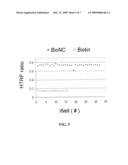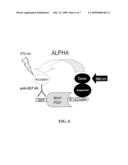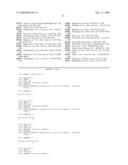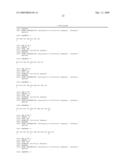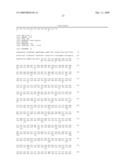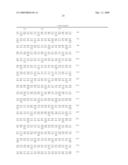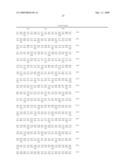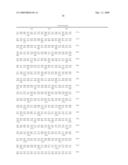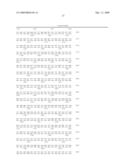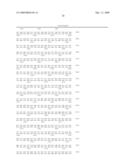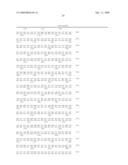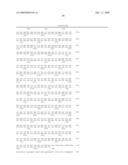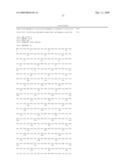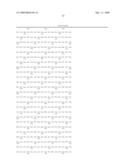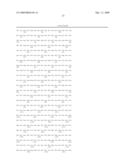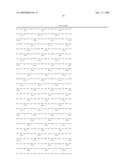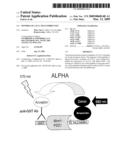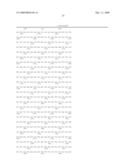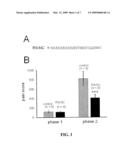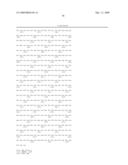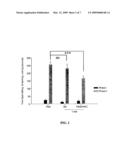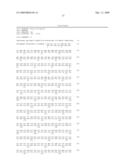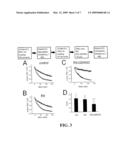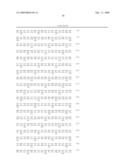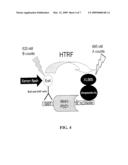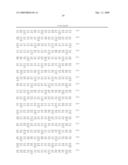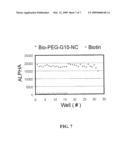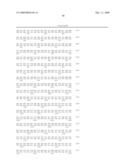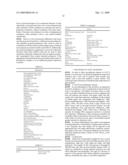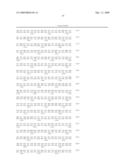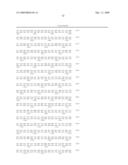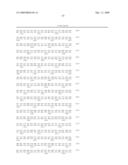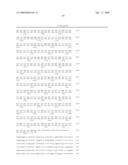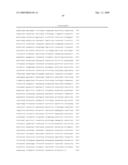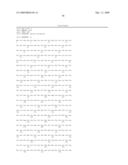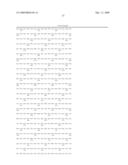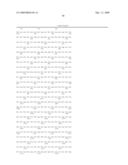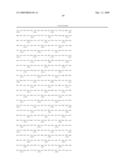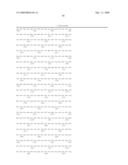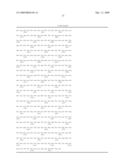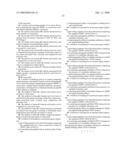Patent application title: PEPTIDES OF CAV2.2 THAT INHIBIT PAIN
Inventors:
Mary Garry (Dallas, TX, US)
Ilya Bezprozvanny (Dallas, TX, US)
IPC8 Class: AA61K3576FI
USPC Class:
424 932
Class name: Drug, bio-affecting and body treating compositions whole live micro-organism, cell, or virus containing genetically modified micro-organism, cell, or virus (e.g., transformed, fused, hybrid, etc.)
Publication date: 2009-03-12
Patent application number: 20090068148
Claims:
1-19. (canceled)
20. A nucleic acid encoding peptide of 4 to about 50 residues comprising the sequence DHWC or conservative variants thereof operably linked to a promoter.
21. The nucleic acid of claim 20, wherein said promoter is tissue specific or constitutive.
22. The nucleic acid of claim 20, wherein said promoter is selected from the group consisting of CMV IE, RSV, and SV40 large T.
23. The nucleic acid of claim 20, wherein said nucleic acid further comprises a polyadenylation signal.
24. The nucleic acid of claim 20, wherein said nucleic acid is located in a viral vector.
25. The nucleic acid of claim 24, wherein said viral vector is selected from the group consisting of retrovirus, adenovirus, adeno-associated virus, vaccinia virus, herpesvirus and polyoma virus.
26. The nucleic acid of claim 20, wherein said nucleic acid is comprised in a non-viral vector.
27. The nucleic acid of claim 26, wherein said non-viral vector is comprised in a lipid vehicle.
28. The nucleic acid of claim 27, wherein said lipid vehicle is a liposome.
29. The nucleic acid of claim 20, wherein said nucleic acid further encodes a permeant protein delivery motif fused to SEQ ID NO:1.
30-42. (canceled)
43. A method of inhibiting pain in an animal comprising administering to said animal a nucleic acid encoding peptide of 4 to about 50 residues comprising the sequence DHWC or conservative variants thereof operably linked to a promoter, said nucleic acid dispersed in a pharmaceutically acceptable buffer, diluent or excipient.
44. The method of claim 43, wherein said nucleic acid is located in a viral vector.
45. The method of claim 44, wherein said viral vector is selected from the group consisting of retrovirus, adenovirus, adeno-associated virus, vaccinia virus, herpesvirus and polyoma virus.
46. The method of claim 43, wherein said nucleic acid is comprised in a non-viral vector.
47. The method of claim 43, wherein the pain to be treated is selected from the group consisting of neuropathic pain, inflammatory pain and pain secondary to cancer.
48. The method of claim 43, further comprising administering a second anti-pain agent to said animal.
49. A method of screening for an anti-pain agent comprising:(a) providing a peptide of 4 to about 50 residues comprising the a peptide with one or more conservative variants of DHWC (SEQ ID NO:1);(b) contacting said peptide with an animal model of pain; and(c) determining the ability of the peptide to inhibit pain in said animal model.
50. A method of screening for an anti-pain agent comprising:(a) providing a peptide of 4 to about 50 residues comprising the sequence DHWC (SEQ ID NO:1);(b) contacting said peptide and Mint1 in the presence of a candidate substance; and(c) determining the ability of candidate substance to inhibit the peptide bindning Mint1.
51. A method of screening for an anti-pain agent comprising:(a) providing a peptide of 4 to about 50 residues comprising the sequence DHWC (SEQ ID NO:1);(b) contacting said peptide and Mint1-PDZ1 domain in the presence of a candidate substance; and(c) determining the ability of candidate substance to inhibit the peptide bindning Mint 1-PDZ1 domain.
52. A method of screening for an anti-pain agent comprising:(a) providing a peptide of 4 to about 50 residues comprising the sequence DHWC (SEQ ID NO:1);(b) contacting said peptide and Mint1-PDZ1/2 domains in the presence of a candidate substance; and(c) determining the ability of candidate substance to inhibit the peptide bindning Mint1-PDZ1/2 domains.
53. A method of screening for an anti-pain agent comprising:(a) providing a peptide of 4 to about 50 residues comprising the sequence DHWC (SEQ ID NO:1);(b) contacting said peptide and Mint2 in the presence of a candidate substance; and(c) determining the ability of candidate substance to inhibit the peptide bindning Mint2.
54. A method of screening for an anti-pain agent comprising:(a) providing a peptide of 4 to about 50 residues comprising the sequence DHWC (SEQ ID NO:1);(b) contacting said peptide and Mint2-PDZ1 domain in the presence of a candidate substance; and(c) determining the ability of candidate substance to inhibit the peptide bindning Mint2-PDZ1 domain.
55. A method of screening for an anti-pain agent comprising:(a) providing a peptide of 4 to about 50 residues comprising the sequence DHWC (SEQ ID NO:1);(b) contacting said peptide and Mint2-PDZ1/2 domains in the presence of a candidate substance; anddetermining the ability of candidate substance to inhibit the peptide bindning Mint2-PDZ1/2 domains.
Description:
[0001]This application claims benefit of priority to U.S. Provisional
Application Ser. No. 60/558,383, filed Apr. 1, 2004, the entire contents
of which are hereby incorporated by reference.
BACKGROUND OF THE INVENTION
[0003]1. Field of the Invention
[0004]The present invention relates to fields of molecular biology and pathology. More particularly, the present invention relates to peptides of CaV2.2 and methods for their use in the treatment of pain.
[0005]2. Description of Related Art
[0006]There are six distinguishable types of voltage-dependent calcium channels (VDCC) presently described, designated L-type, N-type, P/Q-type, L-type, R-type, and T-type, which are expressed throughout the nervous system (Tsien et al., 1991). Presynaptic voltage-gated Ca2.sup.+ channels mediate rapid Ca2.sup.+ influx into the synaptic terminal that triggers synaptic vesicle exocytosis and neurotransmitter release (Llinas et al., 1981). N-type Ca2.sup.+ channels, encoded by CaV2.2 pore-forming subunit (Williams et al., 1992; Ertel et al., 2000) and P/Q-type Ca2.sup.+ channels, encoded by the CaV2.1 pore-forming subunit (Mori et al., 1991; Ertel et al., 2000), play a predominant role in supporting chemical neurotransmission in central synapses (Takahashi and Momiyama, 1993; Wheeler et al., 1994; Dunlap et al., 1995; Reuter, 1995). Sensation of pain is mediated by nociceptive neurons in the dorsal root ganglia (DRG) (McCleskey and Gold, 1999; Yaksh, 1999). N-type voltage-gated Ca2+ channels (Cav2.2) are abundantly expressed in DRG neurons (Kerr et al., 1988; Gohil et al., 1994; Westenbroek et al., 1998) and play a predominant role in control of glutamate release from DRG neurons in the spinal cord. Thus, inhibition of N-type Ca2+ channels is expected to have anti-nociceptive effect. Indeed, studies have suggested that N-type calcium channel antagonists are mainly effective in reducing pain associated with inflammation and tissue/nerve injury, although some effect has been shown in acute models of pain. Anti-nociceptive effects of L- and P/Q-type VDCC antagonists have also been reported; however, these effects appear to be moderate at best.
[0007]Pain can be essentially divided into 2 broad categories: physiological pain and pathological pain. Physiological pain is good for the organism in that it is protective. To prevent damage to tissue, physiological pain pathways are activated by noxious stimulation. Physiological pain must only be controlled under specific clinical situations, such as during surgery, medical procedures, or following trauma. Drugs that chronically disable pathways that transmit physiological pain are undesirable as they cause the organism to lose the protective function of pain. Pathological pain, on the other hand, is not the result of a noxious stimulation or healing tissue. Pathological pain originates from abnormal function of the nervous system due to nerve lesion or compression, neuropathy, tumor growth, or tissue inflammation. Current therapeutics that are used for the treatment of pathological pain are typically limited by serious side effects and the development of tolerance.
[0008]Pain researchers developed three classes of pain animal models: acute (physiological) pain model (hot plate, tail flick, paw pressure), inflammatory models (carrageenan and formalin), and nerve injury (sciatic nerve ligation, focal spinal injury) (Yaksh, 1999). A biphasic behavioural response is observed in the formalin model. The phase I of the response (1-10 min after injection) corresponds to acute afferent input resulting from the activation of primary afferent neurons. The phase II of the response (10-60 min) results from sensitization of spinal responses and considered to be an appropriate model for persistent pain (Yaksh, 1999).
[0009]Consistent with the role of N-type Ca2+ channels in pain pathway, pharmacological block of N-type Ca2+ channels by single injection or continuos infusion of synthetic ω-conopetide SNX-111 inhibited phase II formalin response in rat animal model (Malmberg and Yaksh, 1994, 1995). The role of N-type Ca2+ channels in pain pathway was further supported by analysis of Cav2.2 knockout mice (Hatakeyama et al., 2001; Kim et al., 2001; Saegusa et al., 2001). All 3 groups observed supression of phase II formalin response in Cav2.2-/- mice when compared to wild type mice.
[0010]These results pointed to N-type Ca2+ channels as potential drug target for a treatment of persistent pain. Based on this idea, Elan Pharmaceuticals (initially Neurex) developed a drug Ziconotide (SNX-111, a synthetic version of ω-conotoxin MVIIA). Very promising results were obtained with Ziconitide in clinical trails and currently FDA is considering Ziconotide for approval. However, although Ziconotide is highly effective for treatment of chronic pain, there is also a number of problems associated with its use. Ziconitide (SNX-111) is a polypeptide with a complex chemical structure and very difficult to synthesize. Ziconitide does not pass blood-brain-barrier and has to be delivered by pump infusion directly into a spinal cord, greatly limiting score of its applications. In addition, a number of severe side-effects were reported in some patients in response to Ziconitide (Penn and Paice, 2000).
[0011]It has been demonstrated that neuron-to-neuron contact is required for N-type Ca2.sup.+ channel clustering during synapse formation in rat hippocampal neuronal culture (Bahls et al., 1998). More recently, synaptic targeting of an auxiliary P/Q-type Ca2.sup.+ channel subunitβ4 was investigated (Wittemann et al., 2000). The present inventors have previously investigated targeting of recombinant N-type Ca2.sup.+ channels to synaptic locations in rat hippocampal neuronal cultures. It was found that in immature and in mature low-density hippocampal cultures, recombinant N-type Ca2.sup.+ channels are uniformly distributed in both axonal and somatodendritic compartments. In contrast, in mature high-density cultures, the recombinant N-type Ca2.sup.+ channels are clustered in presynaptic sites and primarily excluded from the somatodendritic domain. Synaptic clustering of recombinant N-type channels depended critically on the most C-terminal region of the "long" splice variant of the N-type Ca2.sup.+ channel pore-forming subunit CaV2.2a (Williams et al., 1992; Ertel et al., 2000).
[0012]In another earlier study, the inventors identified postsynaptic density-95 (PSD-95)/discs large/zona occludens-1 (PDZ) and Src homology 3 (SH3) domainbinding motifs in the same region of the CaV2.2 subunit (Maximov et al., 1999). The association of CaV2.2-NC1 C termini with the Mint1/CASK/veli-neurexin/neuroligin complex (Maximov et al., 1999) provides a possible molecular mechanism for N-type Ca2.sup.+ channel synaptic targeting during synaptogenesis, and the association of CaV2.2a-NC1 C terminal with Mint1-PDZ1 and CASK-SH3 domains (Maximov et al., 1999) links synaptic N-type channels to neurexin-neuroligin neuronal adhesion complex (Irie et al., 1997; Nguyen and Sudhof, 1997; Butz et al., 1998; Song et al., 1999) and synaptic clustering of the channels and synaptic organization (Fanning and Anderson, 1996; Kornau et al., 1997; Craven and Bredt, 1998). The importance of N-type channel association with Mint1 and neurexins is consistent with impaired presynaptic function in neurons from Mint1 kockout (Ho et al., 2003) and α-neurexins (Missler et al., 2003) knockout mice.
[0013]More recently, the inventors have shown that CaV2.2 C termini also bind to INADL-5, PAR6, and MUPP1-9 PDZ domains (Bezprozvanny and Maximov, 2001) and that the proline-rich region of the CaV2.2 C-terminus has been implicated recently in interactions with the SH3 domain of RBP (Hibino et al., 2002). Subsequently, the inventors also demonstrated that these motifs act as synergistic synaptic targeting signals for N-type channels in rat hippocampal neurons (Maximov and Bexprozvanny, 2002). The inventors also demonstrated that introduction of CaV2.2 carboxy-terminal sequence into hippocampal neurons by transfection impairs their presynaptic function (Maximov & Bezprozvanny, 2002). However, there have yet to be reported attempts to specifically block these interactions and determine the ensuing biological consequences, particular with regard to pain.
SUMMARY OF THE INVENTION
[0014]Thus, in accordance with the present invention, there is provided an isolated and purified peptide of 4 to about 50 residues comprising the sequence DHWC (SEQ ID NO:1), or conservative variants thereof. The peptide may comprises the sequence QDHWC (SEQ ID NO:2), DQDHWC (SEQ ID NO:3), PDQDHWC (SEQ ID NO:4), HPDQDHWC (SEQ ID NO:5), HHPDQDHWC (SEQ ID NO:6), YHHPDQDHWC (SEQ ID NO:7), SYHHPDQDHWC (SEQ ID NO:8) or HSYHHPDQDHWC (SEQ ID NO:9). The peptide may further comprise a permeant protein delivery motif, such as a TAT sequence or an R9 sequence. The peptide may be 40 residues in length, 30 residues in length, 20 residues in length, 15 residues in length, 12 residues in length, 10 residues in length, 8 residues in length, 7 residues in length, 6 residues in length, 5 residues in length, or 4 residues in length. The peptide may be further comprised within a pharmaceutically acceptable buffer, diluent or excipient, or within a lipid vehicle, such as a liposome.
[0015]In another embodiment, there is provided a nucleic acid encoding peptide of 4 to about 50 residues comprising the sequence DHWC or conservative variants thereof operably linked to a promoter. The promoter may be tissue specific or constitutive. Constitutive promoters include CMV IE, RSV, and SV40 large T. The nucleic acid may further comprise a polyadenylation signal. The nucleic acid may be located in a viral vector, such as a retrovirus, adenovirus, adeno-associated virus, vaccinia virus, herpesvirus or polyoma virus. The nucleic acid may also be comprised in a non-viral vector, such as a non-viral vector comprised in a lipid vehicle, e.g. a a liposome. The nucleic acid may further encode a permeant protein delivery motif fused to SEQ ID NO:1.
[0016]In yet another embodiment, there is provided a method of inhibiting pain in an animal comprising administering to the animal a peptide of 4 to about 50 residues comprising the sequence DHWC (SEQ ID NO:1) or conservative variants thereof, the peptide dispersed in a pharmaceutically acceptable buffer, diluent or excipient. The peptide may be 40 residues in length, 20 residues in length, 12 residues in length, 8 residues in length or 4 residues in length. The peptide may further be comprised within a lipid vehicle, such as a liposome. The pain to be treated may be selected from the group consisting of neuropathic pain, inflammatory pain and pain secondary to cancer. The method may further comprise administering a second anti-pain agent to the animal, such as a steroid, an NTHE, or an opioid. The animal may be a human, a dog, a cat, a rat, a mouse, a horse, a cow or a rabbit.
[0017]In still yet another embodiment, there is provided a method of inhibiting pain in an animal comprising administering to the animal a nucleic acid encoding peptide of 4 to about 50 residues comprising the sequence DHWC (SEQ ID NO:1) or conservative variants thereof operably linked to a promoter, the nucleic acid dispersed in a pharmaceutically acceptable buffer, diluent or excipient. The nucleic acid may be located in a viral vector, such as a retrovirus, adenovirus, adeno-associated virus, vaccinia virus, herpesvirus and polyoma virus. The nucleic acid may be comprised in a non-viral vector, such as in a lipid vehicle, e.g., a lipsome. The pain to be treated may be neuropathic pain, inflammatory pain or pain secondary to cancer. The method may further comprise administering a second anti-pain agent to the animal, such as a steroid, an NTHE, or an opioid.
[0018]In further embodiments, there are provided methods of screening for an anti-pain agents comprising: [0019](a) providing a peptide of 4 to about 50 residues comprising the a peptide with one or more conservative variants of DHWC (SEQ ID NO:1); [0020](b) contacting the peptide with an animal model of pain; and [0021](c) determining the ability of the peptide to inhibit pain in the animal model,or: [0022](a) providing a peptide of 4 to about 50 residues comprising the sequence DHWC (SEQ ID NO:1); [0023](b) contacting the peptide and Mint1, Mint1-PDZ1 domain, Mint2, or Mint2-PDZ1 domain in the presence of a candidate substance; and [0024](c) determining the ability of candidate substance to inhibit the peptide binding Mint1, Mint1-PDZ1 domain, Mint2, or Mint2-PDZ1 domain,or: [0025](a) providing a peptide of 4 to about 50 residues comprising the sequence DHWC (SEQ ID NO:1); [0026](b) contacting said peptide and Mint1-PDZ1/2 domains in the presence of a candidate substance; and [0027](c) determining the ability of candidate substance to inhibit the peptide bindning Mint1-PDZ1/2 domains,or: [0028](a) providing a peptide of 4 to about 50 residues comprising the sequence DHWC (SEQ ID NO: 1); [0029](b) contacting said peptide and Mint2 in the presence of a candidate substance; and [0030](c) determining the ability of candidate substance to inhibit the peptide bindning Mint2,or: [0031](a) providing a peptide of 4 to about 50 residues comprising the sequence DHWC (SEQ ID NO: 1); [0032](b) contacting said peptide and Mint2-PDZ1 domain in the presence of a candidate substance; and [0033](c) determining the ability of candidate substance to inhibit the peptide bindning Mint2-PDZ1 domain,or: [0034](a) providing a peptide of 4 to about 50 residues comprising the sequence DHWC (SEQ ID NO:1); [0035](b) contacting said peptide and Mint2-PDZ1/2 domains in the presence of a candidate substance; and [0036](c) determining the ability of candidate substance to inhibit the peptide bindning Mint2-PDZ1/2 domains.
[0037]It is contemplated that any method or composition described herein can be implemented with respect to any other method or composition described herein.
[0038]The use of the word "a" or "an" when used in conjunction with the term "comprising" in the claims and/or the specification may mean "one," but it is also consistent with the meaning of "one or more," "at least one," and "one or more than one."
[0039]These, and other, embodiments of the invention will be better appreciated and understood when considered in conjunction with the following description and the accompanying drawings. It should be understood, however, that the following description, while indicating various embodiments of the invention and numerous specific details thereof, is given by way of illustration and not of limitation. Many substitutions, modifications, additions and/or rearrangements may be made within the scope of the invention without departing from the spirit thereof, and the invention includes all such substitutions, modifications, additions and/or rearrangements.
BRIEF DESCRIPTION OF THE DRAWINGS
[0040]The following drawings form part of the present specification and are included to further demonstrate certain aspects of the present invention. The invention may be better understood by reference to one or more of these drawings in combination with the detailed description of specific embodiments presented herein.
[0041]FIGS. 1A & 1B--Supression of phase II, but not phase I formalin response in mouse injected with R9-NC peptide. FIG. 1A. Sequence of R9-NC peptide. FIG. 1B. Results of formalin assay in control mouse (n=8) and mouse injected with R9-NC 60 min prior to formalin injection (n=8). Phase I response (1-10 min from formalin injection) and phase II response (11-60 min from formalin injection) are shown.
[0042]FIG. 2--Supression of phase II, but not phase I formalin response in rats injected with R9-QDHWC peptide. The effect of i.v. administration of PBS, R9 (1 mM) or R9-QDHWC (1 mM) on phase I and phase II of the formalin assay. Phase I represents the period from 0-10 min following formalin injection and phase II represents the period from 11-60 min following formalin injection. N=4-7 rats per group. *** indicates a significant difference when compared to PBS injection (p<0.01).
[0043]FIGS. 3A-D--Effects of R9-QDHWC peptides on synaptic function. Double-staining protocol is shown on the top. Results of first and second destaining are shown for representative puncta for control neurons (FIG. 3A), for neurons loaded with R9 peptide (FIG. 3B) and for neurons loaded with R9-QDHWC peptide (FIG. 3C). An average d2/d1 ratios are compared for all 3 groups of neurons (FIG. 3D).
[0044]FIG. 4--Principle of HTRF-based HTS screen for blockers of bio-NC peptide association with GST-Mint1-PDZ1 domain.
[0045]FIG. 5--HTRF data using bio-NC and GST-Mint1-PDZ1. Biotin is a control.
[0046]FIG. 6--Principle of ALPHA-based HTS screen for blockers of bio-NC peptide association with GST-Mint1-PDZ1 domain.
[0047]FIG. 7--ALPHA data using bio-NC and GST-Mint1-PDZ1. Biotin is a control.
DESCRIPTION OF ILLUSTRATIVE EMBODIMENTS
[0048]As stated above, the inventors reported previously (Maximov et al., 1999) that there was specific association of the CaV2.2 C-terminal region with the first PDZ domain in the neuronal adaptor protein Mint1 and with the SH3 domain of the adaptor protein CASK. More recently, they have shown that CaV2.2 C termini also bind to INADL-5, PAR6, and MUPP1-9 PDZ domains (Bezprozvanny and Maximov, 2001). The proline-rich region of the CaV2.2 C terminal also has been implicated recently in interactions with the SH3 domain of RBP (Hibino et al., 2002). Thus, a number of adaptor proteins appear to play a role in N-type Ca2.sup.+ channel synaptic targeting, with Mint1 and CASK being the best candidates for an important interacting role with N-type Ca2.sup.+ channel synaptic targeting.
[0049]In previous reports, the inventors speculated that the association of CaV2.2-NC1 C termini with the Mint1/CASK/veli-neurexin/neuroligin complex (Maximov et al., 1999) provided a possible molecular mechanism for N-type Ca2.sup.+ channel synaptic targeting during synaptogenesis (Maximov and Bezprozvanny, 2002). Here, the inventors now provide evidence that a discrete peptide, derived from the C-terminal region of CaV2.2, can in fact inhibit pain responses in vivo. The synthesis and use of such peptides in the treatment of pain is described in greater detail below.
1. CAV2.2 PEPTIDES OR POLYPEPTIDES
[0050]The present invention relates to the use of C-terminal peptides of CaV2.2. Accession nos. for human and rat CaV2.2 proteins are NM000718 (SEQ ID NO:11) and NM147141 (SEQ ID NO:13), respectively. CaV2.2 is the α1B subunit for an N-type Ca2.sup.+ channel. It has been localized to the piriform cortex, hippocampus, hypothalamus, locus coeruleus, dorsal raphe, thalamic nuclei, and granular layer of the cortex. The human protein is 2339 residues, and the rat protein is 2333 residues. Each polypeptide concludes with an identical 12 residue sequence of HSYHHPDQDHWC (SEQ ID NO:9), which is a subject of the present invention.
[0051]Documents relating to CaV2.2 include U.S. Pat. Nos. 5,429,921, 5,792,846, 5,846,757, 5,851,824, 6,096,514, 6,140,485, 6,229,000, 6,353,091, 6,528,630 and 6,653,097, each of which are hereby incorporated by reference.
[0052]A. Structural Features
[0053]CaV2.2 peptides will comprise molecules of 4 to about 50 residues in length having the sequence DHWC. A particular preferred length may be less than 35 residues, less than 30 residues, less than 25 residues, less than 20 residues, less than 15 residues, or less than 13, including 4, 5, 6, 7, 8, 9, 10, 11 or 12 residues. The peptides may be generated synthetically or by recombinant techniques, and are purified according to known methods, such as precipitation (e.g., ammonium sulfate), HPLC, ion exchange chromatography, affinity chromatography (including immunoaffinity chromatography) or various size separations (sedimentation, gel electrophoresis, gel filtration).
[0054]The peptides may be labeled using various molecules, such as fluorescent, chromogenic or colorimetric agents. The peptides may also be linked to other molecules, including other anti-pain agents. The links may be direct or through distinct linker molecules. The linker molecules in turn may be subject, in vivo, to cleavage, thereby releasing the agent from the peptide. Peptides may also be rendered multimeric by linking to larger, and possibly inert, carrier molecules.
[0055]B. Variants or Analogs of CaV2.2
[0056]i) Substitutional Variants
[0057]It also is contemplated in the present invention that variants or analogs of CaV2.2 peptides may also inhibit pain. Polypeptide sequence variants of CaV2.2, primarily making conservative amino acid substitutions to SEQ ID NO:1, may provide improved compositions. Substitutional variants typically contain the exchange of one amino acid for another at one or more sites within the protein, and may be designed to modulate one or more properties of the polypeptide, such as stability against proteolytic cleavage, without the loss of other functions or properties. Substitutions of this kind preferably are conservative, that is, one amino acid is replaced with one of similar shape and charge. Conservative substitutions are well known in the art and include, for example, the changes of: alanine to serine; arginine to lysine; asparagine to glutamine or histidine; aspartate to glutamate; cysteine to serine; glutamine to asparagine; glutamate to aspartate; glycine to proline; histidine to asparagine or glutamine; isoleucine to leucine or valine; leucine to valine or isoleucine; lysine to arginine; methionine to leucine or isoleucine; phenylalanine to tyrosine, leucine or methionine; serine to threonine; threonine to serine; tryptophan to tyrosine; tyrosine to tryptophan or phenylalanine; and valine to isoleucine or leucine.
[0058]The following is a discussion based upon changing of the amino acids of a peptide to create an equivalent, or even an improved, second-generation molecule. For example, certain amino acids may be substituted for other amino acids in a protein structure without appreciable loss of interactive binding capacity with structures such as, for example, antigen-binding regions of antibodies or binding sites on substrate molecules. Since it is the interactive capacity and nature of a peptide that defines that peptide's biological functional activity, certain amino acid substitutions can be made in a protein sequence, and its underlying DNA coding sequence, and nevertheless obtain a peptide with like properties. It is thus contemplated by the inventors that various changes may be made in the DNA sequences coding the peptide without appreciable loss of their biological utility or activity, as discussed below.
[0059]In making such changes, the hydropathic index of amino acids may be considered. The importance of the hydropathic amino acid index in conferring interactive biologic function on a protein is generally understood in the art (Kyte and Doolittle, 1982). It is accepted that the relative hydropathic character of the amino acid contributes to the secondary structure of the resultant peptide, which in turn defines the interaction of the peptide with other molecules.
[0060]Each amino acid has been assigned a hydropathic index on the basis of their hydrophobicity and charge characteristics (Kyte and Doolittle, 1982), these are: isoleucine (+4.5); valine (+4.2); leucine (+3.8); phenylalanine (+2.8); cysteine/cystine (+2.5); methionine (+1.9); alanine (+1.8); glycine (-0.4); threonine (-0.7); serine (-0.8); tryptophan (-0.9); tyrosine (-1.3); proline (-1.6); histidine (-3.2); glutamate (-3.5); glutamine (-3.5); aspartate (-3.5); asparagine (-3.5); lysine (-3.9); and arginine (-4.5).
[0061]It is known in the art that certain amino acids may be substituted by other amino acids having a similar hydropathic index or score and still result in a peptide with similar biological activity, i.e., still obtain a biological functionally equivalent protein. In making such changes, the substitution of amino acids whose hydropathic indices are within ±2 is preferred, those which are within ±1 are particularly preferred, and those within ±0.5 are even more particularly preferred.
[0062]It is also understood in the art that the substitution of like amino acids can be made effectively on the basis of hydrophilicity. U.S. Pat. No. 4,554,101, incorporated herein by reference, states that the greatest local average hydrophilicity of a protein, as governed by the hydrophilicity of its adjacent amino acids, correlates with a biological property of the protein. As detailed in U.S. Pat. No. 4,554,101, the following hydrophilicity values have been assigned to amino acid residues: arginine (+3.0); lysine (+3.0); aspartate (±3.0±1); glutamate (+3.0±1); serine (+0.3); asparagine (+0.2); glutamine (+0.2); glycine (0); threonine (-0.4); proline (-0.5±1); alanine (-0.5); histidine *-0.5); cysteine (-1.0); methionine (-1.3); valine (-1.5); leucine (-1.8); isoleucine (-1.8); tyrosine (-2.3); phenylalanine (-2.5); tryptophan (-3.4).
[0063]It is understood that an amino acid can be substituted for another having a similar hydrophilicity value and still obtain a biologically equivalent and immunologically equivalent protein. In such changes, the substitution of amino acids whose hydrophilicity values are within ±2 is preferred, those that are within ±1 are particularly preferred, and those within ±0.5 are even more particularly preferred.
[0064]As outlined above, amino acid substitutions are generally based on the relative similarity of the amino acid side-chain substituents, for example, their hydrophobicity, hydrophilicity, charge, size, and the like. Exemplary substitutions that take various of the foregoing characteristics into consideration are well known to those of skill in the art and include: arginine and lysine; glutamate and aspartate; serine and threonine; glutamine and asparagine; and valine, leucine and isoleucine.
[0065]Another embodiment for the preparation of polypeptides according to the invention is the use of peptide mimetics. Mimetics are peptide containing molecules that mimic elements of protein secondary structure (Johnson et al, 1993). The underlying rationale behind the use of peptide mimetics is that the peptide backbone of proteins exists chiefly to orient amino acid side chains in such a way as to facilitate molecular interactions, such as those of antibody and antigen. A peptide mimetic is expected to permit molecular interactions similar to the natural molecule. These principles may be used, in conjunction with the principles outline above, to engineer second generation molecules having many of the natural properties of MBPs, but with altered and even improved characteristics.
[0066]ii) Altered Amino Acids
[0067]The present invention may employ peptides that comprise modified, non-natural and/or unusual amino acids. A table of exemplary, but not limiting, modified, non-natural and/or unusual amino acids is provided herein below. Chemical synthesis may be employed to incorporated such amino acids into the peptides of interest.
TABLE-US-00001 TABLE 1 Modified, Non-Natural and Unusual Amino Acids Abbr. Amino Acid Aad 2-Aminoadipic acid BAad 3-Aminoadipic acid BAla beta-alanine, beta-Amino-propionic acid Abu 2-Aminobutyric acid 4Abu 4-Aminobutyric acid, piperidinic acid Acp 6-Aminocaproic acid Ahe 2-Aminoheptanoic acid Aib 2-Aminoisobutyric acid BAib 3-Aminoisobutyric acid Apm 2-Aminopimelic acid Dbu 2,4-Diaminobutyric acid Des Desmosine Dpm 2,2'-Diaminopimelic acid Dpr 2,3-Diaminopropionic acid EtGly N-Ethylglycine EtAsn N-Ethylasparagine Hyl Hydroxylysine AHyl allo-Hydroxylysine 3Hyp 3-Hydroxyproline 4Hyp 4-Hydroxyproline Ide Isodesmosine Aile allo-Isoleucine MeGly N-Methylglycine, sarcosine MeIle N-Methylisoleucine MeLys 6-N-Methyllysine MeVal N-Methylvaline Nva Norvaline Nle Norleucine Orn Ornithine
[0068]iii) Mimetics
[0069]In addition to the variants discussed above, the present inventors also contemplate that structurally similar compounds may be formulated to mimic the key portions of peptide or polypeptides of the present invention. Such compounds, which may be termed peptidomimetics, may be used in the same manner as the peptides of the invention and, hence, also are functional equivalents.
[0070]Certain mimetics that mimic elements of protein secondary and tertiary structure are described in Johnson et al. (1993). The underlying rationale behind the use of peptide mimetics is that the peptide backbone of proteins exists chiefly to orient amino acid side chains in such a way as to facilitate molecular interactions, such as those of antibody and/or antigen. A peptide mimetic is thus designed to permit molecular interactions similar to the natural molecule.
[0071]Some successful applications of the peptide mimetic concept have focused on mimetics of β-turns within proteins, which are known to be highly antigenic. Likely β-turn structure within a polypeptide can be predicted by computer-based algorithms, as discussed herein. Once the component amino acids of the turn are determined, mimetics can be constructed to achieve a similar spatial orientation of the essential elements of the amino acid side chains.
[0072]Other approaches have focused on the use of small, multidisulfide-containing proteins as attractive structural templates for producing biologically active conformations that mimic the binding sites of large proteins (Vita et al., 1998). A structural motif that appears to be evolutionarily conserved in certain toxins is small (30-40 amino acids), stable, and high permissive for mutation. This motif is composed of a beta sheet and an alpha helix bridged in the interior core by three disulfides.
[0073]Beta II turns have been mimicked successfully using cyclic L-pentapeptides and those with D-amino acids (Weisshoff et al., 1999). Also, Johannesson et al. (1999) report on bicyclic tripeptides with reverse turn inducing properties.
[0074]Methods for generating specific structures have been disclosed in the art. For example, alpha-helix mimetics are disclosed in U.S. Pat. Nos. 5,446,128; 5,710,245; 5,840,833; and 5,859,184. Theses structures render the peptide or protein more thermally stable, also increase resistance to proteolytic degradation. Six, seven, eleven, twelve, thirteen and fourteen membered ring structures are disclosed.
[0075]Methods for generating conformationally restricted beta turns and beta bulges are described, for example, in U.S. Pat. Nos. 5,440,013; 5,618,914; and 5,670,155. Beta-turns permit changed side substituents without having changes in corresponding backbone conformation, and have appropriate termini for incorporation into peptides by standard synthesis procedures. Other types of mimetic turns include reverse and gamma turns. Reverse turn mimetics are disclosed in U.S. Pat. Nos. 5,475,085 and 5,929,237, and gamma turn mimetics are described in U.S. Pat. Nos. 5,672,681 and 5,674,976.
[0076]C. Fusion Proteins
[0077]Another variant is a fusion protein. This molecule generally has all or a substantial portion of the original molecule, in this case a peptide comprising the sequence DHWC (SEQ ID NO:1), linked at the N- or C-terminus, to all or a portion of a second peptide or polypeptide. For example, fusions may employ leader sequences from other species to permit the recombinant expression of a protein in a heterologous host. Another useful fusion includes the addition of a immunologically active domain, such as an antibody epitope, to facilitate purification of the fusion protein. Inclusion of a cleavage site at or near the fusion junction will facilitate removal of the extraneous polypeptide after purification. Other useful fusions include linking of functional domains, such as active sites from enzymes, glycosylation domains, cellular targeting signals or transmembrane regions. Of particular interest are peptide permeant motifs that improve peptides transfer through membranes. Such mofits include those from TAT and R9: [0078]TAT=RKKRRQRRR (Schwarze et al., 2000; Becker-Hapak et al., 2001; Denicourt and Dowdy, 2003) [0079]R9=RRRRRRRRR (Wender et al., 2000)
[0080]There also may be instances where a greater degree of intracellular specificity is desired. For example, with targeting nuclear proteins, RNA, DNA or cellular proteins or nucleic acids that are subsequently processed. Thus, one preferably uses localization sequences for such targets.
[0081]Localization sequences have been divided into routing signals, sorting signals, retention or salvage signals and membrane topology-stop transfer signals (Yellon et al., 1992). For example, there are signals to target the endoplasmic reticulum (Munro, et al., 1987), the nucleus (Lanford et al., 1986; Stanton et al., 1986; Harlow et al., 1985), the nucleolar region (Kubota et al., 1989; and Siomi et al., 1988), the endosomal compartment (Bakke et al., 1990), mitochondria (Yellon et al., 1992) and liposomes (Letourneur et al., 1992). One preferred nuclear targeting sequence may be the SV40 nuclear localization signal.
[0082]D. Purification of Proteins
[0083]It may be desirable to purify MBPs, variants, peptide-mimics or analogs thereof. Protein purification techniques are well known to those of skill in the art. These techniques involve, at one level, the crude fractionation of the cellular milieu to polypeptide and non-polypeptide fractions. Having separated the polypeptide from other proteins, the polypeptide of interest may be further purified using chromatographic and electrophoretic techniques to achieve partial or complete purification (or purification to homogeneity). Analytical methods particularly suited to the preparation of a pure peptide are ion-exchange chromatography, exclusion chromatography; polyacrylamide gel electrophoresis; isoelectric focusing. A particularly efficient method of purifying peptides is fast protein liquid chromatography or even HPLC.
[0084]Certain aspects of the present invention concern the purification, and in particular embodiments, the substantial purification, of an encoded protein or peptide. The term "purified protein or peptide" as used herein, is intended to refer to a composition, isolatable from other components, wherein the protein or peptide is purified to any degree relative to its naturally-obtainable state. A purified protein or peptide therefore also refers to a protein or peptide, free from the environment in which it may naturally occur.
[0085]Generally, "purified" will refer to a protein or peptide composition that has been subjected to fractionation to remove various other components, and which composition substantially retains its expressed biological activity. Where the term "substantially purified" is used, this designation will refer to a composition in which the protein or peptide forms the major component of the composition, such as constituting about 50%, about 60%, about 70%, about 80%, about 90%, about 95% or more of the proteins in the composition.
[0086]Various methods for quantifying the degree of purification of the protein or peptide will be known to those of skill in the art in light of the present disclosure. These include, for example, determining the specific activity of an active fraction, or assessing the amount of polypeptides within a fraction by SDS/PAGE analysis. A preferred method for assessing the purity of a fraction is to calculate the specific activity of the fraction, to compare it to the specific activity of the initial extract, and to thus calculate the degree of purity, herein assessed by a "-fold purification number." The actual units used to represent the amount of activity will, of course, be dependent upon the particular assay technique chosen to follow the purification and whether or not the expressed protein or peptide exhibits a detectable activity.
[0087]Various techniques suitable for use in protein purification will be well known to those of skill in the art. These include, for example, precipitation with ammonium sulphate, PEG, antibodies and the like or by heat denaturation, followed by centrifugation; chromatography steps such as ion exchange, gel filtration, reverse phase, hydroxylapatite and affinity chromatography; isoelectric focusing; gel electrophoresis; and combinations of such and other techniques. As is generally known in the art, it is believed that the order of conducting the various purification steps may be changed, or that certain steps may be omitted, and still result in a suitable method for the preparation of a substantially purified protein or peptide.
[0088]There is no general requirement that the protein or peptide always be provided in their most purified state. Indeed, it is contemplated that less substantially purified products will have utility in certain embodiments. Partial purification may be accomplished by using fewer purification steps in combination, or by utilizing different forms of the same general purification scheme. For example, it is appreciated that a cation-exchange column chromatography performed utilizing an HPLC apparatus will generally result in a greater "-fold" purification than the same technique utilizing a low pressure chromatography system. Methods exhibiting a lower degree of relative purification may have advantages in total recovery of protein product, or in maintaining the activity of an expressed protein.
[0089]It is known that the migration of a polypeptide can vary, sometimes significantly, with different conditions of SDS/PAGE (Capaldi et al., 1977). It will therefore be appreciated that under differing electrophoresis conditions, the apparent molecular weights of purified or partially purified expression products may vary.
[0090]High Performance Liquid Chromatography (HPLC) is characterized by a very rapid separation with extraordinary resolution of peaks. This is achieved by the use of very fine particles and high pressure to maintain an adequate flow rate. Separation can be accomplished in a matter of minutes, or at most an hour. Moreover, only a very small volume of the sample is needed because the particles are so small and close-packed that the void volume is a very small fraction of the bed volume. Also, the concentration of the sample need not be very great because the bands are so narrow that there is very little dilution of the sample.
[0091]Gel chromatography, or molecular sieve chromatography, is a special type of partition chromatography that is based on molecular size. The theory behind gel chromatography is that the column, which is prepared with tiny particles of an inert substance that contain small pores, separates larger molecules from smaller molecules as they pass through or around the pores, depending on their size. As long as the material of which the particles are made does not adsorb the molecules, the sole factor determining rate of flow is the size. Hence, molecules are eluted from the column in decreasing size, so long as the shape is relatively constant. Gel chromatography is unsurpassed for separating molecules of different size because separation is independent of all other factors such as pH, ionic strength, temperature, etc. There also is virtually no adsorption, less zone spreading and the elution volume is related in a simple matter to molecular weight.
[0092]Affinity Chromatography is a chromatographic procedure that relies on the specific affinity between a substance to be isolated and a molecule that it can specifically bind to. This is a receptor-ligand type interaction. The column material is synthesized by covalently coupling one of the binding partners to an insoluble matrix. The column material is then able to specifically adsorb the substance from the solution. Elution occurs by changing the conditions to those in which binding will not occur (alter pH, ionic strength, temperature, etc.).
[0093]A particular type of affinity chromatography useful in the purification of carbohydrate containing compounds is lectin affinity chromatography. Lectins are a class of substances that bind to a variety of polysaccharides and glycoproteins. Lectins are usually coupled to agarose by cyanogen bromide. Conconavalin A coupled to Sepharose was the first material of this sort to be used and has been widely used in the isolation of polysaccharides and glycoproteins other lectins that have been include lentil lectin, wheat germ agglutinin which has been useful in the purification of N-acetyl glucosaminyl residues and Helix pomatia lectin. Lectins themselves are purified using affinity chromatography with carbohydrate ligands. Lactose has been used to purify lectins from castor bean and peanuts; maltose has been useful in extracting lectins from lentils and jack bean; N-acetyl-D galactosamine is used for purifying lectins from soybean; N-acetyl glucosaminyl binds to lectins from wheat germ; D-galactosamine has been used in obtaining lectins from clams and L-fucose will bind to lectins from lotus.
[0094]The matrix should be a substance that itself does not adsorb molecules to any significant extent and that has a broad range of chemical, physical and thermal stability. The ligand should be coupled in such a way as to not affect its binding properties. The ligand should also provide relatively tight binding. And it should be possible to elute the substance without destroying the sample or the ligand. One of the most common forms of affinity chromatography is immunoaffinity chromatography. The generation of antibodies that would be suitable for use in accord with the present invention is discussed below.
[0095]E. Peptide Synthesis
[0096]CaV2.2-related peptides may be generated synthetically for use in various embodiments of the present invention. Because of their relatively small size, the peptides of the invention can be synthesized in solution or on a solid support in accordance with conventional techniques. Various automatic synthesizers are commercially available and can be used in accordance with known protocols. See, for example, Stewart & Young, (1984); Tam et al., (1983); Merrifield, (1986); Barany and Merrifield (1979), each incorporated herein by reference. Short peptide sequences, or libraries of overlapping peptides, usually from about 6 up to about 35 to 50 amino acids, which correspond to the selected regions described herein, can be readily synthesized and then screened in screening assays designed to identify reactive peptides. Alternatively, recombinant DNA technology may be employed wherein a nucleotide sequence which encodes a peptide of the invention is inserted into an expression vector, transformed or transfected into an appropriate host cell and cultivated under conditions suitable for expression.
2. CAV2.2 NUCLEIC ACIDS
[0097]Important aspects of the present invention concern isolated DNA segments and recombinant vectors encoding CaV2.2 and peptides thereof, the creation and use of recombinant host cells through the application of DNA technology, that express CaV2.2 or peptides thereof, and biologically functional equivalents thereof. Accession nos. for human and rat CaV2.2 DNA sequences are GI4502522 (SEQ ID NO:10) and GI25453409 (SEQ ID NO:12), respectively.
[0098]The present invention concerns DNA segments, isolatable from mammalian cells, such as mouse, rat or human cells, that are free from total genomic DNA and that encode a CaV2.2 polypeptide or peptide. As used herein, the term "DNA segment" refers to a DNA molecule that has been isolated free of total genomic DNA of a particular species. Therefore, a DNA segment encoding CaV2.2 refers to a DNA segment that contains wild-type, polymorphic or mutant CaV2.2 coding sequences yet is isolated away from, or purified free from, total mammalian genomic DNA. Included within the term "DNA segment" are DNA segments and also recombinant vectors, including, for example, plasmids, cosmids, phage, viruses, and the like.
[0099]A. CaV2.2 Splice Forms
[0100]Human (Williams et al., 1992), chicken (Lu and Dunlap, 1999), and rat (Maximov and Bezprozvanny, 2002) CaV2.2 subunits undergo alternative splicing in the C-terminal region. The results suggest that in mature high density cultures, the long CaV2.2a-NC1 splice variant (CaV2.2a) is the axonal/presynaptic isoform, and the short CaV2.2a-NC2 splice variant (CaV2.2b) is the somatodendritic isoform (Maximov and Bezprozvanny, 2002). Similar to the CaV2.2 subunit, the P/Q-type channel pore-forming subunit CaV2.1 is alternatively spliced at the C termini (Zhuchenko et al., 1997).
[0101]The long C-terminal splice variant of CaV2.1a, but not the short splice variants, contains a similar PDZ domainbinding motif (Maximov et al., 1999). The inventors have previously suggested that the N-type and the P/Q-type Ca2.sup.+ channels are targeted to synapses via interactions with a similar or identical set of adaptor proteins (Maximov and Bezprozvanny, 2002). The also have suggested that an alternative splicing of the CaV2.2 and CaV2.1 subunit C termini provides a potential regulatory mechanism of N-type and P/Q-type Ca2.sup.+ channel sorting (Maximov and Bezprozvanny, 2002). In the case of P/Q-type Ca2.sup.+ channels, association of CaV2.1 C terminal with an auxiliary β4 subunit (Walker et al., 1998) may play an additional role in synaptic targeting (Wittemann et al., 2000). It is also possible that truncation of SH3, PDZ, and β4 binding motifs in the CaV2.1 subunit (Fletcher et al., 1996) may lead to mistargeting of P/Q-type Ca2.sup.+ channels in leaner mice, resulting in severe neurological phenotype.
[0102]A recent report suggested the importance of alternative splicing in the CaV2.1 subunit II/III loop region for P/Q-type Ca2.sup.+ channel sorting between axonal and somatodendritic compartments of GABAergic cortical neurons (Timmermann et al., 2002). Novel II/III splice variants of human CaV2.2 subunit that lack the soluble SNARE-binding synprint site were identified recently (Kaneko et al., 2002). At the moment it is not clear whether alternative splicing of the CaV2.2 and CaV2.1 II/III loop and C-terminal regions are independent or correlated events, and future studies will be needed to answer this question. However, these data suggest that the alternative splicing-dependent sorting of Ca2.sup.+ channels in neurons may be a general phenomenon.
[0103]B. Variants
[0104]In particular embodiments, the invention concerns isolated DNA segments and recombinant vectors incorporating DNA sequences that encode a CaV2.2, a peptide, peptide-mimic or a biologically functional equivalent of a CaV2.2. The term "biologically functional equivalent" is well understood in the art and is further defined in detail herein. Accordingly, sequences that have about 70%, about 71%, about 72%, about 73%, about 74%, about 75%, about 76%, about 77%, about 78%, about 79%, about 80%, about 81%, about 82%, about 83%, about 84%, about 85%, about 86%, about 87%, about 88%, about 89%, about 90%, about 91%, about 92%, about 93%, about 94%, about 95%, about 96%, about 97%, about 98%, or about 99%, and any range derivable therein, such as, for example, about 70% to about 80%, and more preferably about 81% and about 90%; or even more preferably, between about 91% and about 99%; of amino acids that are identical or functionally equivalent to the amino acids of SEQ ID NO:1 or any analog or variant thereof provided the biological activity of the protein is maintained. In particular embodiments, the biological activity of a CaV2.2 C-terminal peptide, or a biologically functional equivalent, comprises binding to Mint1.
[0105]It will also be understood that amino acid and nucleic acid sequences may include additional residues, such as additional N- or C-terminal amino acids or 5' or 3' sequences, and yet still be essentially as set forth in one of the sequences disclosed herein, so long as the sequence meets the criteria set forth above, including the maintenance of biological protein, polypeptide or peptide activity where an amino acid sequence expression is concerned. The addition of terminal sequences particularly applies to nucleic acid sequences that may, for example, include various non-coding sequences flanking either of the 5' or 3' portions of the coding region or may include various internal sequences, i.e., introns, which are known to occur within genes.
3. SCREENING ASSAYS
[0106]The present invention also contemplates the screening of compounds, e.g., peptides, peptide-mimics, variants, analogs or small molecules, for various abilities to interact with Mint1 and/or affect pain signaling in an animal model of pain. Particularly preferred compounds will be those that mimic the function of the CaV2.2 C-terminal peptide disclosed herein. In the screening assays of the present invention, the candidate substance may first be screened for basic biochemical activity--e.g., binding to a target molecule (e.g., Mint1)--and then tested for its ability to inhibit pain at the whole animal level.
[0107]A. Modulators
[0108]The present invention provides methods of screening for agents that bind Mint1. In an embodiment, the present invention is directed to a method of:
[0109](a) providing a Mint1, Mint1-PDZ1, Mint2, or Mint2-PDZ1 polypeptide;
[0110](b) contacting the Mint1, Mint1-PDZ1, Mint2, or Mint2-PDZ1 polypeptide with a candidate substance; and
[0111](c) determining the binding of the candidate substance to the Mint1, Mint1-PDZ1, Mint2, or Mint2-PDZ1 polypeptide,
[0112]wherein binding to Mint1 identifies the compound as a putative anti-pain agent. Measuring binding to Mint1 may be direct, by identifying a Mint1-candidate complex, by identifying labeled candidate associated with Mint1, or by assessing the inhibition of binding of a peptide comprising SEQ ID NO:1 to Mint1 by the candidate. In still yet other embodiments, one would look at the effect of a candidate on pain in an appropriate model.
[0113]As used herein, the term "candidate substance" refers to any molecule that may potentially modulate bind to Mint1 in a manner analogous to a peptide having the sequence of SEQ ID NO:1. The candidate substance may be a peptide, or a small molecule inhibitor, or even a nucleic acid molecule. It may prove to be the case that the most useful pharmacological compounds will be compounds that are structurally related to compounds which interact naturally with Mint1. Creating and examining the action of such molecules is known as "rational drug design," and include making predictions relating to the structure of target molecules.
[0114]The goal of rational drug design is to produce structural analogs of biologically active polypeptides or target compounds. By creating such analogs, it is possible to fashion drugs which are more active or stable than the natural molecules, which have different susceptibility to alteration or which may affect the function of various other molecules. In one approach, one would generate a three-dimensional structure for a molecule like Mint1, and then design a molecule for its ability to interact with Mint1. This could be accomplished by x-ray crystallography, computer modeling or by a combination of both approaches.
[0115]It also is possible to use antibodies to ascertain the structure of a target compound or inhibitor. In principle, this approach yields a pharmacore upon which subsequent drug design can be based. An example of such an approach is to use a peptide of SEQ ID NO:1 as a model, and then make modifications that would improve the ability of the molecule to bind Mint1.
[0116]On the other hand, one may simply acquire, from various commercial sources, small molecule libraries that are believed to meet the basic criteria for useful drugs in an effort to "brute force" the identification of useful compounds. Screening of such libraries, including combinatorially generated libraries (e.g., peptide libraries), is a rapid and efficient way to screen large number of related (and unrelated) compounds for activity. Combinatorial approaches also lend themselves to rapid evolution of potential drugs by the creation of second, third and fourth generation compounds modeled of active, but otherwise undesirable compounds.
[0117]Candidate compounds may include fragments or parts of naturally-occurring compounds or may be found as active combinations of known compounds which are otherwise inactive. It is proposed that compounds isolated from natural sources, such as animals, bacteria, fungi, plant sources, including leaves and bark, and marine samples may be assayed as candidates for the presence of potentially useful pharmaceutical agents. It will be understood that the pharmaceutical agents to be screened could also be derived or synthesized from chemical compositions or man-made compounds. Thus, it is understood that the candidate substance identified by the present invention may be a polypeptide, polynucleotide, small molecule inhibitor or any other compounds that may be designed through rational drug design starting from known inhibitors of hypertrophic response.
[0118]It will, of course, be understood that all the screening methods of the present invention are useful in themselves notwithstanding the fact that effective candidates may not be found. The invention provides methods for screening for such candidates, not solely methods of finding them.
[0119]B. In Vitro Assays
[0120]A quick, inexpensive and easy assay to run is a Mint1 binding assay. Binding of a molecule to Mint1 may, in and of itself, be inhibitory, due to steric, allosteric or charge-charge interactions. This can be performed in solution or on a solid phase and can be utilized as a first round screen to rapidly eliminate certain compounds before moving into more sophisticated screening assays.
[0121]The target (e.g., Mint1) may be either free in solution, fixed to a support, expressed in or on the surface of a cell. Either the target or the compound may be labeled, thereby permitting determination of binding. Competitive binding assays can be performed in which a peptide comprising SEQ ID NO:1 is used. The peptide may be labeled, or the candidate may be labeled. One may measure the amount of free label versus bound label to determine binding or inhibition of binding.
[0122]A technique for high throughput screening of compounds is described in WO 84/03564. Large numbers of small peptide test compounds are synthesized on a solid substrate, such as plastic pins or some other surface. The peptide test compounds are reacted with, for example, Mint1 and washed. Bound polypeptide is detected by various methods.
[0123]To search for small molecule inhibitors of association between CaV2.2 carboxy-terminal and Mint1-PDZ1 domain, the inventors will utilize a variety of different approaches. First, they will synthesize biotinylated CaV2.2a N-type Ca2+ channels carboxy-terminal peptide and express Mint1-PDZ1 domain in bacteria as GST-fusion protein. Next, two methods are contemplated for use in high throughput screens--a scintillation-proximity assay (SPA) and a homogeneous time-resolved fluorescence resonance energy transfer assay (HTRF) (see Whitfield et al., 2003). These methods will be used to screen an 8,000 compound subset selected from a compound library available at UT Southwestern HTS facility. SPA and HTRF pilot screens will be optimized to yield Z score (Zhang et al., 1999) of at least 0.5 with the test library of 8,000 compounds. Identified compounds (hits) will be validated in formalin-induced pain model (Malmberg and Yaksh, 1995).
[0124]i) Z Score Determination
[0125]Pilot studies will provide the inventors with initial information if SPA and/or HTRF assays can be used to analyze association of bio-NC peptide and GST-Mint1-PDZ1 protein. Recently developed simple statistical parameter (Z score) can be used for evaluation of high throughput screens (Zhang et al., 1999). According to Zhang et al. (1999), in order to validate a quality of proposed high throughput screens, one has to calculate a ratio of separation band to the signal dynamic range of the assay. Obtained parameter (Z factor) defines the capability of hit identification for each given high throughput screens at the defined screening conditions.
[0126]As a first step of high throughput screen optimization, Zhang et al. (1999) recommend to determine Z' factor that is calculated similar to Z factor using only control data. The Z' factor is a characteristic parameter for the quality of assay itself, without intervention of any test compounds. In order to determine Z' score, the inventors will measure SPA signal or HTRF signal for each well of 3 384 well plates with bio-NC peptide and GST-Mint1-PDZ1 protein. These measurements will be analyzed to yield μC+ (mean positive signal) and σC+ (variablity of positive signal). They will also measure SPA signal or HTRF signal for each well of 3 384 well plates with bio-NC-W2338A peptide and GST-Mint1-PDZ1 protein. As NC-W2338A mutant does not bind to Mint1-PDZ1, these measurements will provide us with μC- (mean negative signal) and σC- (variablity of negative signal).
[0127]Once these values are obtained, the inventors will calculate Z' score using formula from (Zhang et al., 1999):
Z'=1-(3σC++3σC-)/|μC++-μC-| (eq 1)
If the inventors obtain Z'>0.5 for SPA and/or HTRF assay, they will proceed with pilot screen using 8,000 test compound library. If Z'<0.5 for either assay, the screen will be optimized to result in Z'>0.5. The optimization steps for SPA assay include optimization of SPA beads concentration, replacement of PVT beads with Ysi beads, optimization of 35S-Streptavidin concentration, optimization of bio-NC peptide and GST-Mint1-PDZ1 protein amounts, dilution of samples prior to SPA counting, changes in incubation time and temperature, change in agitation, etc. The optimization steps for HTRF assay include changes in EuK-anti-GST-mAb and Streptavidin-XL concentrations, changes in number of flashes per well and in HTRF integration time, optimization of bio-NC peptide and GST-Mint1-PDZ1 protein amounts, dilution of samples prior to HTRF counting, changes in incubation time and temperature, change in agitation, etc.
[0128]Once Z'>0.5 condition is met, the inventors will fix the assay conditions and perform a pilot screen with the test library of 8,000 compounds (each at 5 μM concentration) and measure SPA signal and/or HTRF signal for each well containing different test compounds mixed with bio-NC peptide and GST-Mint1-PDZ1 protein. The test library of 8,000 compounds is available at UT Southwestern HTS facility. These measurements will be analyzed to yield μS (mean sample signal) and σS (variablity of sample signal). As most of test compounds are not expected to disrupt bio-NC peptide association with GST-Mint1-PDZ1 domain, Z-score will be calculated using negative control (bio-NC-W2338A) data as follows (Zhang et al., 1999):
Z=1-(3σS+3σC-)/|μS-μC-| (eq 2).
Previous HTS screens at UT Southwestern HTS facility with the test library of 8,000 compounds (at 5 μM concentration) resulted in a sample mean within 4% from DMSO control and it is most likely that the HTS screen with Z'>0.5 will yield Z>0.5. If Z>0.5, the inventors can proceed with the complete screen. If Z<0.5, the inventors will need to optimize the concentration of test compounds to yield Z>0.5 but still a resonable "hit rate" (Zhang et al., 1999). The biological activity of the "hits" from the full screen will be tested in formalin-induced pain model (Malmberg and Yaksh, 1995).
[0129]ii) Scintillation Proximity Assay
[0130]In scintillation-proximity assay (SPA) studies, biotinylated NC peptide (bio-NC) and GST-Mint1-PDZ1 protein will be mixed in SPA buffer (0.2% BSA in PBS) in the presence of 5 μM concentration of tested small molecule compounds in a white 384 well Optiplates (Packard) in a final volume of 25 μl for 1 hour. SPA readout will be initated by addition of Glutathione-PVT SPA beads (RPNQ0030 from Amersham) and 35S-Streptavidin (Amersham SJ436). The plates will be sealed and incubated for 10 min with shaking. Following incubation, the plates will be spun for 5 min at 1,000 g to float PVT SPA beads and the luminescence signal from each well will be determined by CLIPR luminescence plate reader. Association of bio-NC peptide with GST-Mint1-PDZ1 will bring radiolabeled Streptavidin (bio-NC binding partner) in proximity of Glutathione-PVT SPA beads (GST-binding partner), resulting in strong luminescence signal. Control studies will be performed with bio-NC-W2338A peptide instead of bio-NC peptide. NC-W2338A does not bind Mint1-PDZ1 domain and bio-NC-W2338A/GST-Mint1-PDZ1 pair should not result in significant SPA luminescence signal. Results obtained with bio-NC/GST-Mint1-PDZ1 and bio-NC-W2338A/GST-Mint1-PDZ1 pairs will be used to optimize Z' score (Zhang et al., 1999) of the screen. Following optimization of Z' score, pilot HTS screen with a library of 8,000 test compounds will be performed and Z score (Zhang et al., 1999) will be optimized. Compounds that reduce luminescence signal by more than 50% will be selected for further evaluation.
[0131]iii) Homogenous Time-Resolved Fluorescence Resonance Energy Transfer
[0132]The homogeneous time-resolved fluorescence resonance energy transfer (HTRF) studies are based on the FRET energy transfer between caged donor fluorophore with a delayed emission and a neighboring acceptor fluorophore. Excitation of a donor fluorophore by a Xenon flash lamp results in prompt fluorescence. Photons emmited during delayed emission stage are absorbed by an acceptor and result in HTRF signal. HTRF signal is collected during integration time that can be adjusted to yield maximal signal to noise ratio. To further improve signal to noise ratio, multiple flashes can be used to stimulate the same sample.
[0133]Bio-NC peptide and GST-Mint1-PDZ1 proteins will be mixed in HTRF buffer (0.2% BSA in PBS, 100 mM KF) in the presence of 5 μM concentration of tested small molecule compounds in a black 384 well plates (Costar) in a final volume of 25 μl for 1 hour. For donor labeling, Eu3+ cryptate (EuK) conjugated anti-GST monoclonal antibodies (CIS Bio International, 61GSTKLA) will be added. For acceptor labeling, Streptavidin-XL (Streptavidin conjugated to XL665, 610SAXLA from CIS Bio International) will be added to yield a final volume of 50 μl. The plates will be sealed and incubated for 2 h with shaking in the dark.
[0134]Following incubation, HTRF measurements will be taken using LJL Analyst. In these studies, brief Xenon lamp flash will be used for EuK excitation. Prompt EuK fluorescence at 620 nM will be measured for each well on the plate, and then delayed HTRF fluorescence of XL665 at 665 nM will be measured. Time-delayed fluorescence of XL665 will be measured with 50 μs delay after the excitation and 400 μs integration time. Due to 50 μs delay, only the long-lived FRET signal is detected, drastically reducing fluorescence background. The HTRF ratio of A/B counts (665 nm/620 nm), determined for each well, will indicate a dedree of bio-NC peptide association with GST-Mint1-PDZ1 protein.
[0135]Control studies will be performed with bio-NC-W2338A peptide instead of bio-NC peptide. Results obtained with bio-NC/GST-Mint1-PDZ1 and bio-NC-W2338A/GST-Mint1-PDZ1 pairs will be used to optimize Z' score (Zhang et al., 1999) of the screen. Following optimization of Z' score, pilot HTS screen with a library of 8,000 test compounds will be performed and Z score (Zhang et al., 1999) will be optimized. Compounds that reduce A/B HTRF ratio by more than 50% will be selected for further evaluation.
[0136]iv) AlphaScreen Assay
[0137]The AlphaScreen signal amplification strategy (Perkin Elemers) involves, as a first step, is the conversion of ambient oxygen to the singlet state by a photosensitizer in the Donor bead upon illumination at 680 nm (FIG. 6). The Acceptor beads contain a thioxene derivative that reacts with the singlet oxygen to generate chemiluminescence at 370 nm. Energy transfer to fluorescent acceptors in the same beads shifts the emission wavelength to 520-620 nm. The half-life of the decay reaction is 0.3 sec, which makes the AlphaScreen fluorescence signal very long lived and allows the technology to operate in time-resolved mode. The short lifetime of singlet oxygen in aqueous solution (˜4 μsec) allows diffusion over a distance up to ˜200 nm (FIG. 6). The ALPHA measurements can be taken using Perkin Elmers Envision
[0138]In one example, bio-NC peptide (63, 189, 1000 nM) and GST-Mint1-PDZ1/2 protein (63, 189, 1000 nM) were mixed in ALPHA buffer (Hepes 25 mM pH 7.2; NaCl 100 mM; BSA 0.1%) and incubated for 10 h. Anti-GST acceptor beads (Perkin Elmer) and Streptavidin donor beads (Perkin Elmer) were added. The reaction mixture was incubated for 60 more minutes. As a negative control (63, 189, 1000 nM) of Biotin was used in reaction instead of Bio-NC peptide. The reaction mixtures were aliquoted 50 μl per well in black 384 well plates (Costar) for ALPHA measurements. Measurement parameters include excitation at 680 nm, detection -570 nm; excitation time -180 ms; total measurement time -550 ms.
[0139]C. In Cyto Assays
[0140]Various cell that express Mint1, Mint1-PDZ1, Mint2, or Mint2-PDZ1 can be utilized for screening of candidate substances. Exemplary cells include, but are not limited to yeast cells, bacterial cells, COS cells, HEK293 cells. Depending on the assay, culture may be required. Labeled candidate substances or competitive inhibitors (a peptide of SEQ ID NO:1) is contacted with the cell and binding assessed. Various readouts for binding of candidate substances to cells may be utilized, including fluorescent microscopy and FACS.
[0141]D. In Vivo Assays
[0142]The present invention particularly contemplates the use of various animal models. For example, various animal models of pain may be used to determine if the binding of candidate substances to Mint1 (Mint1-PDZ1, Mint2, Mint2-PDZ1) affects the ability of the animal to perceive pain in animal models of pain. Testing of acute (physiological) pain: (hot plate, tail flick, paw pressure), inflammatory models: (carrageenan, formalin), and nerve injury: (sciatic nerve ligation, focal spinal injury) and other models including muscle inflammation and cancer evoked bone pain.
[0143]Treatment of these animals with test compounds will involve the administration of the compound, in an appropriate form, to the animal. Administration will be by any route the could be utilized for clinical or non-clinical purposes, including but not limited to oral, nasal, buccal, or even topical. Alternatively, administration may be by oral, sublingual, intratracheal instillation, bronchial instillation, intradermal, subcutaneous, intramuscular, intraperitoneal or intravenous injection. Specifically contemplated are oral administration and systemic intravenous injection.
4. ENGINEERING EXPRESSION CONSTRUCTS
[0144]In certain embodiments, the present invention involves either the production of CaV2.2 peptides or the administration of a CaV2.2 nucleic acid to an animal. Such methods both rely upon expression constructs containing a CaV2.2 coding region and the means for its expression, plus elements that permit replication of the constructs. A variety of elements and vector types are discussed below.
[0145]A. Selectable Markers
[0146]In certain embodiments of the invention, expression constructs of the present invention contain nucleic acid constructs whose expression may be identified in vitro or in vivo by including a marker in the expression construct. Such markers would confer an identifiable change to the cell permitting easy identification of cells containing the expression construct. Usually the inclusion of a drug selection marker aids in cloning and in the selection of transformants. For example, genes that confer resistance to neomycin, puromycin, hygromycin, DHFR, GPT, zeocin and histidinol are useful selectable markers. Alternatively, enzymes such as herpes simplex virus thymidine kinase (tk) may be employed. Immunologic markers also can be employed. The selectable marker employed is not believed to be important, so long as it is capable of being expressed simultaneously with the nucleic acid encoding a gene product. Further examples of selectable markers are well known to one of skill in the art and include reporters such as EGFP, β-gal or chloramphenicol acetyltransferase (CAT).
[0147]B. Polyadenylation Signals
[0148]One will typically desire to include a polyadenylation signal to effect proper polyadenylation of the transcript. The nature of the polyadenylation signal is not believed to be crucial to the successful practice of the invention, and any such sequence may be employed such as human or bovine growth hormone and SV40 polyadenylation signals. Also contemplated as an element of the expression cassette is a terminator. These elements can serve to enhance message levels and to minimize read through from the cassette into other sequences.
[0149]C. Control Regions
[0150]Throughout this application, the term "expression construct" is meant to include any type of genetic construct containing a nucleic acid coding for the peptide of interest. The nucleic acid encoding the peptide is under transcriptional control of a promoter. A "promoter" refers to a DNA sequence recognized by the synthetic machinery of the cell, or introduced synthetic machinery, required to initiate the specific transcription of a gene. The phrase "under transcriptional control" means that the promoter is in the correct location and orientation in relation to the nucleic acid to control RNA polymerase initiation.
[0151]For the purpose of recombinant production, prokaryotic (bacteria) and lower eukaryotic organisms (yeast) are preferred. Commercial vectors and expression systems, including appropriate host cells and methods for transformation and culture, are well known to those of skill in the art.
[0152]In other embodiments, promoters refer to a group of transcriptional control modules that are clustered around the initiation site for RNA polymerase II. Much of the thinking about how promoters are organized derives from analyses of several viral promoters, including those for the HSV thymidine kinase (tk) and SV40 early transcription units. These studies, augmented by more recent work, have shown that promoters are composed of discrete functional modules, each consisting of approximately 7-20 bp of DNA, and containing one or more recognition sites for transcriptional activator or repressor proteins.
[0153]At least one module in each promoter functions to position the start site for RNA synthesis. The best known example of this is the TATA box, but in some promoters lacking a TATA box, such as the promoter for the mammalian terminal deoxynucleotidyl transferase gene and the promoter for the SV40 late genes, a discrete element overlying the start site itself helps to fix the place of initiation.
[0154]Additional promoter elements regulate the frequency of transcriptional initiation. Typically, these are located in the region 30-110 bp upstream of the start site, although a number of promoters have recently been shown to contain functional elements downstream of the start site as well. The spacing between promoter elements frequently is flexible, so that promoter function is preserved when elements are inverted or moved relative to one another. In the tk promoter, the spacing between promoter elements can be increased to 50 bp apart before activity begins to decline. Depending on the promoter, it appears that individual elements can function either cooperatively or independently to activate transcription.
[0155]The particular promoter employed to control the expression of a nucleic acid sequence of interest is not believed to be important, so long as it is capable of directing the expression of the nucleic acid in the targeted cell. Thus, where a human cell is targeted, it is preferable to position the nucleic acid coding region adjacent to and under the control of a promoter that is capable of being expressed in a human cell. Generally speaking, such a promoter might include either a human or viral promoter.
[0156]In various embodiments, the human cytomegalovirus (CMV) immediate early gene promoter, the SV40 early promoter, the Rous sarcoma virus long terminal repeat, β-actin, rat insulin promoter and glyceraldehyde-3-phosphate dehydrogenase can be used to obtain high-level expression of the coding sequence of interest. The use of other viral or mammalian cellular or bacterial phage promoters which are well-known in the art to achieve expression of a coding sequence of interest is contemplated as well, provided that the levels of expression are sufficient for a given purpose. By employing a promoter with well-known properties, the level and pattern of expression of the protein of interest following transfection or transformation can be optimized.
[0157]Selection of a promoter that is regulated in response to specific physiologic or synthetic signals can permit inducible expression of the product. For example in the case where expression of a transgene, or transgenes when a multicistronic vector is utilized, is toxic to the cells in which the vector is produced in, it may be desirable to prohibit or reduce expression of one or more of the transgenes. Examples of transgenes that may be toxic to the producer cell line are pro-apoptotic and cytokine genes. Several inducible promoter systems are available for production of viral vectors where the transgene product may be toxic.
[0158]In some circumstances, it may be desirable to regulate expression of a transgene in a gene therapy vector. For example, different viral promoters with varying strengths of activity may be utilized depending on the level of expression desired. In mammalian cells, the CMV immediate early promoter if often used to provide strong transcriptional activation. Modified versions of the CMV promoter that are less potent have also been used when reduced levels of expression of the transgene are desired. When expression of a transgene in hematopoetic cells is desired, retroviral promoters such as the LTRs from MLV or MMTV are often used. Other viral promoters that may be used depending on the desired effect include SV40, RSV LTR, HIV-1 and HIV-2 LTR, adenovirus promoters such as from the E1A, E2A, or MLP region, AAV LTR, cauliflower mosaic virus, HSV-TK, and avian sarcoma virus.
[0159]Similarly tissue specific promoters may be used to effect transcription in specific tissues or cells so as to reduce potential toxicity or undesirable effects to non-targeted tissues. For example, promoters that are selectively active in neuronal tissues, such as dorsal root ganglion (DRG) neurons, nociceptive neurons may find particular utility in accordance with the present invention.
[0160]It is envisioned that any of the above promoters alone or in combination with another may be useful according to the present invention depending on the action desired. In addition, this list of promoters should not be construed to be exhaustive or limiting, those of skill in the art will know of other promoters that may be used in conjunction with the promoters and methods disclosed herein.
[0161]Enhancers are genetic elements that increase transcription from a promoter located at a distant position on the same molecule of DNA. Enhancers are organized much like promoters. That is, they are composed of many individual elements, each of which binds to one or more transcriptional proteins. The basic distinction between enhancers and promoters is operational. An enhancer region as a whole must be able to stimulate transcription at a distance; this need not be true of a promoter region or its component elements. On the other hand, a promoter must have one or more elements that direct initiation of RNA synthesis at a particular site and in a particular orientation, whereas enhancers lack these specificities. Promoters and enhancers are often overlapping and contiguous, often seeming to have a very similar modular organization.
[0162]Below is a list of promoters additional to the tissue specific promoters listed above, cellular promoters/enhancers and inducible promoters/enhancers that could be used in combination with the nucleic acid encoding a gene of interest in an expression construct (Table 2 and Table 3). Additionally, any promoter/enhancer combination (as per the Eukaryotic Promoter Data Base EPDB) could also be used to drive expression of the gene. Eukaryotic cells can support cytoplasmic transcription from certain bacterial promoters if the appropriate bacterial polymerase is provided, either as part of the delivery complex or as an additional genetic expression construct.
TABLE-US-00002 TABLE 2 PROMOTER Immunoglobulin Heavy Chain Immunoglobulin Light Chain T-Cell Receptor HLA DQ α and DQ β β-Interferon Interleukin-2 Interleukin-2 Receptor MHC Class II 5 MHC Class II HLA-DRα β-Actin Muscle Creatine Kinase Prealbumin (Transthyretin) Elastase I Metallothionein Collagenase Albumin Gene α-Fetoprotein τ-Globin β-Globin e-fos c-HA-ras Insulin Neural Cell Adhesion Molecule (NCAM) α1-Antitrypsin H2B (TH2B) Histone Mouse or Type I Collagen Glucose-Regulated Proteins (GRP94 and GRP78) Rat Growth Hormone Human Serum Amyloid A (SAA) Troponin I (TN I) Platelet-Derived Growth Factor Duchenne Muscular Dystrophy SV40 Polyoma Retroviruses Papilloma Virus Hepatitis B Virus Human Immunodeficiency Virus Cytomegalovirus Gibbon Ape Leukemia Virus
TABLE-US-00003 TABLE 3 Element Inducer MT II Phorbol Ester (TPA) Heavy metals MMTV (mouse mammary tumor Glucocorticoids virus) β-Interferon Poly(rI)X Poly(rc) Adenovirus 5 E2 Ela c-jun Phorbol Ester (TPA), H2O2 Collagenase Phorbol Ester (TPA) Stromelysin Phorbol Ester (TPA), IL-1 SV40 Phorbol Ester (TPA) Murine MX Gene Interferon, Newcastle Disease Virus GRP78 Gene A23187 α-2-Macroglobulin IL-6 Vimentin Serum MHC Class I Gene H-2kB Interferon HSP70 Ela, SV40 Large T Antigen Proliferin Phorbol Ester-TPA Tumor Necrosis Factor FMA Thyroid Stimulating Hormone α Thyroid Hormone Gene Insulin E Box Glucose
5. METHODS OF GENE TRANSFER
[0163]In order to effect recombinant express of CaV2.2 peptide, it is necessary to transfer the appropriate expression construct into a host cell of interest. Such transfer may employ viral or non-viral methods of gene transfer. This section provides a discussion of methods and compositions of gene transfer.
[0164]A. Viral Vector-Mediated Transfer
[0165]In one embodiment of the invention, an expression construct comprises a virus or engineered construct derived from a viral genome. The ability of certain viruses to enter cells via receptor-mediated endocytosis and to integrate into host cell genome and express viral genes stably and efficiently have made them attractive candidates for the transfer of foreign genes into mammalian cells (Ridgeway, 1988; Nicolas and Rubenstein, 1988; Baichwal and Sugden, 1986; Temin, 1986). The first viruses used as gene vectors were DNA viruses such as the papovaviruses (simian virus 40, bovine papilloma virus, and polyoma) (Ridgeway, 1988; Baichwal and Sugden, 1986). These have a relatively low capacity for foreign DNA sequences and have a restricted host spectrum. Furthermore, their oncogenic potential and cytopathic effects in permissive cells raise safety concerns. A wide variety of viruses are now used to successfully transfer genetic material to eukaryotic cells.
[0166]In certain embodiments, the nucleic acid sequence is incorporated into a viral particle to mediate gene transfer to a cell. Typically, the virus simply will be exposed to the appropriate host cell under physiologic conditions, permitting uptake of the virus. The present methods may be advantageously employed using a variety of viral vectors, as discussed below.
[0167]i) Adenovirus
[0168]Adenovirus is particularly suitable for use as a gene transfer vector because of its mid-sized DNA genome, ease of manipulation, high titer, wide target-cell range, and high infectivity. The roughly 36 kB viral genome is bounded by 100-200 base pair (bp) inverted terminal repeats (ITR), in which are contained cis-acting elements necessary for viral DNA replication and packaging. The early (E) and late (L) regions of the genome that contain different transcription units are divided by the onset of viral DNA replication.
[0169]The E1 region (E1A and E1B) encodes proteins responsible for the regulation of transcription of the viral genome and a few cellular genes. The expression of the E2 region (E2A and E2B) results in the synthesis of the proteins for viral DNA replication. These proteins are involved in DNA replication, late gene expression, and host cell shut off (Renan, 1990). The products of the late genes (L1, L2, L3, L4 and L5), including the majority of the viral capsid proteins, are expressed only after significant processing of a single primary transcript issued by the major late promoter (MLP). The MLP (located at 16.8 map units) is particularly efficient during the late phase of infection, and all the mRNAs issued from this promoter possess a 5' tripartite leader (TL) sequence which makes them preferred mRNAs for translation.
[0170]In order for adenovirus to be optimized for gene therapy, it is necessary to maximize the carrying capacity so that large segments of DNA can be included. It also is very desirable to reduce the toxicity and immunologic reaction associated with certain adenoviral products. The two goals are, to an extent, coterminous in that elimination of adenoviral genes serves both ends. By practice of the present invention, it is possible achieve both these goals while retaining the ability to manipulate the therapeutic constructs with relative ease.
[0171]The large displacement of DNA is possible because the cis elements required for viral DNA replication all are localized in the inverted terminal repeats (ITR) (100-200 bp) at either end of the linear viral genome. Plasmids containing ITR's can replicate in the presence of a non-defective adenovirus (Hay et al., 1984). Therefore, inclusion of these elements in an adenoviral vector should permit replication.
[0172]In addition, the packaging signal for viral encapsidation is localized between 194-385 bp (0.5-1.1 map units) at the left end of the viral genome (Hearing et al., 1987). This signal mimics the protein recognition site in bacteriophage λ DNA where a specific sequence close to the left end, but outside the cohesive end sequence, mediates the binding to proteins that are required for insertion of the DNA into the head structure. E1 substitution vectors of Ad have demonstrated that a 450 bp (0-1.25 map units) fragment at the left end of the viral genome could direct packaging in 293 cells (Levrero et al., 1991).
[0173]Previously, it has been shown that certain regions of the adenoviral genome can be incorporated into the genome of mammalian cells and the genes encoded thereby expressed. These cell lines are capable of supporting the replication of an adenoviral vector that is deficient in the adenoviral function encoded by the cell line. There also have been reports of complementation of replication deficient adenoviral vectors by "helping" vectors, e.g., wild-type virus or conditionally defective mutants.
[0174]Replication-deficient adenoviral vectors can be complemented, in trans, by helper virus. This observation alone does not permit isolation of the replication-deficient vectors, however, since the presence of helper virus, needed to provide replicative functions, would contaminate any preparation. Thus, an additional element was needed that would add specificity to the replication and/or packaging of the replication-deficient vector. That element, as provided for in the present invention, derives from the packaging function of adenovirus.
[0175]It has been shown that a packaging signal for adenovirus exists in the left end of the conventional adenovirus map (Tibbetts, 1977). Later studies showed that a mutant with a deletion in the E1A (194-358 bp) region of the genome grew poorly even in a cell line that complemented the early (E1A) function (Hearing and Shenk, 1983). When a compensating adenoviral DNA (0-353 bp) was recombined into the right end of the mutant, the virus was packaged normally. Further mutational analysis identified a short, repeated, position-dependent element in the left end of the Ad5 genome. One copy of the repeat was found to be sufficient for efficient packaging if present at either end of the genome, but not when moved towards the interior of the Ad5 DNA molecule (Hearing et al., 1987).
[0176]By using mutated versions of the packaging signal, it is possible to create helper viruses that are packaged with varying efficiencies. Typically, the mutations are point mutations or deletions. When helper viruses with low efficiency packaging are grown in helper cells, the virus is packaged, albeit at reduced rates compared to wild-type virus, thereby permitting propagation of the helper. When these helper viruses are grown in cells along with virus that contains wild-type packaging signals, however, the wild-type packaging signals are recognized preferentially over the mutated versions. Given a limiting amount of packaging factor, the virus containing the wild-type signals are packaged selectively when compared to the helpers. If the preference is great enough, stocks approaching homogeneity should be achieved.
[0177]ii) Retrovirus
[0178]The retroviruses are a group of single-stranded RNA viruses characterized by an ability to convert their RNA to double-stranded DNA in infected cells by a process of reverse-transcription (Coffin, 1990). The resulting DNA then stably integrates into cellular chromosomes as a provirus and directs synthesis of viral proteins. The integration results in the retention of the viral gene sequences in the recipient cell and its descendants. The retroviral genome contains three genes--gag, pol and env--that code for capsid proteins, polymerase enzyme, and envelope components, respectively. A sequence found upstream from the gag gene, termed Ψ, functions as a signal for packaging of the genome into virions. Two long terminal repeat (LTR) sequences are present at the 5' and 3' ends of the viral genome. These contain strong promoter and enhancer sequences and also are required for integration in the host cell genome (Coffin, 1990).
[0179]In order to construct a retroviral vector, a nucleic acid encoding a promoter is inserted into the viral genome in the place of certain viral sequences to produce a virus that is replication-defective. In order to produce virions, a packaging cell line containing the gag, pol and env genes but without the LTR and Ψ components is constructed (Mann et al., 1983). When a recombinant plasmid containing a human cDNA, together with the retroviral LTR and Ψ sequences is introduced into this cell line (by calcium phosphate precipitation for example), the Ψ sequence allows the RNA transcript of the recombinant plasmid to be packaged into viral particles, which are then secreted into the culture media (Nicolas and Rubenstein, 1988; Temin, 1986; Mann et al., 1983). The media containing the recombinant retroviruses is collected, optionally concentrated, and used for gene transfer. Retroviral vectors are able to infect a broad variety of cell types. However, integration and stable expression of many types of retroviruses require the division of host cells (Paskind et al., 1975).
[0180]An approach designed to allow specific targeting of retrovirus vectors recently was developed based on the chemical modification of a retrovirus by the chemical addition of galactose residues to the viral envelope. This modification could permit the specific infection of cells such as hepatocytes via asialoglycoprotein receptors, should this be desired.
[0181]A different approach to targeting of recombinant retroviruses was designed in which biotinylated antibodies against a retroviral envelope protein and against a specific cell receptor were used. The antibodies were coupled via the biotin components by using streptavidin (Roux et al., 1989). Using antibodies against major histocompatibility complex class I and class II antigens, the infection of a variety of human cells that bore those surface antigens was demonstrated with an ecotropic virus in vitro (Roux et al., 1989).
[0182]iii) Adeno-Associated Virus
[0183]AAV utilizes a linear, single-stranded DNA of about 4700 base pairs. Inverted terminal repeats flank the genome. Two genes are present within the genome, giving rise to a number of distinct gene products. The first, the cap gene, produces three different virion proteins (VP), designated VP-1, VP-2 and VP-3. The second, the rep gene, encodes four non-structural proteins (NS). One or more of these rep gene products is responsible for transactivating AAV transcription.
[0184]The three promoters in AAV are designated by their location, in map units, in the genome. These are, from left to right, p5, p19 and p40. Transcription gives rise to six transcripts, two initiated at each of three promoters, with one of each pair being spliced. The splice site, derived from map units 42-46, is the same for each transcript. The four non-structural proteins apparently are derived from the longer of the transcripts, and three virion proteins all arise from the smallest transcript.
[0185]AAV is not associated with any pathologic state in humans. Interestingly, for efficient replication, AAV requires "helping" functions from viruses such as herpes simplex virus I and II, cytomegalovirus, pseudorabies virus and, of course, adenovirus. The best characterized of the helpers is adenovirus, and many "early" functions for this virus have been shown to assist with AAV replication. Low level expression of AAV rep proteins is believed to hold AAV structural expression in check, and helper virus infection is thought to remove this block.
[0186]The terminal repeats of the AAV vector can be obtained by restriction endonuclease digestion of AAV or a plasmid such as p201, which contains a modified AAV genome (Samulski et al., 1987), or by other methods known to the skilled artisan, including but not limited to chemical or enzymatic synthesis of the terminal repeats based upon the published sequence of AAV. The ordinarily skilled artisan can determine, by well-known methods such as deletion analysis, the minimum sequence or part of the AAV ITRs which is required to allow function, i.e., stable and site-specific integration. The ordinarily skilled artisan also can determine which minor modifications of the sequence can be tolerated while maintaining the ability of the terminal repeats to direct stable, site-specific integration.
[0187]AAV-based vectors have proven to be safe and effective vehicles for gene delivery in vitro, and these vectors are being developed and tested in pre-clinical and clinical stages for a wide range of applications in potential gene therapy, both ex vivo and in vivo (Carter and Flotte, 1996; Chatterjee et al., 1995; Ferrari et al., 1996; Fisher et al., 1996; Flotte et al., 1993; Goodman et al., 1994; Kaplitt et al., 1994; 1996, Kessler et al., 1996; Koeberl et al., 1997; Mizukami et al., 1996).
[0188]AAV-mediated efficient gene transfer and expression in the lung has led to clinical trials for the treatment of cystic fibrosis (Flotte and Carter, 1995; Flotte et al., 1993). Similarly, the prospects for treatment of muscular dystrophy by AAV-mediated gene delivery of the dystrophin gene to skeletal muscle, of Parkinson's disease by tyrosine hydroxylase gene delivery to the brain, of hemophilia B by Factor IX gene delivery to the liver, and potentially of myocardial infarction by vascular endothelial growth factor gene to the heart, appear promising since AAV-mediated transgene expression in these organs has recently been shown to be highly efficient (Fisher et al., 1996; Flotte et al., 1993; Kaplitt et al., 1994; 1996; Koeberl et al., 1997; McCown et al., 1996; Ping et al., 1996; Xiao et al., 1996).
[0189]iv) Other Viral Vectors
[0190]Other viral vectors may be employed as expression constructs in the present invention. Vectors derived from viruses such as vaccinia virus (Ridgeway, 1988; Baichwal and Sugden, 1986; Coupar et al., 1988) canary pox virus, and herpes viruses may be employed. These viruses offer several features for use in gene transfer into various mammalian cells.
[0191]B. Non-Viral Transfer
[0192]Several non-viral methods for the transfer of expression constructs into cells are contemplated by the present invention. These include calcium phosphate precipitation (Graham and Van Der Eb, 1973; Chen and Okayama, 1987; Rippe et al., 1990) DEAE-dextran (Gopal, 1985), electroporation (Tur-Kaspa et al., 1986; Potter et al., 1984), direct microinjection (Harland and Weintraub, 1985), DNA-loaded liposomes (Nicolau and Sene, 1982; Fraley et al., 1979), cell sonication (Fechheimer et al., 1987), gene bombardment using high velocity microprojectiles (Yang et al., 1990), and receptor-mediated transfection (Wu and Wu, 1987; Wu and Wu, 1988).
[0193]Once the construct has been delivered into the cell the nucleic acid encoding the therapeutic gene may be positioned and expressed at different sites. In certain embodiments, the nucleic acid encoding the therapeutic gene may be stably integrated into the genome of the cell. This integration may be in the cognate location and orientation via homologous recombination (gene replacement) or it may be integrated in a random, non-specific location (gene augmentation). In yet further embodiments, the nucleic acid may be stably maintained in the cell as a separate, episomal segment of DNA. Such nucleic acid segments or "episomes" encode sequences sufficient to permit maintenance and replication independent of or in synchronization with the host cell cycle. How the expression construct is delivered to a cell and where in the cell the nucleic acid remains is dependent on the type of expression construct employed.
[0194]In a particular embodiment of the invention, the expression construct may be entrapped in a liposome. Liposomes are vesicular structures characterized by a phospholipid bilayer membrane and an inner aqueous medium. Multilamellar liposomes have multiple lipid layers separated by aqueous medium. They form spontaneously when phospholipids are suspended in an excess of aqueous solution. The lipid components undergo self-rearrangement before the formation of closed structures and entrap water and dissolved solutes between the lipid bilayers (Ghosh and Bachhawat, 1991). The addition of DNA to cationic liposomes causes a topological transition from liposomes to optically birefringent liquid-crystalline condensed globules (Radler et al., 1997). These DNA-lipid complexes are potential non-viral vectors for use in gene therapy.
[0195]Liposome-mediated nucleic acid delivery and expression of foreign DNA in vitro has been very successful. Using the β-lactamase gene, Wong et al., (1980) demonstrated the feasibility of liposome-mediated delivery and expression of foreign DNA in cultured chick embryo, HeLa, and hepatoma cells. Nicolau et al., (1987) accomplished successful liposome-mediated gene transfer in rats after intravenous injection. Also included are various commercial approaches involving "lipofection" technology.
[0196]In certain embodiments of the invention, the liposome may be complexed with a hemagglutinating virus (HVJ). This has been shown to facilitate fusion with the cell membrane and promote cell entry of liposome-encapsulated DNA (Kaneda et al., 1989). In other embodiments, the liposome may be complexed or employed in conjunction with nuclear nonhistone chromosomal proteins (HMG-1) (Kato et al., 1991). In yet further embodiments, the liposome may be complexed or employed in conjunction with both HVJ and HMG-1. In that such expression constructs have been successfully employed in transfer and expression of nucleic acid in vitro and in vivo, then they are applicable for the present invention.
[0197]Other vector delivery systems which can be employed to deliver a nucleic acid encoding a therapeutic gene into cells are receptor-mediated delivery vehicles. These take advantage of the selective uptake of macromolecules by receptor-mediated endocytosis in almost all eukaryotic cells. Because of the cell type-specific distribution of various receptors, the delivery can be highly specific (Wu and Wu, 1993).
[0198]Receptor-mediated gene targeting vehicles generally consist of two components: a cell receptor-specific ligand and a DNA-binding agent. Several ligands have been used for receptor-mediated gene transfer. The most extensively characterized ligands are asialoorosomucoid (ASOR) (Wu and Wu, 1987) and transferring (Wagner et al., 1990). Recently, a synthetic neoglycoprotein, which recognizes the same receptor as ASOR, has been used as a gene delivery vehicle (Ferkol et al., 1993; Perales et al., 1994) and epidermal growth factor (EGF) has also been used to deliver genes to squamous carcinoma cells (Myers, EPO 0273085).
[0199]In other embodiments, the delivery vehicle may comprise a ligand and a liposome. For example, Nicolau et al., (1987) employed lactosyl-ceramide, a galactose-terminal asialganglioside, incorporated into liposomes and observed an increase in the uptake of the insulin gene by hepatocytes. Thus, it is feasible that a nucleic acid encoding a therapeutic gene also may be specifically delivered into a cell type such as prostate, epithelial or tumor cells, by any number of receptor-ligand systems with or without liposomes. For example, the human prostate-specific antigen (Watt et al., 1986) may be used as the receptor for mediated delivery of a nucleic acid in prostate tissue.
[0200]In another embodiment of the invention, the expression construct may simply consist of naked recombinant DNA or plasmids. Transfer of the construct may be performed by any of the methods mentioned above which physically or chemically permeabilize the cell membrane. This is applicable particularly for transfer in vitro, however, it may be applied for in vivo use as well. Dubensky et al., (1984) successfully injected polyomavirus DNA in the form of CaPO4 precipitates into liver and spleen of adult and newborn mice demonstrating active viral replication and acute infection. Benvenisty and Neshif (1986) also demonstrated that direct intraperitoneal injection of CaPO4 precipitated plasmids results in expression of the transfected genes. It is envisioned that DNA encoding a CAM also may be transferred in a similar manner in vivo and express CAM.
[0201]Another embodiment of the invention for transferring a naked DNA expression construct into cells may involve particle bombardment. This method depends on the ability to accelerate DNA coated microprojectiles to a high velocity allowing them to pierce cell membranes and enter cells without killing them (Klein et al., 1987). Several devices for accelerating small particles have been developed. One such device relies on a high voltage discharge to generate an electrical current, which in turn provides the motive force (Yang et al., 1990). The microprojectiles used have consisted of biologically inert substances such as tungsten or gold beads.
6. METHODS OF TREATING PAIN
[0202]The present invention also contemplates method of inhibiting pain using peptides or mimetics of the carboxy-terminus of CaV2.2. Binding of such agents to Mint1 has now been shown to reduce pain in vivo. Thus, it is contemplated that the administration of CaV2.2 or mimetics into subjects will reduce or even prevent pain.
[0203]As discussed above, pain can be essentially divided into 2 broad categories: physiological pain and pathological pain. Physiological pain is good for the organism in that it is protective. To prevent damage to tissue, physiological pain pathways are activated by noxious stimulation. Physiological pain must only be controlled under specific clinical situations, such as during surgery, medical procedures, or following trauma. Drugs that chronically disable pathways that transmit physiological pain are undesirable as they cause the organism to lose the protective function of pain. Pathological pain, on the other hand, is not the result of a noxious stimulation or healing tissue. Pathological pain originates from abnormal function of the nervous system due to nerve lesion or compression, neuropathy, tumor growth, or tissue inflammation. Current therapeutics that are used for the treatment of pathological pain are typically limited by serious side effects and the development of tolerance.
[0204]A. Physiological Pain
[0205]The sensory experience of physiological (acute) pain caused by a noxious stimulus is mediated by a specialized high-threshold sensory system. This system extends from the periphery through the spinal cord, brain stem and thalamus to the cerebral cortex where the sensation is perceived. A withdrawal response is initiated to prevent tissue damage. Physiological pain is a vital sensation and is associated with survival of the organism.
[0206]B. Inflammatory Pain
[0207]If tissue damage occurs in spite of the protection rendered by the physiological pain system (i.e., via trauma, surgery, or inflammatory disease), the body shifts from protecting against noxious stimulation to promoting the healing of injured tissue. Inflammatory pain helps to achieve this goal by increasing sensitivity to stimuli that are not normally painful (hyperalgesia). By having a heightened perception of pain, the organism limits movement and enables healing. When the inflammation is reduced, pain dissapates. In the case of chronic inflammation (e.g., rheumatoid arthritis), however, pain states inflammatory pain persists. Cancer pain can sometimes fit into this pain category as some tumors will release inflammatory mediators that serve to sensitive nerves in the surrounding tissue.
[0208]C. Neuropathic Pain
[0209]Neuropathic pain may result from lesions to the peripheral nervous system, as in patients with diabetes, post-herpetic neuralgias, AIDS, or in patients with spinal cord injuries. Cancer pain can fit into the category of neuropathic pain if tumor growth creates nerve impingements.
[0210]D. Genetic Based Therapies
[0211]Specifically, the present inventors intend to provide, to a cell, an expression construct that expresses a CaV2.2 peptide or variant thereof. The lengthy discussion of expression vectors and the genetic elements employed therein is incorporated into this section by reference. Particularly preferred expression vectors are viral vectors such as adenovirus, adeno-associated virus, herpesvirus, vaccinia virus and retrovirus. Also preferred is liposomally-encapsulated expression vector.
[0212]Those of skill in the art are well aware of how to apply gene delivery to in vivo and ex vivo situations. For viral vectors, one generally will prepare a viral vector stock. Depending on the kind of virus and the titer attainable, one will deliver 1×104, 1×105, 1×106, 1×1×108, 1×109, 1×1010, 1×1011 or 1×1012 infectious particles to the patient. Similar figures may be extrapolated for liposomal or other non-viral formulations by comparing relative uptake efficiencies. Formulation as a pharmaceutically acceptable composition is discussed below.
[0213]E. Protein Therapy
[0214]Another therapy approach is the provision, to a subject, of CaV2.2 peptides, synthetic or recombinant, or variants, mimetics or analogs thereof. Formulations would be selected based on the route of administration and purpose including, but not limited to, parenteral formulations, topical formulations, liposomal formulations and classic pharmaceutical preparations for oral administration.
[0215]F. Combined Therapy
[0216]In order to increase the effectiveness of CaV2.2 peptides or mimics or analogs thereof, it may be desirable to combine these compositions with another agent effective in the treatment of pain. The terms "contacted" and "exposed," when applied to a cell, tissue or organism, are used herein to describe the process by which a CaV2.2 peptide or mimic or analog and/or another anti-pain agent are delivered to a target cell, tissue or organism or are placed in direct juxtaposition with the target cell, tissue or organism. Anti-pain agents include, but are not limited to, steroids, NSAIDS (COX-2 inhibitors, salicylates, indoleacetic acid derivatives, fenamates, benzothiazine derivatives, pyrrolacetic acids), and analgesics & opiods (lidocaine, morphine, fentanyl, midazolam, propofol, lorazepam, haloperidol, thiopental, pentobarbital, diazepam).
[0217]The CaV2.2 peptide or mimic or analog may precede, be co-current with and/or follow the other agent(s) by intervals ranging from minutes to weeks. In embodiments where the CaV2.2 peptide or mimic or analog, and other agent(s) are applied separately to a cell, tissue or organism, one would generally ensure that a significant period of time did not expire between the time of each delivery, such that the peptide and agent(s) would still be able to exert an advantageously combined effect on the cell, tissue or organism. For example, in such instances, it is contemplated that one may contact the cell, tissue or organism with two, three, four or more modalities substantially simultaneously (i.e., within less than about a minute) as the CaV2.2 peptide or mimic or analog. In other aspects, one or more agents may be administered within of from substantially simultaneously, about 1 minute, about 5 minutes, about 10 minutes, about 20 minutes about 30 minutes, about 45 minutes, about 60 minutes, about 2 hours, about 3 hours, about 4 hours, about 5 hours, about 6 hours, about 7 hours about 8 hours, about 9 hours, about 10 hours, about 11 hours, about 12 hours, about 18 hours, about 24 hours, about 36 hours, about 48 hours, about 3 days, about 4 days, about 5 days, about 6 days, about 7 days, about 8 days, about 9 days, about 10 days, about 11 days, about 12 days, about 13 days, about 14 days, about 21 days, about 4 weeks, about 5 weeks, about 6 weeks, about 7 week or about 8 weeks or more, and any range derivable therein, prior to and/or after administering the CaV2.2 peptide or mimic or analog.
[0218]Various combination regimens of the CaV2.2 treatment and one or more other anti-pain agents may be employed. Non-limiting examples of such combinations are shown below, wherein a CaV2.2 composition is "A" and the other anti-pain agent is "B":
TABLE-US-00004 A/B/A B/A/B B/B/A A/A/B A/B/B B/A/A A/B/B/B B/A/B/B B/B/B/A B/B/A/B A/A/B/B A/B/A/B A/B/B/A B/B/A/A B/A/B/A B/A/A/B A/A/A/B B/A/A/A A/B/A/A A/A/B/A
Administration of the CaV2.2 composition to a cell, tissue or organism may follow general protocols for the administration of pharmaceuticals, taking into account the toxicity, if any. It is expected that the treatment cycles would be repeated as necessary. In particular embodiments, it is contemplated that various additional agents may be applied in any combination with the present invention.
[0219]G. Pharmaceutical Formulations
[0220]Pharmaceutical formulations of the present invention comprise an effective amount of a CaV2.2 agent dissolved or dispersed in a pharmaceutically acceptable carrier. The phrases "pharmaceutical or pharmacologically acceptable" refer to compositions that do not produce an adverse, allergic or other untoward reaction when administered to an animal, such as, for example, a human, as appropriate. The preparation of such pharmaceutical compositions are known to those of skill in the art in light of the present disclosure, as exemplified by Remington's Pharmaceutical Sciences, 18th Ed. Mack Printing Company, 1990, incorporated herein by reference. Moreover, for animal (e.g., human) administration, it will be understood that preparations should meet sterility, pyrogenicity, general safety and purity standards as required by FDA Office of Biological Standards.
[0221]As used herein, "pharmaceutically acceptable carrier" includes any and all solvents, dispersion media, coatings, surfactants, antioxidants, preservatives (e.g., antibacterial agents, antifungal agents), isotonic agents, absorption delaying agents, salts, preservatives, drugs, drug stabilizers, gels, binders, excipients, disintegration agents, lubricants, sweetening agents, flavoring agents, dyes, such like materials and combinations thereof, as would be known to one of ordinary skill in the art. Except insofar as any conventional carrier is incompatible with the active ingredient, its use in the therapeutic or pharmaceutical compositions is contemplated.
[0222]The pharmaceuticals of the present invention may comprise different types of carriers depending on whether it is to be administered in solid, liquid or aerosol form, and whether it need to be sterile for such routes of administration as injection. The present invention can be administered intravenously, intradermally, intraarterially, intraperitoneally, intralesionally, intracranially, intraarticularly, intraprostaticaly, intrapleurally, intratracheally, intranasally, intravitreally, intravaginally, intrarectally, topically, intramuscularly, intraperitoneally, subcutaneously, subconjunctival, intravesicularlly, mucosally, intrapericardially, intraumbilically, intraocularally, orally, topically, locally, inhalation (e.g., aerosol), injection, infusion, continuous infusion, localized perfusion bathing target cells directly, via a catheter, via a lavage, in cremes, in lipid compositions (e.g., liposomes), or by other method or any combination of the forgoing as would be known to one of ordinary skill in the art.
[0223]The actual dosage amount of a composition of the present invention administered to an animal patient can be determined by physical and physiological factors such as body weight, severity of condition, the type of disease being treated, previous or concurrent therapeutic interventions, idiopathy of the patient and on the route of administration. The practitioner responsible for administration will, in any event, determine the concentration of active ingredient(s) in a composition and appropriate dose(s) for the individual subject.
[0224]In certain embodiments, pharmaceutical compositions may comprise, for example, at least about 0.1% of an active compound. In other embodiments, the an active compound may comprise between about 2% to about 75% of the weight of the unit, or between about 25% to about 60%, for example, and any range derivable therein. In other non-limiting examples, a dose may also comprise from about 1 microgram/kg/body weight, about 5 microgram/kg/body weight, about 10 microgram/kg/body weight, about 50 microgram/kg/body weight, about 100 microgram/kg/body weight, about 200 microgram/kg/body weight, about 350 microgram/kg/body weight, about 500 microgram/kg/body weight, about 1 milligram/kg/body weight, about 5 milligram/kg/body weight, about 10 milligram/kg/body weight, about 50 milligram/kg/body weight, about 100 milligram/kg/body weight, about 200 milligram/kg/body weight, about 350 milligram/kg/body weight, about 500 milligram/kg/body weight, to about 1000 mg/kg/body weight or more per administration, and any range derivable therein. In non-limiting examples of a derivable range from the numbers listed herein, a range of about 5 mg/kg/body weight to about 100 mg/kg/body weight, about 5 microgram/kg/body weight to about 500 milligram/kg/body weight, etc., can be administered, based on the numbers described above.
[0225]In any case, the composition may comprise various antioxidants to retard oxidation of one or more component. Additionally, the prevention of the action of microorganisms can be brought about by preservatives such as various antibacterial and antifungal agents, including but not limited to parabens (e.g., methylparabens, propylparabens), chlorobutanol, phenol, sorbic acid, thimerosal or combinations thereof.
[0226]The pharmaceuticals may be formulated into a composition in a free base, neutral or salt form. Pharmaceutically acceptable salts, include the acid addition salts, e.g., those formed with the free amino groups of a proteinaceous composition, or which are formed with inorganic acids such as for example, hydrochloric or phosphoric acids, or such organic acids as acetic, oxalic, tartaric or mandelic acid. Salts formed with the free carboxyl groups can also be derived from inorganic bases such as for example, sodium, potassium, ammonium, calcium or ferric hydroxides; or such organic bases as isopropylamine, trimethylamine, histidine or procaine.
[0227]In embodiments where the composition is in a liquid form, a carrier can be a solvent or dispersion medium comprising but not limited to, water, ethanol, polyol (e.g. glycerol, propylene glycol, liquid polyethylene glycol, etc.), lipids (e.g., triglycerides, vegetable oils, liposomes) and combinations thereof. The proper fluidity can be maintained, for example, by the use of a coating, such as lecithin; by the maintenance of the required particle size by dispersion in carriers such as, for example liquid polyol or lipids; by the use of surfactants such as, for example hydroxypropylcellulose; or combinations thereof such methods. In many cases, it will be preferable to include isotonic agents, such as, for example, sugars, sodium chloride or combinations thereof.
[0228]In certain embodiments, the compositions are prepared for administration by such routes as oral ingestion. In these embodiments, the solid composition may comprise, for example, solutions, suspensions, emulsions, tablets, pills, capsules (e.g., hard or soft shelled gelatin capsules), sustained release formulations, buccal compositions, troches, elixirs, suspensions, syrups, wafers, or combinations thereof. Oral compositions may be incorporated directly with the food of the diet. Preferred carriers for oral administration comprise inert diluents, assimilable edible carriers or combinations thereof. In other aspects of the invention, the oral composition may be prepared as a syrup or elixir. A syrup or elixir, and may comprise, for example, at least one active agent, a sweetening agent, a preservative, a flavoring agent, a dye, a preservative, or combinations thereof.
[0229]In certain preferred embodiments an oral composition may comprise one or more binders, excipients, disintegration agents, lubricants, flavoring agents, and combinations thereof. In certain embodiments, a composition may comprise one or more of the following: a binder, such as, for example, gum tragacanth, acacia, cornstarch, gelatin or combinations thereof; an excipient, such as, for example, dicalcium phosphate, mannitol, lactose, starch, magnesium stearate, sodium saccharine, cellulose, magnesium carbonate or combinations thereof; a disintegrating agent, such as, for example, corn starch, potato starch, alginic acid or combinations thereof; a lubricant, such as, for example, magnesium stearate; a sweetening agent, such as, for example, sucrose, lactose, saccharin or combinations thereof; a flavoring agent, such as, for example peppermint, oil of wintergreen, cherry flavoring, orange flavoring, etc.; or combinations thereof the foregoing. When the dosage unit form is a capsule, it may contain, in addition to materials of the above type, carriers such as a liquid carrier. Various other materials may be present as coatings or to otherwise modify the physical form of the dosage unit. For instance, tablets, pills, or capsules may be coated with shellac, sugar or both.
[0230]Sterile injectable solutions are prepared by incorporating the active compounds in the required amount in the appropriate solvent with various of the other ingredients enumerated above, as required, followed by filtered sterilization. Generally, dispersions are prepared by incorporating the various sterilized active ingredients into a sterile vehicle which contains the basic dispersion medium and/or the other ingredients. In the case of sterile powders for the preparation of sterile injectable solutions, suspensions or emulsion, the preferred methods of preparation are vacuum-drying or freeze-drying techniques which yield a powder of the active ingredient plus any additional desired ingredient from a previously sterile-filtered liquid medium thereof. The liquid medium should be suitably buffered if necessary and the liquid diluent first rendered isotonic prior to injection with sufficient saline or glucose. The preparation of highly concentrated compositions for direct injection is also contemplated, where the use of DMSO as solvent is envisioned to result in extremely rapid penetration, delivering high concentrations of the active agents to a small area.
[0231]The composition must be stable under the conditions of manufacture and storage, and preserved against the contaminating action of microorganisms, such as bacteria and fungi. It will be appreciated that endotoxin contamination should be kept minimally at a safe level, for example, less that 0.5 ng/mg protein.
[0232]In particular embodiments, prolonged absorption of an injectable composition can be brought about by the use in the compositions of agents delaying absorption, such as, for example, aluminum monostearate, gelatin or combinations thereof.
7. EXAMPLES
[0233]The following examples are included to demonstrate preferred embodiments of the invention. It should be appreciated by those of skill in the art that the techniques disclosed in the examples which follow represent techniques discovered by the inventor to function well in the practice of the invention, and thus can be considered to constitute preferred modes for its practice. However, those of skill in the art should, in light of the present disclosure, appreciate that many changes can be made in the specific embodiments which are disclosed and still obtain a like or similar result without departing from the spirit and scope of the invention.
Example 1
Materials and Methods
[0234]First, animals are injected with a 10 μM (20 μl) solution of the test compound (dissolved in PBS) in the dorsal surface of the hindpaw. One hour following the injection of the test compound, animals receive a formalin injection (20 μl of a 5% solution) into the dorsal surface of the hindpaw. The contralateral paw is not injected. Following injection, animals are immediately transferred to a plexiglass observation cage. Each animal is observed for a total of 60 minutes following formalin injection. The period spent biting, scratching, or licking the injected hindpaw is recorded (pain score). Data is presented as cumulative time spent biting, scratching, and licking in phase I (0-10 min) and phase II (11-60 min).
Example 2
Results
[0235]One hour following delivery of either saline (control) or R9-NC into the dorsum of the hindpaw, formalin (20 μl of a 5% solution) was injected into the same hindpaw. No effect of R9-NC on phase I of the formalin assay was observed. (FIG. 1B) In contrast, a significant reduction of phase II of the formalin assay in the R9-NC treated group was observed when compared to the control group. (FIG. 1B) These data indicate that R9-NC does not alter physiological pain (phase I), but it does block pain that is produced by central sensitization (phase II). Additionally, no untoward side effect of the R9-NC was observed when injected in the hindpaw.
[0236]As is shown in FIG. 2, the peptide R9-QDHWC (full sequence RRRRRRRRRQDHWC; SEQ ID NO_also inhibits phage II but not phase I responses in the rat formalin model. Male Sprague Dawley rats (175-225 gm) received a tail vein injection of either PBS, R9 (1 mM), or R9-QDHWC (1 mM) following which they were placed in a plexiglass observation chamber to allow for acclimation. Thirty minutes following the tail vein injection, the dorsal surface of one hind paw was injected with 50 ul of a 5% formalin solution. Observers, blind to drug treatment, scored the number of biting, licking, and scratching behaviors of the injected hindlimb and paw. Data were analyzed with SigmaStat Software (SPSS, Inc. v. 2.03) using ANOVA followed by a Tukey post hoc analysis.
[0237]No significant differences between any group were observed during phase I of the formalin assay [F(2,16)=0.691 p>0.5]. In contrast, there was a significant reduction in formalin induced phase II behaviors in the R9-QDHWC treated animals when compared to the PBS treated rats [F(2,17)=4.815 p=0.007]. PBS vs R9 for phase II was not significantly different (ns) and p=0.744. Further, delivery of the peptide to rats had no apparent adverse effects.
[0238]An FM1-43 imaging was used to study synaptic effects of R9-QDHWC competitive peptide that corresponds to Mint-PDZ binding site on Cav2.2 subunit. In these experiments we adapted double-staining protocol from (Reuter, 1995). First the mature hippocampal neuronal cultures were stained with FM1-43 dye for 90 sec in the presence of 47 mM KCl (FIG. 3, top). Following staining and washout of the dye (10 min) the neurons were stimulated by 90 mM KCl and the initial rate of destaining (d1) was measured at each puncta (FIG. 3, top). After completion of the first destaining protocol, the same neuronal culture was re-stained with FM1-43 for 90 sec in the presence of 47 mM KCl. Following re-staining and washout of the dye (10 min), neurons were incubated with 50 μM of R9-QDHWC or R9 peptides for 15 min. The control group of neurons was incubated for 15 min with addition of PBS. Following loading with R9 peptides, neurons were washed for 10 min and subjected to 90 mM KCl stimulation. The initial rate of destaining (d2) was once again measured at each puncta (FIG. 3, top).
[0239]To compare the results obtained during first and second destaining protocols and to minimize puncta-to-puncta variability, the inventors calculated the d2/d1 ratios for each puncta. They found that, for control and R9-loaded neurons, the average d2/d1 ratio was equal to 0.6±0.2 (n=30) and 0.55±0.15 (n=28), respectively (FIGS. 3A, 3B, 3D), but for R9-QDHWC loaded neurons the ratio was reduced to 0.32±0.18 (n=35) (FIGS. 3C, 3D). Thus, loading of hippocampal neurons with R9-QDHWC peptide resulted in specific impairment of synaptic function in our experiments.
[0240]The homogenious time-resolved fluorescence resonance energy transfer (HTRF) experiments are based on the FRET energy transfer between caged donor fluorophore with a delayed emission and a neighboring acceptor fluorophore (FIG. 4). Excitation of a donor fluorophore by a Xenon flash lamp results in prompt fluorescence (FIG. 4). Photons emmited during delayed emission stage are absorbed by an acceptor and result in HTRF signal. Bio-NC peptide (1000 nM) and GST-Mint1-PDZ1/2 protein (1000 nM) were mixed in HTRF buffer (0.2% BSA in PBS, 100 mM KF) and incubated for 90 min. For donor labeling, Eu3+ cryptate (EuK) conjugated anti-GST monoclonal antibodies (CIS Bio International, 61GSTKLA) were added (10 nM). For acceptor labeling, Streptavidin-XL (Streptavidin conjugated to XL665, 610SAXLA from CIS Bio International) were added (100 nM). The reaction mixture was incubated for 60 more minutes. As a negative control 1000 nM of Biotin was used in reaction instead of Bio-NC peptide. The reaction mixtures were aliquoted 50 μl per well in black 384 well plates (Costar) for HTRF measurements.
[0241]The HTRF measurements were taken using Perkin Elmers Envision available at UT Southwestern HTS facility. Parameters: Excitation at 320 nm. Detection--Channel 1: 665 nm; Channel 2: 590 nm. Delay 50 μs. Time between flashes: 2000 μs. Number of flashes: 200/well. The HTRF ratio of 665 nm/620 nm (channel1/channel2).
[0242]The inventors determined that HTRF ratio is equal to 0.06 for bio-NC/GST-Mint1-PDZ-1/2 pair (FIG. 5). In control experiments, they determined that HTRF ratio is less than 0.04 for Biotin/GST-Mint1-PDZ-1/2 pair (FIG. 5). Thus, the signal/background ratio in present conditions was 1.7 (FIG. 5). The data are highly reproducible (FIG. 5), but further optimization is required to improve S/B ratio for HTS screen.
[0243]The initial step in the AlphaScreen signal amplification strategy (Perkin Elemers) is the conversion of ambient oxygen to the singlet state by a photosensitizer in the Donor bead upon illumination at 680 nm (FIG. 6). The Acceptor beads contain a thioxene derivative that reacts with the singlet oxygen to generate chemiluminescence at 370 nm. Energy transfer to fluorescent acceptors in the same beads shifts the emission wavelength to 520-620 nm. The half-life of the decay reaction is 0.3 sec, which makes the AlphaScreen fluorescence signal very long lived and allows the technology to operate in time-resolved mode. The short lifetime of singlet oxygen in aqueous solution (˜4 μsec) allows diffusion over a distance up to ˜200 nm (FIG. 6).
[0244]In the inventors' experiments, bio-NC peptide (63, 189, 1000 nM) and GST-Mint1-PDZ1/2 protein (63, 189, 1000 nM) were mixed in ALPHA buffer (Hepes 25 mM, pH 7.2; NaCl 100 mM; BSA 0.1%) and incubated for 10 h. Anti-GST acceptor beads (Perkin-Elmer) and Streptavidin donor beads (Perkin-Elmer) were added. The reaction mixture was incubated for 60 more minutes. As a negative control (63, 189, 1000 nM) of Biotin was used in reaction instead of Bio-NC peptide. The reaction mixtures were aliquoted 50 μl per well in black 384 well plates (Costar) for ALPHA measurements.
[0245]The ALPHA measurements were taken using Perkin Elmers Envision available at UT Southwestern HTS facility. Parameters: Excitation at 680 nm. Detection -570 nm. Excitation time: 180 ms. Total measurement time: 550 ms.
[0246]The inventors determined that ALPHA signal is equal to 22,000 for bio-NC/GST-Mint1-PDZ-1/2 pair (FIG. 7, 189 nM concentration). In control experiments, they determined that ALPHA signal is less than 1,500 for Biotin/GST-Mint1-PDZ-1/2 pair (FIG. 7). Thus, the signal/background ratio in this conditions is 14 (FIG. 7). The data are highly reproducible (FIG. 7).
[0247]All of the compositions and/or methods disclosed and claimed herein can be made and executed without undue experimentation in light of the present disclosure. While the compositions and methods of this invention have been described in terms of preferred embodiments, it will be apparent to those of skill in the art that variations may be applied to the compositions and/or methods and in the steps or in the sequence of steps of the method described herein without departing from the concept, spirit and scope of the invention. More specifically, it will be apparent that certain agents which are both chemically and physiologically related may be substituted for the agents described herein while the same or similar results would be achieved. All such similar substitutes and modifications apparent to those skilled in the art are deemed to be within the spirit, scope and concept of the invention as defined by the appended claims.
REFERENCES
[0248]The following references, to the extent that they provide exemplary procedural or other details supplementary to those set forth herein, are specifically incorporated herein by reference. [0249]U.S. Pat. No. 4,554,101 [0250]U.S. Pat. No. 5,429,921 [0251]U.S. Pat. No. 5,440,013 [0252]U.S. Pat. No. 5,446,128 [0253]U.S. Pat. No. 5,475,085 [0254]U.S. Pat. No. 5,618,914 [0255]U.S. Pat. No. 5,670,155 [0256]U.S. Pat. No. 5,672,681 [0257]U.S. Pat. No. 5,674,976 [0258]U.S. Pat. No. 5,710,245 [0259]U.S. Pat. No. 5,792,846 [0260]U.S. Pat. No. 5,840,833 [0261]U.S. Pat. No. 5,846,757 [0262]U.S. Pat. No. 5,851,824 [0263]U.S. Pat. No. 5,859,184 [0264]U.S. Pat. No. 5,929,237 [0265]U.S. Pat. No. 6,096,514 [0266]U.S. Pat. No. 6,140,485 [0267]U.S. Pat. No. 6,229,000 [0268]U.S. Pat. No. 6,353,091 [0269]U.S. Pat. No. 6,528,630 [0270]U.S. Pat. No. 6,653,097 [0271]Bahls et al., J. Neurobiol., 35:198-208, 1998. [0272]Baichwal and Sugden, In: Gene Transfer, Kucherlapati (Ed.), NY, Plenum Press, 117-148, 1986. [0273]Bakke et al., Cell, 63(4):707-716, 1990. [0274]Barany and Merrifield, In: The Peptides, Gross and Meienhofer (Eds.), Academic Press, NY, 1-284, 1979. [0275]Becker-Hapak et al., Methods, 24:247-256, 2001. [0276]Benvenisty and Neshif, Proc. Natl. Acad. Sci. USA, 83(24):9551-9555, 1986. [0277]Bezprozvanny and Maximov, FEB Lett. 509:457-462, 2001. [0278]Butz et al., Cell, 94:773-782, 1998. [0279]Capaldi et al., Biochem. Biophys. Res. Comm., 74(2):425-433, 1977. [0280]Carter and Flotte, Curr. Top Microbiol. Immunol., 218:119-144, 1996. [0281]Chattejee, et al., Ann. N.Y. Acad. Sci., 770:79-90, 1995. [0282]Chen and Okayama, Mol. Cell Biol., 7(8):2745-2752, 1987. [0283]Coffin, In: Virology, Fields et al. (Eds.), Raven Press, NY, 1437-1500, 1990. [0284]Coupar et al., Gene, 68:1-10, 1988. [0285]Craven and Bredt, Cell, 93:495-498, 1998. [0286]Denicourt and Dowdy, Trends Pharmacol. Sci., 24:216-218, 2003. [0287]Dubensky et al., Proc. Natl. Acad. Sci. USA, 81:7529-7533, 1984. [0288]Dunlap et al., Trends Neurosci., 18:89-98, 1995. [0289]EPO 0273085 [0290]Ertel et al., Neuron., 25:533-535, 2000. [0291]Fanning and Anderson, Curr. Biol., 6:1385-1388, 1996. [0292]Fechheimer, et al., Proc Natl. Acad. Sci. USA, 84:8463-8467, 1987. [0293]Ferkol et al., FASEB J., 7:1081-1091, 1993. [0294]Ferrari et al., J. Virol., 70(5):3227-3234, 1996. [0295]Fisher et al., Hum. Gene Ther., 7(17):2079-2087, 1996. [0296]Fletcher et al., Cell, 87:607-617, 1996. [0297]Flotte and Carter, Gene Ther. 2(6):357-362, 1995. [0298]Flotte et al., Proc. Natl. Acad. Sci. USA, 90(22):10613-10617, 1993. [0299]Fraley et al., Proc. Natl. Acad. Sci. USA, 76:3348-3352, 1979. [0300]Ghosh and Bachhawat, In: Liver Diseases, Targeted Diagnosis and Therapy Using Specific Receptors and Ligands, Wu et al. (Eds.), Marcel Dekker, NY, 87-104, 1991. [0301]Gohil et al., Brain Res., 653:258-266, 1994. [0302]Goodman et al., Blood, 84(5):1492-1500, 1994. [0303]Gopal, Mol. Cell Biol., 5:1188-1190, 1985. [0304]Graham and Van Der Eb, Virology, 52:456-467, 1973. [0305]Harland and Weintraub, J. Cell Biol., 101(3):1094-1099, 1985. [0306]Harlow et al., Mol. Cell Biol., 5(7):1601-1610, 1985. [0307]Hatakeyama et al., Neuroreport., 12:2423-2427, 2001. [0308]Hay et al., J. Molec. Biology, 175:493-510, 1984. [0309]Hearing and Shenk, J. Molec. Biology, 167:809-822, 1983. [0310]Hearing et al., J. Virology, 67:2555-2558, 1987. [0311]Hibino et al., Neuron., 34:411-423, 2002. [0312]Ho et al., Proc. Natl. Acad. Sci. USA, 100:1409-1414, 2003. [0313]Irie et al., Science, 277:1511-1515, 1997. [0314]Johannesson et al. J. Med. Chem., 1999 Nov. 4; 42(22):4524-37, 1999. [0315]Johnson et al., In: Biotechnology And Pharmacy, Pezzuto et al. (Eds.), Chapman and Hall, NY, 1993. [0316]Kaneda et al., Science, 243:375-378, 1989. [0317]Kaneko et al., J. Neurosci., 22:82-92, 2002. [0318]Kaplitt et al., Methods, 10(3):343-350, 1996. [0319]Kaplitt et al., Nat Genet., 8(2):148-54, 1994. [0320]Kato et al, J. Biol. Chem., 266:3361-3364, 1991. [0321]Kerr et al., Eur. J. Pharmacol., 146:181-183, 1988. [0322]Kessler et al., Proc. Natl. Acad. Sci. USA, 93(24):14082-14087, 1996. [0323]Kim et al., Mol. Cell Neurosci., 18:235-245, 2001. [0324]Klein et al., Nature, 327:70-73, 1987. [0325]Koeberl et al., Proc. Natl. Acad. Sci. USA, 94(4):1426-1431, 1997. [0326]Kornau et al., Curr. Opin. Neurobiol., 7:368-373, 1997. [0327]Kubota et al., Biochem. Biophys. Res. Commun., 162(3):963-970, 1989. [0328]Kyte and Doolittle, J. Mol. Biol., 157(1):105-132, 1982. [0329]Lanford et al., Cell, 46(4):575-582, 1986. [0330]Letourneur et al., Cell, 69(7):1143-1157, 1992. [0331]Levrero et al., Gene, 101:195-202, 1991. [0332]Llinas et al., Biophys. J., 33:323-351, 1981. [0333]Lu and Dunlap, J. Biol. Chem., 274:34566-34575, 1999. [0334]Malmberg and Yaksh, J. Neurosci., 14:4882-4890, 1994. [0335]Malmberg and Yaksh, Pain, 60:83-90, 1995. [0336]Mann et al., Cell, 33:153-159, 1983. [0337]Maximov and Bezprozvanny, J. Neurosci., 22:6939-6952, 2002. [0338]Maximov et al., J. Biol. Chem., 274:24453-24456, 1999. [0339]McCleskey and Gold, Annu. Rev. Physiol., 61:835-856, 1999. [0340]McCown et al., Brain Res, 713(1-2):99-107, 1996. [0341]Merrifield, Science, 232(4748):341-347, 1986. [0342]Missler et al., Nature, 424:939-948, 2003. [0343]Mizukami et al., Virology, 217(1):124-130, 1996. [0344]Mori et al., Nature, 350:398-402, 1991. [0345]Munro et al., Cell, 48(5):899-907, 1987. [0346]Nguyen and Sudhof, J. Biol. Chem., 272:26032-26039, 1997. [0347]Nicolas and Rubenstein, In: Vectors: A survey of molecular cloning vectors and their uses, Rodriguez and Denhardt (Eds.), Stoneham: Butterworth, 494-513, 1988. [0348]Nicolau and Sene, Biochim. Biophys. Acta, 721:185-190, 1982. [0349]Nicolau et al., Methods Enzymol., 149:157-176, 1987. [0350]Paskind et al., Virology, 67:242-248, 1975. [0351]PCT Appln. WO 84/03564 [0352]Penn and Paice, Pain, 85:291-296, 2000. [0353]Perales et al., Proc. Natl. Acad. Sci. USA, 91:4086-4090, 1994. [0354]Ping et al., Microcirculation, 3(2):225-228, 1996. [0355]Potter et al., Proc. Natl. Acad. Sci. USA, 81:7161-7165, 1984. [0356]Radler et al., Science, 275:810-814, 1997. [0357]Remington's Pharmaceutical Sciences, 18th Ed. Mack Printing Company, 1990. [0358]Renan, Radiother. Oncol., 19:197-218, 1990. [0359]Reuter, Neuron., 14:773-779, 1995. [0360]Ridgeway, In: Vectors: A survey of molecular cloning vectors and their uses, Rodriguez and Denhardt (Eds.), Stoneham:Butterworth, 467-492, 1988. [0361]Rippe et al., Mol. Cell Biol., 10:689-695, 1990. [0362]Roux et al., Proc. Natl. Acad. Sci. USA, 86:9079-9083, 1989. [0363]Saegusa et al., Embo J., 20:2349-2356, 2001. [0364]Samulski et al., J. Virol., 61(10):3096-3101, 1987. [0365]Schwarze et al., Trends Cell Biol., 10:290-295, 2000. [0366]Siomi et al., Cell, 55(2):197-209, 1988. [0367]Song et al., Proc. Natl. Acad. Sci. USA, 96:1100-1105, 1999. [0368]Stanton et al., Proc. Natl. Acad. Sci. USA, 83(6):1772-1776, 1986. [0369]Stewart and Young, In: Solid Phase Peptide Synthesis, 2d. ed., Pierce Chemical Co., 1984. [0370]Takahashi and Momiyama, Nature, 366:156-158, 1993. [0371]Tam et al., J. Am. Chem. Soc., 105:6442, 1983. [0372]Temin, In: Gene Transfer, Kucherlapati (Ed.), NY, Plenum Press, 149-188, 1986. [0373]Tibbetts Cell, 12:243-249, 1977. [0374]Timmermann et al., J. Neurosci. Res., 67:48-61, 2002. [0375]Tsien et al., Trends Pharm. Sci., 12:349-354, 1991. [0376]Tur-Kaspa et al., Mol. Cell Biol., 6:716-718, 1986. [0377]Vita et al., Biopolymers, 47:93-100, 1998. [0378]Wagner et al., Proc. Natl. Acad. Sci. USA 87(9):3410-3414, 1990. [0379]Walker et al., J. Biol. Chem., 273:2361-2367, 1998. [0380]Watt et al., Proc. Natl. Acad. Sci., 83(2):3166-3170, 1986. [0381]Weisshoff et al., Eur. J. Biochem., 259(3):776-788, 1999. [0382]Wender et al., Proc. Natl.
Acad. Sci. USA, 97:13003-13008, 2000. [0383]Westenbroek et al., J. Neurosci., 18:6319-6330, 1998. [0384]Wheeler et al., Science, 264:107-111, 1994. [0385]Whitfield et al., Anal. Biochem., 322:170-178, 2003. [0386]Williams et al., Science, 257:389-395, 1992. [0387]Wittemann et al., J. Biol. Chem., 275:37807-37814, 2000. [0388]Wong et al., Gene, 10:87-94, 1980. [0389]Wu and Wu, Adv. Drug Delivery Rev., 12:159-167, 1993. [0390]Wu and Wu, Biochemistry, 27:887-892, 1988. [0391]Wu and Wu, J. Biol. Chem., 262:4429-4432, 1987. [0392]Xiao, et al., J. Virol., 70:8098-8108, 1996. [0393]Yaksh, Trends Pharmacol. Sci., 20:329-337, 1999. [0394]Yang et al., Proc. Natl. Acad. Sci. USA, 87:9568-9572, 1990. [0395]Yellon et al., Cardiovasc Res., 26(10):983-987, 1992. [0396]Zhang et al., J. Biomol. Screen, 4:67-73, 1999. [0397]Zhuchenko et al., Nat. Genet., 15:62-69, 1997.
Sequence CWU
1
1314PRTArtificial SequenceDescription of Artificial Sequence Synthetic
Peptide 1Asp His Trp Cys125PRTArtificial SequenceDescription of
Artificial Sequence Synthetic Peptide 2Gln Asp His Trp Cys1
536PRTArtificial SequenceDescription of Artificial Sequence
Synthetic Peptide 3Asp Gln Asp His Trp Cys1
547PRTArtificial SequenceDescription of Artificial Sequence Synthetic
Peptide 4Pro Asp Gln Asp His Trp Cys1 558PRTArtificial
SequenceDescription of Artificial Sequence Synthetic Peptide 5His
Pro Asp Gln Asp His Trp Cys1 569PRTArtificial
SequenceDescription of Artificial Sequence Synthetic Peptide 6His
His Pro Asp Gln Asp His Trp Cys1 5710PRTArtificial
SequenceDescription of Artificial Sequence Synthetic Peptide 7Tyr
His His Pro Asp Gln Asp His Trp Cys1 5
10811PRTArtificial SequenceDescription of Artificial Sequence Synthetic
Peptide 8Ser Tyr His His Pro Asp Gln Asp His Trp Cys1 5
10912PRTArtificial SequenceDescription of Artificial
Sequence Synthetic Peptide 9His Ser Tyr His His Pro Asp Gln Asp His
Trp Cys1 5 10107364DNAHomo
sapiensCDS(146)..(7165) 10gcggcggcgg ctgcggcggt ggggccgggc gaggtccgct
gcggtcccgg cggctccgtg 60gctgctccgc tctgagcgcc tggcgcgccc cgcgccctcc
ctgccggggc cgctgggccg 120gggatgcacg cggggcccgg gagcc atg gtc cgc ttc
ggg gac gag ctg ggc 172 Met Val Arg Phe
Gly Asp Glu Leu Gly 1 5ggc cgc
tat gga ggc ccc ggc ggc gga gag cgg gcc cgg ggc ggc ggg 220Gly Arg
Tyr Gly Gly Pro Gly Gly Gly Glu Arg Ala Arg Gly Gly Gly10
15 20 25gcc ggc ggg gcg ggg ggc ccg
ggt ccc ggg ggg ctg cag ccc ggc cag 268Ala Gly Gly Ala Gly Gly Pro
Gly Pro Gly Gly Leu Gln Pro Gly Gln 30 35
40cgg gtc ctc tac aag caa tcg atc gcg cag cgc gcg cgg
acc atg gcg 316Arg Val Leu Tyr Lys Gln Ser Ile Ala Gln Arg Ala Arg
Thr Met Ala 45 50 55ctg tac
aac ccc atc ccg gtc aag cag aac tgc ttc acc gtc aac cgc 364Leu Tyr
Asn Pro Ile Pro Val Lys Gln Asn Cys Phe Thr Val Asn Arg 60
65 70tcg ctc ttc gtc ttc agc gag gac aac gtc
gtc cgc aaa tac gcg aag 412Ser Leu Phe Val Phe Ser Glu Asp Asn Val
Val Arg Lys Tyr Ala Lys 75 80 85cgc
atc acc gag tgg cct cca ttc gag tat atg atc ctg gcc acc atc 460Arg
Ile Thr Glu Trp Pro Pro Phe Glu Tyr Met Ile Leu Ala Thr Ile90
95 100 105atc gcc aac tgc atc gtg
ctg gcc ctg gag cag cac ctc cct gat ggg 508Ile Ala Asn Cys Ile Val
Leu Ala Leu Glu Gln His Leu Pro Asp Gly 110
115 120gac aaa acg ccc atg tcc gag cgg ctg gac gac acg
gag ccc tat ttc 556Asp Lys Thr Pro Met Ser Glu Arg Leu Asp Asp Thr
Glu Pro Tyr Phe 125 130 135atc
ggg atc ttt tgc ttc gag gca ggg atc aaa atc atc gct ctg ggc 604Ile
Gly Ile Phe Cys Phe Glu Ala Gly Ile Lys Ile Ile Ala Leu Gly 140
145 150ttt gtc ttc cac aag ggc tct tac ctg
cgg aac ggc tgg aac gtc atg 652Phe Val Phe His Lys Gly Ser Tyr Leu
Arg Asn Gly Trp Asn Val Met 155 160
165gac ttc gtg gtc gtc ctc aca ggg atc ctt gcc acg gct gga act gac
700Asp Phe Val Val Val Leu Thr Gly Ile Leu Ala Thr Ala Gly Thr Asp170
175 180 185ttc gac ctg cga
aca ctg agg gct gtg cgt gtg ctg agg ccc ctg aag 748Phe Asp Leu Arg
Thr Leu Arg Ala Val Arg Val Leu Arg Pro Leu Lys 190
195 200ctg gtg tct ggg att cca agt ttg cag gtg
gtg ctc aag tcc atc atg 796Leu Val Ser Gly Ile Pro Ser Leu Gln Val
Val Leu Lys Ser Ile Met 205 210
215aag gcc atg gtt cca ctc ctg cag att ggg ctg ctt ctc ttc ttt gcc
844Lys Ala Met Val Pro Leu Leu Gln Ile Gly Leu Leu Leu Phe Phe Ala
220 225 230atc ctc atg ttt gcc atc att
ggc ctg gag ttc tac atg ggc aag ttc 892Ile Leu Met Phe Ala Ile Ile
Gly Leu Glu Phe Tyr Met Gly Lys Phe 235 240
245cac aag gcc tgt ttc ccc aac agc aca gat gcg gag ccc gtg ggt gac
940His Lys Ala Cys Phe Pro Asn Ser Thr Asp Ala Glu Pro Val Gly Asp250
255 260 265ttc ccc tgt ggc
aag gag gcc cca gcc cgg ctg tgc gag ggc gac act 988Phe Pro Cys Gly
Lys Glu Ala Pro Ala Arg Leu Cys Glu Gly Asp Thr 270
275 280gag tgc cgg gag tac tgg cca gga ccc aac
ttt ggc atc acc aac ttt 1036Glu Cys Arg Glu Tyr Trp Pro Gly Pro Asn
Phe Gly Ile Thr Asn Phe 285 290
295gac aat atc ctg ttt gcc atc ttg acg gtg ttc cag tgc atc acc atg
1084Asp Asn Ile Leu Phe Ala Ile Leu Thr Val Phe Gln Cys Ile Thr Met
300 305 310gag ggc tgg act gac atc ctc
tat aat aca aac gat gcg gcc ggc aac 1132Glu Gly Trp Thr Asp Ile Leu
Tyr Asn Thr Asn Asp Ala Ala Gly Asn 315 320
325acc tgg aac tgg ctc tac ttc atc cct ctc atc atc atc ggc tcc ttc
1180Thr Trp Asn Trp Leu Tyr Phe Ile Pro Leu Ile Ile Ile Gly Ser Phe330
335 340 345ttc atg ctc aac
ctg gtg ctg ggc gtg ctc tcg ggg gag ttt gcc aag 1228Phe Met Leu Asn
Leu Val Leu Gly Val Leu Ser Gly Glu Phe Ala Lys 350
355 360gag cga gag agg gtg gag aac cgc cgc gcc
ttc ctg aag ctg cgc cgg 1276Glu Arg Glu Arg Val Glu Asn Arg Arg Ala
Phe Leu Lys Leu Arg Arg 365 370
375cag cag cag atc gag cga gag ctc aac ggg tac ctg gag tgg atc ttc
1324Gln Gln Gln Ile Glu Arg Glu Leu Asn Gly Tyr Leu Glu Trp Ile Phe
380 385 390aag gcg gag gaa gtc atg ctg
gcc gag gag gac agg aat gca gag gag 1372Lys Ala Glu Glu Val Met Leu
Ala Glu Glu Asp Arg Asn Ala Glu Glu 395 400
405aag tcc cct ttg gac gtg ctg aag aga gcg gcc acc aag aag agc aga
1420Lys Ser Pro Leu Asp Val Leu Lys Arg Ala Ala Thr Lys Lys Ser Arg410
415 420 425aat gac ctg atc
cac gca gag gag gga gag gac cgg ttt gca gat ctc 1468Asn Asp Leu Ile
His Ala Glu Glu Gly Glu Asp Arg Phe Ala Asp Leu 430
435 440tgt gct gtt gga tcc ccc ttc gcc cgc gcc
agc ctc aag agc ggg aag 1516Cys Ala Val Gly Ser Pro Phe Ala Arg Ala
Ser Leu Lys Ser Gly Lys 445 450
455aca gag agc tcg tca tac ttc cgg agg aag gag aag atg ttc cgg ttt
1564Thr Glu Ser Ser Ser Tyr Phe Arg Arg Lys Glu Lys Met Phe Arg Phe
460 465 470ttt atc cgg cgc atg gtg aag
gct cag agc ttc tac tgg gtg gtg ctg 1612Phe Ile Arg Arg Met Val Lys
Ala Gln Ser Phe Tyr Trp Val Val Leu 475 480
485tgc gtg gtg gcc ctg aac aca ctg tgt gtg gcc atg gtg cat tac aac
1660Cys Val Val Ala Leu Asn Thr Leu Cys Val Ala Met Val His Tyr Asn490
495 500 505cag ccg cgg cgg
ctt acc acg acc ctg tat ttt gca gag ttt gtt ttc 1708Gln Pro Arg Arg
Leu Thr Thr Thr Leu Tyr Phe Ala Glu Phe Val Phe 510
515 520ctg ggt ctc ttc ctc aca gag atg tcc ctg
aag atg tat ggc ctg ggg 1756Leu Gly Leu Phe Leu Thr Glu Met Ser Leu
Lys Met Tyr Gly Leu Gly 525 530
535ccc aga agc tac ttc cgg tcc tcc ttc aac tgc ttc gac ttt ggg gtc
1804Pro Arg Ser Tyr Phe Arg Ser Ser Phe Asn Cys Phe Asp Phe Gly Val
540 545 550atc gtg ggg agc gtc ttt gaa
gtg gtc tgg gcg gcc atc aag ccg gga 1852Ile Val Gly Ser Val Phe Glu
Val Val Trp Ala Ala Ile Lys Pro Gly 555 560
565agc tcc ttt ggg atc agt gtg ctg cgg gcc ctc cgc ctg ctg agg atc
1900Ser Ser Phe Gly Ile Ser Val Leu Arg Ala Leu Arg Leu Leu Arg Ile570
575 580 585ttc aaa gtc acg
aag tac tgg agc tcc ctg cgg aac ctg gtg gtg tcc 1948Phe Lys Val Thr
Lys Tyr Trp Ser Ser Leu Arg Asn Leu Val Val Ser 590
595 600ctg ctg aac tcc atg aag tcc atc atc agc
ctg ctc ttc ttg ctc ttc 1996Leu Leu Asn Ser Met Lys Ser Ile Ile Ser
Leu Leu Phe Leu Leu Phe 605 610
615ctg ttc att gtg gtc ttc gcc ctg ctg ggg atg cag ctg ttt ggg gga
2044Leu Phe Ile Val Val Phe Ala Leu Leu Gly Met Gln Leu Phe Gly Gly
620 625 630cag ttc aac ttc cag gat gag
act ccc aca acc aac ttc gac acc ttc 2092Gln Phe Asn Phe Gln Asp Glu
Thr Pro Thr Thr Asn Phe Asp Thr Phe 635 640
645cct gcc gcc atc ctc act gtc ttc cag atc ctg acg gga gag gac tgg
2140Pro Ala Ala Ile Leu Thr Val Phe Gln Ile Leu Thr Gly Glu Asp Trp650
655 660 665aat gca gtg atg
tat cac ggg atc gaa tcg caa ggc ggc gtc agc aaa 2188Asn Ala Val Met
Tyr His Gly Ile Glu Ser Gln Gly Gly Val Ser Lys 670
675 680ggc atg ttc tcg tcc ttt tac ttc att gtc
ctg aca ctg ttc gga aac 2236Gly Met Phe Ser Ser Phe Tyr Phe Ile Val
Leu Thr Leu Phe Gly Asn 685 690
695tac act ctg ctg aat gtc ttt ctg gcc atc gct gtg gac aac ctg gcc
2284Tyr Thr Leu Leu Asn Val Phe Leu Ala Ile Ala Val Asp Asn Leu Ala
700 705 710aac gcc caa gag ctg acc aag
gat gaa gag gag atg gaa gaa gca gcc 2332Asn Ala Gln Glu Leu Thr Lys
Asp Glu Glu Glu Met Glu Glu Ala Ala 715 720
725aat cag aag ctt gct ctg caa aag gcc aaa gaa gtg gct gaa gtc agc
2380Asn Gln Lys Leu Ala Leu Gln Lys Ala Lys Glu Val Ala Glu Val Ser730
735 740 745ccc atg tct gcc
gcg aac atc tcc atc gcc gcc agg cag cag aac tcg 2428Pro Met Ser Ala
Ala Asn Ile Ser Ile Ala Ala Arg Gln Gln Asn Ser 750
755 760gcc aag gcg cgc tcg gtg tgg gag cag cgg
gcc agc cag cta cgg ctg 2476Ala Lys Ala Arg Ser Val Trp Glu Gln Arg
Ala Ser Gln Leu Arg Leu 765 770
775cag aac ctg cgg gcc agc tgc gag gcg ctg tac agc gag atg gac ccc
2524Gln Asn Leu Arg Ala Ser Cys Glu Ala Leu Tyr Ser Glu Met Asp Pro
780 785 790gag gag cgg ctg cgc ttc gcc
act acg cgc cac ctg cgg ccc gac atg 2572Glu Glu Arg Leu Arg Phe Ala
Thr Thr Arg His Leu Arg Pro Asp Met 795 800
805aag acg cac ctg gac cgg ccg ctg gtg gtg gag ctg ggc cgc gac ggc
2620Lys Thr His Leu Asp Arg Pro Leu Val Val Glu Leu Gly Arg Asp Gly810
815 820 825gcg cgg ggg ccc
gtg gga ggc aaa gcc cga cct gag gct gcg gag gcc 2668Ala Arg Gly Pro
Val Gly Gly Lys Ala Arg Pro Glu Ala Ala Glu Ala 830
835 840ccc gag ggc gtc gac cct ccg cgc agg cac
cac cgg cac cgc gac aag 2716Pro Glu Gly Val Asp Pro Pro Arg Arg His
His Arg His Arg Asp Lys 845 850
855gac aag acc ccc gcg gcg ggg gac cag gac cga gca gag gcc ccg aag
2764Asp Lys Thr Pro Ala Ala Gly Asp Gln Asp Arg Ala Glu Ala Pro Lys
860 865 870gcg gag agc ggg gag ccc ggt
gcc cgg gag gag cgg ccg cgg ccg cac 2812Ala Glu Ser Gly Glu Pro Gly
Ala Arg Glu Glu Arg Pro Arg Pro His 875 880
885cgc agc cac agc aag gag gcc gcg ggg ccc ccg gag gcg cgg agc gag
2860Arg Ser His Ser Lys Glu Ala Ala Gly Pro Pro Glu Ala Arg Ser Glu890
895 900 905cgc ggc cga ggc
cca ggc ccc gag ggc ggc cgg cgg cac cac cgg cgc 2908Arg Gly Arg Gly
Pro Gly Pro Glu Gly Gly Arg Arg His His Arg Arg 910
915 920ggc tcc ccg gag gag gcg gcc gag cgg gag
ccc cga cgc cac cgc gcg 2956Gly Ser Pro Glu Glu Ala Ala Glu Arg Glu
Pro Arg Arg His Arg Ala 925 930
935cac cgg cac cag gat ccg agc aag gag tgc gcc ggc gcc aag ggc gag
3004His Arg His Gln Asp Pro Ser Lys Glu Cys Ala Gly Ala Lys Gly Glu
940 945 950cgg cgc gcg cgg cac cgc ggc
ggc ccc cga gcg ggg ccc cgg gag gcg 3052Arg Arg Ala Arg His Arg Gly
Gly Pro Arg Ala Gly Pro Arg Glu Ala 955 960
965gag agc ggg gag gag ccg gcg cgg cgg cac cgg gcc cgg cac aag gcg
3100Glu Ser Gly Glu Glu Pro Ala Arg Arg His Arg Ala Arg His Lys Ala970
975 980 985cag cct gct cac
gag gct gtg gag aag gag acc acg gag aag gag gcc 3148Gln Pro Ala His
Glu Ala Val Glu Lys Glu Thr Thr Glu Lys Glu Ala 990
995 1000acg gag aag gag gct gag ata gtg gaa gcc
gac aag gaa aag gag ctc 3196Thr Glu Lys Glu Ala Glu Ile Val Glu Ala
Asp Lys Glu Lys Glu Leu 1005 1010
1015cgg aac cac cag ccc cgg gag cca cac tgt gac ctg gag acc agt ggg
3244Arg Asn His Gln Pro Arg Glu Pro His Cys Asp Leu Glu Thr Ser Gly
1020 1025 1030act gtg act gtg ggt ccc atg
cac aca ctg ccc agc acc tgt ctc cag 3292Thr Val Thr Val Gly Pro Met
His Thr Leu Pro Ser Thr Cys Leu Gln 1035 1040
1045aag gtg gag gaa cag cca gag gat gca gac aat cag cgg aac gtc act
3340Lys Val Glu Glu Gln Pro Glu Asp Ala Asp Asn Gln Arg Asn Val
Thr1050 1055 1060 1065cgc atg
ggc agt cag ccc cca gac ccg aac act att gta cat atc cca 3388Arg Met
Gly Ser Gln Pro Pro Asp Pro Asn Thr Ile Val His Ile Pro
1070 1075 1080gtg atg ctg acg ggc cct ctt
ggg gaa gcc acg gtc gtt ccc agt ggt 3436Val Met Leu Thr Gly Pro Leu
Gly Glu Ala Thr Val Val Pro Ser Gly 1085 1090
1095aac gtg gac ctg gaa agc caa gca gag ggg aag aag gag gtg
gaa gcg 3484Asn Val Asp Leu Glu Ser Gln Ala Glu Gly Lys Lys Glu Val
Glu Ala 1100 1105 1110gat gac gtg
atg agg agc ggc ccc cgg cct atc gtc cca tac agc tcc 3532Asp Asp Val
Met Arg Ser Gly Pro Arg Pro Ile Val Pro Tyr Ser Ser 1115
1120 1125atg ttc tgt tta agc ccc acc aac ctg ctc cgc cgc
ttc tgc cac tac 3580Met Phe Cys Leu Ser Pro Thr Asn Leu Leu Arg Arg
Phe Cys His Tyr1130 1135 1140
1145atc gtg acc atg agg tac ttc gag gtg gtc att ctc gtg gtc atc gcc
3628Ile Val Thr Met Arg Tyr Phe Glu Val Val Ile Leu Val Val Ile Ala
1150 1155 1160ttg agc agc atc gcc
ctg gct gct gag gac cca gtg cgc aca gac tcg 3676Leu Ser Ser Ile Ala
Leu Ala Ala Glu Asp Pro Val Arg Thr Asp Ser 1165
1170 1175ccc agg aac aac gct ctg aaa tac ctg gat tac att
ttc act ggt gtc 3724Pro Arg Asn Asn Ala Leu Lys Tyr Leu Asp Tyr Ile
Phe Thr Gly Val 1180 1185 1190ttt
acc ttt gag atg gtg ata aag atg atc gac ttg gga ctg ctg ctt 3772Phe
Thr Phe Glu Met Val Ile Lys Met Ile Asp Leu Gly Leu Leu Leu 1195
1200 1205cac cct gga gcc tat ttc cgg gac ttg tgg
aac att ctg gac ttc att 3820His Pro Gly Ala Tyr Phe Arg Asp Leu Trp
Asn Ile Leu Asp Phe Ile1210 1215 1220
1225gtg gtc agt ggc gcc ctg gtg gcg ttt gct ttc tca gga tcc aaa
ggg 3868Val Val Ser Gly Ala Leu Val Ala Phe Ala Phe Ser Gly Ser Lys
Gly 1230 1235 1240aaa gac
atc aat acc atc aag tct ctg aga gtc ctt cgt gtc ctg cgg 3916Lys Asp
Ile Asn Thr Ile Lys Ser Leu Arg Val Leu Arg Val Leu Arg 1245
1250 1255ccc ctc aag acc atc aaa cgg ctg ccc
aag ctc aag gct gtg ttt gac 3964Pro Leu Lys Thr Ile Lys Arg Leu Pro
Lys Leu Lys Ala Val Phe Asp 1260 1265
1270tgt gtg gtg aac tcc ctg aag aat gtc ctc aac atc ttg att gtc tac
4012Cys Val Val Asn Ser Leu Lys Asn Val Leu Asn Ile Leu Ile Val Tyr
1275 1280 1285atg ctc ttc atg ttc ata ttt
gcc gtc att gcg gtg cag ctc ttc aaa 4060Met Leu Phe Met Phe Ile Phe
Ala Val Ile Ala Val Gln Leu Phe Lys1290 1295
1300 1305ggg aag ttt ttc tac tgc aca gat gaa tcc aag gag
ctg gag agg gac 4108Gly Lys Phe Phe Tyr Cys Thr Asp Glu Ser Lys Glu
Leu Glu Arg Asp 1310 1315
1320tgc agg ggt cag tat ttg gat tat gag aag gag gaa gtg gaa gct cag
4156Cys Arg Gly Gln Tyr Leu Asp Tyr Glu Lys Glu Glu Val Glu Ala Gln
1325 1330 1335ccc agg cag tgg aag aaa
tac gac ttt cac tac gac aat gtg ctc tgg 4204Pro Arg Gln Trp Lys Lys
Tyr Asp Phe His Tyr Asp Asn Val Leu Trp 1340 1345
1350gct ctg ctg acg ctg ttc aca gtg tcc acg gga gaa ggc tgg
ccc atg 4252Ala Leu Leu Thr Leu Phe Thr Val Ser Thr Gly Glu Gly Trp
Pro Met 1355 1360 1365gtg ctg aaa cac
tcc gtg gat gcc acc tat gag gag cag ggt cca agc 4300Val Leu Lys His
Ser Val Asp Ala Thr Tyr Glu Glu Gln Gly Pro Ser1370 1375
1380 1385cct ggg tac cgc atg gag ctg tcc atc
ttc tac gtg gtc tac ttt gtg 4348Pro Gly Tyr Arg Met Glu Leu Ser Ile
Phe Tyr Val Val Tyr Phe Val 1390 1395
1400gtc ttt ccc ttc ttc ttc gtc aac atc ttt gtg gct ttg atc atc
atc 4396Val Phe Pro Phe Phe Phe Val Asn Ile Phe Val Ala Leu Ile Ile
Ile 1405 1410 1415acc ttc cag
gag cag ggg gac aag gtg atg tct gaa tgc agc ctg gag 4444Thr Phe Gln
Glu Gln Gly Asp Lys Val Met Ser Glu Cys Ser Leu Glu 1420
1425 1430aag aac gag agg gct tgc att gac ttc gcc atc
agc gcc aaa ccc ctg 4492Lys Asn Glu Arg Ala Cys Ile Asp Phe Ala Ile
Ser Ala Lys Pro Leu 1435 1440 1445aca
cgg tac atg ccc caa aac cgg cag tcg ttc cag tat aag acg tgg 4540Thr
Arg Tyr Met Pro Gln Asn Arg Gln Ser Phe Gln Tyr Lys Thr Trp1450
1455 1460 1465aca ttt gtg gtc tcc ccg
ccc ttt gaa tac ttc atc atg gcc atg ata 4588Thr Phe Val Val Ser Pro
Pro Phe Glu Tyr Phe Ile Met Ala Met Ile 1470
1475 1480gcc ctc aac act gtg gtg ctg atg atg aag ttc tat
gat gca ccc tat 4636Ala Leu Asn Thr Val Val Leu Met Met Lys Phe Tyr
Asp Ala Pro Tyr 1485 1490
1495gag tac gag ctg atg ctg aaa tgc ctg aac atc gtg ttc aca tcc atg
4684Glu Tyr Glu Leu Met Leu Lys Cys Leu Asn Ile Val Phe Thr Ser Met
1500 1505 1510ttc tcc atg gaa tgc gtg ctg
aag atc atc gcc ttt ggg gtg ctg aac 4732Phe Ser Met Glu Cys Val Leu
Lys Ile Ile Ala Phe Gly Val Leu Asn 1515 1520
1525tat ttc aga gat gcc tgg aat gtc ttt gac ttt gtc act gtg ttg gga
4780Tyr Phe Arg Asp Ala Trp Asn Val Phe Asp Phe Val Thr Val Leu
Gly1530 1535 1540 1545agt att
act gat att tta gta aca gag att gcg gaa acg aac aat ttc 4828Ser Ile
Thr Asp Ile Leu Val Thr Glu Ile Ala Glu Thr Asn Asn Phe
1550 1555 1560atc aac ctc agc ttc ctc cgc
ctc ttt cga gct gcg cgg ctg atc aag 4876Ile Asn Leu Ser Phe Leu Arg
Leu Phe Arg Ala Ala Arg Leu Ile Lys 1565 1570
1575ctg ctc cgc cag ggc tac acc atc cgc atc ctg ctg tgg acc
ttt gtc 4924Leu Leu Arg Gln Gly Tyr Thr Ile Arg Ile Leu Leu Trp Thr
Phe Val 1580 1585 1590cag tcc ttc
aag gcc ctg ccc tac gtg tgt ctg ctc att gcc atg ctg 4972Gln Ser Phe
Lys Ala Leu Pro Tyr Val Cys Leu Leu Ile Ala Met Leu 1595
1600 1605ttc ttc atc tac gcc atc atc ggc atg cag gtg ttt
ggg aat att gcc 5020Phe Phe Ile Tyr Ala Ile Ile Gly Met Gln Val Phe
Gly Asn Ile Ala1610 1615 1620
1625ctg gat gat gac acc agc atc aac cgc cac aac aac ttc cgg acg ttt
5068Leu Asp Asp Asp Thr Ser Ile Asn Arg His Asn Asn Phe Arg Thr Phe
1630 1635 1640ttg caa gcc ctg atg
ctg ctg ttc agg agc gcc acg ggg gag gcc tgg 5116Leu Gln Ala Leu Met
Leu Leu Phe Arg Ser Ala Thr Gly Glu Ala Trp 1645
1650 1655cac gag atc atg ctg tcc tgc ctg agc aac cag gcc
tgt gat gag cag 5164His Glu Ile Met Leu Ser Cys Leu Ser Asn Gln Ala
Cys Asp Glu Gln 1660 1665 1670gcc
aat gcc acc gag tgt gga agt gac ttt gcc tac ttc tac ttc gtc 5212Ala
Asn Ala Thr Glu Cys Gly Ser Asp Phe Ala Tyr Phe Tyr Phe Val 1675
1680 1685tcc ttc atc ttc ctg tgc tcc ttt ctg atg
ttg aac ctc ttt gtg gct 5260Ser Phe Ile Phe Leu Cys Ser Phe Leu Met
Leu Asn Leu Phe Val Ala1690 1695 1700
1705gtg atc atg gac aat ttt gag tac ctc acg cgg gac tct tcc atc
cta 5308Val Ile Met Asp Asn Phe Glu Tyr Leu Thr Arg Asp Ser Ser Ile
Leu 1710 1715 1720ggt cct
cac cac ttg gat gag ttc atc cgg gtc tgg gct gaa tac gac 5356Gly Pro
His His Leu Asp Glu Phe Ile Arg Val Trp Ala Glu Tyr Asp 1725
1730 1735ccg gct gcg tgt ggg cgc atc agt tac
aat gac atg ttt gag atg ctg 5404Pro Ala Ala Cys Gly Arg Ile Ser Tyr
Asn Asp Met Phe Glu Met Leu 1740 1745
1750aaa cac atg tcc ccg cct ctg ggg ctg ggg aag aaa tgc cct gct cga
5452Lys His Met Ser Pro Pro Leu Gly Leu Gly Lys Lys Cys Pro Ala Arg
1755 1760 1765gtt gct tac aag cgc ctg gtt
cgc atg aac atg ccc atc tcc aac gag 5500Val Ala Tyr Lys Arg Leu Val
Arg Met Asn Met Pro Ile Ser Asn Glu1770 1775
1780 1785gac atg act gtt cac ttc acg tcc acg ctg atg gcc
ctc atc cgg acg 5548Asp Met Thr Val His Phe Thr Ser Thr Leu Met Ala
Leu Ile Arg Thr 1790 1795
1800gca ctg gag atc aag ctg gcc cca gct ggg aca aag cag cat cag tgt
5596Ala Leu Glu Ile Lys Leu Ala Pro Ala Gly Thr Lys Gln His Gln Cys
1805 1810 1815gac gcg gag ttg agg aag
gag att tcc gtt gtg tgg gcc aat ctg ccc 5644Asp Ala Glu Leu Arg Lys
Glu Ile Ser Val Val Trp Ala Asn Leu Pro 1820 1825
1830cag aag act ttg gac ttg ctg gta cca ccc cat aag cct gat
gag atg 5692Gln Lys Thr Leu Asp Leu Leu Val Pro Pro His Lys Pro Asp
Glu Met 1835 1840 1845aca gtg ggg aag
gtt tat gca gct ctg atg ata ttt gac ttc tac aag 5740Thr Val Gly Lys
Val Tyr Ala Ala Leu Met Ile Phe Asp Phe Tyr Lys1850 1855
1860 1865cag aac aaa acc acc aga gac cag atg
cag cag gct cct gga ggc ctc 5788Gln Asn Lys Thr Thr Arg Asp Gln Met
Gln Gln Ala Pro Gly Gly Leu 1870 1875
1880tcc cag atg ggt cct gtg tcc ctg ttc cac cct ctg aag gcc acc
ctg 5836Ser Gln Met Gly Pro Val Ser Leu Phe His Pro Leu Lys Ala Thr
Leu 1885 1890 1895gag cag aca
cag ccg gct gtg ctc cga gga gcc cgg gtt ttc ctt cga 5884Glu Gln Thr
Gln Pro Ala Val Leu Arg Gly Ala Arg Val Phe Leu Arg 1900
1905 1910cag aag agt tcc acc tcc ctc agc aat ggc ggg
gcc ata caa aac caa 5932Gln Lys Ser Ser Thr Ser Leu Ser Asn Gly Gly
Ala Ile Gln Asn Gln 1915 1920 1925gag
agt ggc atc aaa gag tct gtc tcc tgg ggc act caa agg acc cag 5980Glu
Ser Gly Ile Lys Glu Ser Val Ser Trp Gly Thr Gln Arg Thr Gln1930
1935 1940 1945gat gca ccc cat gag gcc
agg cca ccc ctg gag cgt ggc cac tcc aca 6028Asp Ala Pro His Glu Ala
Arg Pro Pro Leu Glu Arg Gly His Ser Thr 1950
1955 1960gag atc cct gtg ggg cgg tca gga gca ctg gct gtg
gac gtt cag atg 6076Glu Ile Pro Val Gly Arg Ser Gly Ala Leu Ala Val
Asp Val Gln Met 1965 1970
1975cag agc ata acc cgg agg ggc cct gat ggg gag ccc cag cct ggg ctg
6124Gln Ser Ile Thr Arg Arg Gly Pro Asp Gly Glu Pro Gln Pro Gly Leu
1980 1985 1990gag agc cag ggt cga gcg gcc
tcc atg ccc cgc ctt gcg gcc gag act 6172Glu Ser Gln Gly Arg Ala Ala
Ser Met Pro Arg Leu Ala Ala Glu Thr 1995 2000
2005cag ccc gtc aca gat gcc agc ccc atg aag cgc tcc atc tcc acg ctg
6220Gln Pro Val Thr Asp Ala Ser Pro Met Lys Arg Ser Ile Ser Thr
Leu2010 2015 2020 2025gcc cag
cgg ccc cgt ggg act cat ctt tgc agc acc acc ccg gac cgc 6268Ala Gln
Arg Pro Arg Gly Thr His Leu Cys Ser Thr Thr Pro Asp Arg
2030 2035 2040cca ccc cct agc cag gcg tcg
tcg cac cac cac cac cac cgc tgc cac 6316Pro Pro Pro Ser Gln Ala Ser
Ser His His His His His Arg Cys His 2045 2050
2055cgc cgc agg gac agg aag cag agg tcc ctg gag aag ggg ccc
agc ctg 6364Arg Arg Arg Asp Arg Lys Gln Arg Ser Leu Glu Lys Gly Pro
Ser Leu 2060 2065 2070tct gcc gat
atg gat ggc gca cca agc agt gct gtg ggg ccg ggg ctg 6412Ser Ala Asp
Met Asp Gly Ala Pro Ser Ser Ala Val Gly Pro Gly Leu 2075
2080 2085ccc ccg gga gag ggg cct aca ggc tgc cgg cgg gaa
cga gag cgc cgg 6460Pro Pro Gly Glu Gly Pro Thr Gly Cys Arg Arg Glu
Arg Glu Arg Arg2090 2095 2100
2105cag gag cgg ggc cgg tcc cag gag cgg agg cag ccc tca tcc tcc tcc
6508Gln Glu Arg Gly Arg Ser Gln Glu Arg Arg Gln Pro Ser Ser Ser Ser
2110 2115 2120tcg gag aag cag cgc
ttc tac tcc tgc gac cgc ttt ggg ggc cgt gag 6556Ser Glu Lys Gln Arg
Phe Tyr Ser Cys Asp Arg Phe Gly Gly Arg Glu 2125
2130 2135ccc ccg aag ccc aag ccc tcc ctc agc agc cac cca
acg tcg cca aca 6604Pro Pro Lys Pro Lys Pro Ser Leu Ser Ser His Pro
Thr Ser Pro Thr 2140 2145 2150gct
ggc cag gag ccg gga ccc cac cca cag ggc agt ggt tcc gtg aat 6652Ala
Gly Gln Glu Pro Gly Pro His Pro Gln Gly Ser Gly Ser Val Asn 2155
2160 2165ggg agc ccc ttg ctg tca aca tct ggt gct
agc acc ccc ggc cgc ggt 6700Gly Ser Pro Leu Leu Ser Thr Ser Gly Ala
Ser Thr Pro Gly Arg Gly2170 2175 2180
2185ggg cgg agg cag ctc ccc cag acg ccc ctg act ccc cgc ccc agc
atc 6748Gly Arg Arg Gln Leu Pro Gln Thr Pro Leu Thr Pro Arg Pro Ser
Ile 2190 2195 2200acc tac
aag acg gcc aac tcc tca ccc atc cac ttc gcc ggg gct cag 6796Thr Tyr
Lys Thr Ala Asn Ser Ser Pro Ile His Phe Ala Gly Ala Gln 2205
2210 2215acc agc ctc cct gcc ttc tcc cca ggc
cgg ctc agc cgt ggg ctt tcc 6844Thr Ser Leu Pro Ala Phe Ser Pro Gly
Arg Leu Ser Arg Gly Leu Ser 2220 2225
2230gaa cac aac gcc ctg ctg cag aga gac ccc ctc agc cag ccc ctg gcc
6892Glu His Asn Ala Leu Leu Gln Arg Asp Pro Leu Ser Gln Pro Leu Ala
2235 2240 2245cct ggc tct cga att ggc tct
gac cct tac ctg ggg cag cgt ctg gac 6940Pro Gly Ser Arg Ile Gly Ser
Asp Pro Tyr Leu Gly Gln Arg Leu Asp2250 2255
2260 2265agt gag gcc tct gtc cac gcc ctg cct gag gac acg
ctc act ttc gag 6988Ser Glu Ala Ser Val His Ala Leu Pro Glu Asp Thr
Leu Thr Phe Glu 2270 2275
2280gag gct gtg gcc acc aac tcg ggc cgc tcc tcc agg act tcc tac gtg
7036Glu Ala Val Ala Thr Asn Ser Gly Arg Ser Ser Arg Thr Ser Tyr Val
2285 2290 2295tcc tcc ctg acc tcc cag
tct cac cct ctc cgc cgc gtg ccc aac ggt 7084Ser Ser Leu Thr Ser Gln
Ser His Pro Leu Arg Arg Val Pro Asn Gly 2300 2305
2310tac cac tgc acc ctg gga ctc agc tcg ggt ggc cga gca cgg
cac agc 7132Tyr His Cys Thr Leu Gly Leu Ser Ser Gly Gly Arg Ala Arg
His Ser 2315 2320 2325tac cac cac cct
gac caa gac cac tgg tgc tag ctgcaccgtg accgctcaga 7185Tyr His His Pro
Asp Gln Asp His Trp Cys2330 2335
2340cgcctgcatg cagcaggcgt gtgttccagt ggatgagttt tatcatccac acggggcagt
7245cggccctcgg gggaggcctt gcccaccttg gtgaggctcc tgtggcccct ccctccccct
7305cctcccctct tttactctag acgacgaata aagccctgtt gcttgagtgt acgtaccgc
7364112339PRTHomo sapiens 11Met Val Arg Phe Gly Asp Glu Leu Gly Gly Arg
Tyr Gly Gly Pro Gly1 5 10
15Gly Gly Glu Arg Ala Arg Gly Gly Gly Ala Gly Gly Ala Gly Gly Pro
20 25 30Gly Pro Gly Gly Leu Gln Pro
Gly Gln Arg Val Leu Tyr Lys Gln Ser 35 40
45Ile Ala Gln Arg Ala Arg Thr Met Ala Leu Tyr Asn Pro Ile Pro
Val 50 55 60Lys Gln Asn Cys Phe Thr
Val Asn Arg Ser Leu Phe Val Phe Ser Glu65 70
75 80Asp Asn Val Val Arg Lys Tyr Ala Lys Arg Ile
Thr Glu Trp Pro Pro 85 90
95Phe Glu Tyr Met Ile Leu Ala Thr Ile Ile Ala Asn Cys Ile Val Leu
100 105 110Ala Leu Glu Gln His Leu
Pro Asp Gly Asp Lys Thr Pro Met Ser Glu 115 120
125Arg Leu Asp Asp Thr Glu Pro Tyr Phe Ile Gly Ile Phe Cys
Phe Glu 130 135 140Ala Gly Ile Lys Ile
Ile Ala Leu Gly Phe Val Phe His Lys Gly Ser145 150
155 160Tyr Leu Arg Asn Gly Trp Asn Val Met Asp
Phe Val Val Val Leu Thr 165 170
175Gly Ile Leu Ala Thr Ala Gly Thr Asp Phe Asp Leu Arg Thr Leu Arg
180 185 190Ala Val Arg Val Leu
Arg Pro Leu Lys Leu Val Ser Gly Ile Pro Ser 195
200 205Leu Gln Val Val Leu Lys Ser Ile Met Lys Ala Met
Val Pro Leu Leu 210 215 220Gln Ile Gly
Leu Leu Leu Phe Phe Ala Ile Leu Met Phe Ala Ile Ile225
230 235 240Gly Leu Glu Phe Tyr Met Gly
Lys Phe His Lys Ala Cys Phe Pro Asn 245
250 255Ser Thr Asp Ala Glu Pro Val Gly Asp Phe Pro Cys
Gly Lys Glu Ala 260 265 270Pro
Ala Arg Leu Cys Glu Gly Asp Thr Glu Cys Arg Glu Tyr Trp Pro 275
280 285Gly Pro Asn Phe Gly Ile Thr Asn Phe
Asp Asn Ile Leu Phe Ala Ile 290 295
300Leu Thr Val Phe Gln Cys Ile Thr Met Glu Gly Trp Thr Asp Ile Leu305
310 315 320Tyr Asn Thr Asn
Asp Ala Ala Gly Asn Thr Trp Asn Trp Leu Tyr Phe 325
330 335Ile Pro Leu Ile Ile Ile Gly Ser Phe Phe
Met Leu Asn Leu Val Leu 340 345
350Gly Val Leu Ser Gly Glu Phe Ala Lys Glu Arg Glu Arg Val Glu Asn
355 360 365Arg Arg Ala Phe Leu Lys Leu
Arg Arg Gln Gln Gln Ile Glu Arg Glu 370 375
380Leu Asn Gly Tyr Leu Glu Trp Ile Phe Lys Ala Glu Glu Val Met
Leu385 390 395 400Ala Glu
Glu Asp Arg Asn Ala Glu Glu Lys Ser Pro Leu Asp Val Leu
405 410 415Lys Arg Ala Ala Thr Lys Lys
Ser Arg Asn Asp Leu Ile His Ala Glu 420 425
430Glu Gly Glu Asp Arg Phe Ala Asp Leu Cys Ala Val Gly Ser
Pro Phe 435 440 445Ala Arg Ala Ser
Leu Lys Ser Gly Lys Thr Glu Ser Ser Ser Tyr Phe 450
455 460Arg Arg Lys Glu Lys Met Phe Arg Phe Phe Ile Arg
Arg Met Val Lys465 470 475
480Ala Gln Ser Phe Tyr Trp Val Val Leu Cys Val Val Ala Leu Asn Thr
485 490 495Leu Cys Val Ala Met
Val His Tyr Asn Gln Pro Arg Arg Leu Thr Thr 500
505 510Thr Leu Tyr Phe Ala Glu Phe Val Phe Leu Gly Leu
Phe Leu Thr Glu 515 520 525Met Ser
Leu Lys Met Tyr Gly Leu Gly Pro Arg Ser Tyr Phe Arg Ser 530
535 540Ser Phe Asn Cys Phe Asp Phe Gly Val Ile Val
Gly Ser Val Phe Glu545 550 555
560Val Val Trp Ala Ala Ile Lys Pro Gly Ser Ser Phe Gly Ile Ser Val
565 570 575Leu Arg Ala Leu
Arg Leu Leu Arg Ile Phe Lys Val Thr Lys Tyr Trp 580
585 590Ser Ser Leu Arg Asn Leu Val Val Ser Leu Leu
Asn Ser Met Lys Ser 595 600 605Ile
Ile Ser Leu Leu Phe Leu Leu Phe Leu Phe Ile Val Val Phe Ala 610
615 620Leu Leu Gly Met Gln Leu Phe Gly Gly Gln
Phe Asn Phe Gln Asp Glu625 630 635
640Thr Pro Thr Thr Asn Phe Asp Thr Phe Pro Ala Ala Ile Leu Thr
Val 645 650 655Phe Gln Ile
Leu Thr Gly Glu Asp Trp Asn Ala Val Met Tyr His Gly 660
665 670Ile Glu Ser Gln Gly Gly Val Ser Lys Gly
Met Phe Ser Ser Phe Tyr 675 680
685Phe Ile Val Leu Thr Leu Phe Gly Asn Tyr Thr Leu Leu Asn Val Phe 690
695 700Leu Ala Ile Ala Val Asp Asn Leu
Ala Asn Ala Gln Glu Leu Thr Lys705 710
715 720Asp Glu Glu Glu Met Glu Glu Ala Ala Asn Gln Lys
Leu Ala Leu Gln 725 730
735Lys Ala Lys Glu Val Ala Glu Val Ser Pro Met Ser Ala Ala Asn Ile
740 745 750Ser Ile Ala Ala Arg Gln
Gln Asn Ser Ala Lys Ala Arg Ser Val Trp 755 760
765Glu Gln Arg Ala Ser Gln Leu Arg Leu Gln Asn Leu Arg Ala
Ser Cys 770 775 780Glu Ala Leu Tyr Ser
Glu Met Asp Pro Glu Glu Arg Leu Arg Phe Ala785 790
795 800Thr Thr Arg His Leu Arg Pro Asp Met Lys
Thr His Leu Asp Arg Pro 805 810
815Leu Val Val Glu Leu Gly Arg Asp Gly Ala Arg Gly Pro Val Gly Gly
820 825 830Lys Ala Arg Pro Glu
Ala Ala Glu Ala Pro Glu Gly Val Asp Pro Pro 835
840 845Arg Arg His His Arg His Arg Asp Lys Asp Lys Thr
Pro Ala Ala Gly 850 855 860Asp Gln Asp
Arg Ala Glu Ala Pro Lys Ala Glu Ser Gly Glu Pro Gly865
870 875 880Ala Arg Glu Glu Arg Pro Arg
Pro His Arg Ser His Ser Lys Glu Ala 885
890 895Ala Gly Pro Pro Glu Ala Arg Ser Glu Arg Gly Arg
Gly Pro Gly Pro 900 905 910Glu
Gly Gly Arg Arg His His Arg Arg Gly Ser Pro Glu Glu Ala Ala 915
920 925Glu Arg Glu Pro Arg Arg His Arg Ala
His Arg His Gln Asp Pro Ser 930 935
940Lys Glu Cys Ala Gly Ala Lys Gly Glu Arg Arg Ala Arg His Arg Gly945
950 955 960Gly Pro Arg Ala
Gly Pro Arg Glu Ala Glu Ser Gly Glu Glu Pro Ala 965
970 975Arg Arg His Arg Ala Arg His Lys Ala Gln
Pro Ala His Glu Ala Val 980 985
990Glu Lys Glu Thr Thr Glu Lys Glu Ala Thr Glu Lys Glu Ala Glu Ile
995 1000 1005Val Glu Ala Asp Lys Glu Lys
Glu Leu Arg Asn His Gln Pro Arg Glu 1010 1015
1020Pro His Cys Asp Leu Glu Thr Ser Gly Thr Val Thr Val Gly Pro
Met1025 1030 1035 1040His Thr
Leu Pro Ser Thr Cys Leu Gln Lys Val Glu Glu Gln Pro Glu
1045 1050 1055Asp Ala Asp Asn Gln Arg Asn
Val Thr Arg Met Gly Ser Gln Pro Pro 1060 1065
1070Asp Pro Asn Thr Ile Val His Ile Pro Val Met Leu Thr Gly
Pro Leu 1075 1080 1085Gly Glu Ala
Thr Val Val Pro Ser Gly Asn Val Asp Leu Glu Ser Gln 1090
1095 1100Ala Glu Gly Lys Lys Glu Val Glu Ala Asp Asp Val
Met Arg Ser Gly1105 1110 1115
1120Pro Arg Pro Ile Val Pro Tyr Ser Ser Met Phe Cys Leu Ser Pro Thr
1125 1130 1135Asn Leu Leu Arg Arg
Phe Cys His Tyr Ile Val Thr Met Arg Tyr Phe 1140
1145 1150Glu Val Val Ile Leu Val Val Ile Ala Leu Ser Ser
Ile Ala Leu Ala 1155 1160 1165Ala
Glu Asp Pro Val Arg Thr Asp Ser Pro Arg Asn Asn Ala Leu Lys 1170
1175 1180Tyr Leu Asp Tyr Ile Phe Thr Gly Val Phe
Thr Phe Glu Met Val Ile1185 1190 1195
1200Lys Met Ile Asp Leu Gly Leu Leu Leu His Pro Gly Ala Tyr Phe
Arg 1205 1210 1215Asp Leu
Trp Asn Ile Leu Asp Phe Ile Val Val Ser Gly Ala Leu Val 1220
1225 1230Ala Phe Ala Phe Ser Gly Ser Lys Gly
Lys Asp Ile Asn Thr Ile Lys 1235 1240
1245Ser Leu Arg Val Leu Arg Val Leu Arg Pro Leu Lys Thr Ile Lys Arg
1250 1255 1260Leu Pro Lys Leu Lys Ala Val
Phe Asp Cys Val Val Asn Ser Leu Lys1265 1270
1275 1280Asn Val Leu Asn Ile Leu Ile Val Tyr Met Leu Phe
Met Phe Ile Phe 1285 1290
1295Ala Val Ile Ala Val Gln Leu Phe Lys Gly Lys Phe Phe Tyr Cys Thr
1300 1305 1310Asp Glu Ser Lys Glu Leu
Glu Arg Asp Cys Arg Gly Gln Tyr Leu Asp 1315 1320
1325Tyr Glu Lys Glu Glu Val Glu Ala Gln Pro Arg Gln Trp Lys
Lys Tyr 1330 1335 1340Asp Phe His Tyr
Asp Asn Val Leu Trp Ala Leu Leu Thr Leu Phe Thr1345 1350
1355 1360Val Ser Thr Gly Glu Gly Trp Pro Met
Val Leu Lys His Ser Val Asp 1365 1370
1375Ala Thr Tyr Glu Glu Gln Gly Pro Ser Pro Gly Tyr Arg Met Glu
Leu 1380 1385 1390Ser Ile Phe
Tyr Val Val Tyr Phe Val Val Phe Pro Phe Phe Phe Val 1395
1400 1405Asn Ile Phe Val Ala Leu Ile Ile Ile Thr Phe
Gln Glu Gln Gly Asp 1410 1415 1420Lys
Val Met Ser Glu Cys Ser Leu Glu Lys Asn Glu Arg Ala Cys Ile1425
1430 1435 1440Asp Phe Ala Ile Ser Ala
Lys Pro Leu Thr Arg Tyr Met Pro Gln Asn 1445
1450 1455Arg Gln Ser Phe Gln Tyr Lys Thr Trp Thr Phe Val
Val Ser Pro Pro 1460 1465
1470Phe Glu Tyr Phe Ile Met Ala Met Ile Ala Leu Asn Thr Val Val Leu
1475 1480 1485Met Met Lys Phe Tyr Asp Ala
Pro Tyr Glu Tyr Glu Leu Met Leu Lys 1490 1495
1500Cys Leu Asn Ile Val Phe Thr Ser Met Phe Ser Met Glu Cys Val
Leu1505 1510 1515 1520Lys Ile
Ile Ala Phe Gly Val Leu Asn Tyr Phe Arg Asp Ala Trp Asn
1525 1530 1535Val Phe Asp Phe Val Thr Val
Leu Gly Ser Ile Thr Asp Ile Leu Val 1540 1545
1550Thr Glu Ile Ala Glu Thr Asn Asn Phe Ile Asn Leu Ser Phe
Leu Arg 1555 1560 1565Leu Phe Arg
Ala Ala Arg Leu Ile Lys Leu Leu Arg Gln Gly Tyr Thr 1570
1575 1580Ile Arg Ile Leu Leu Trp Thr Phe Val Gln Ser Phe
Lys Ala Leu Pro1585 1590 1595
1600Tyr Val Cys Leu Leu Ile Ala Met Leu Phe Phe Ile Tyr Ala Ile Ile
1605 1610 1615Gly Met Gln Val Phe
Gly Asn Ile Ala Leu Asp Asp Asp Thr Ser Ile 1620
1625 1630Asn Arg His Asn Asn Phe Arg Thr Phe Leu Gln Ala
Leu Met Leu Leu 1635 1640 1645Phe
Arg Ser Ala Thr Gly Glu Ala Trp His Glu Ile Met Leu Ser Cys 1650
1655 1660Leu Ser Asn Gln Ala Cys Asp Glu Gln Ala
Asn Ala Thr Glu Cys Gly1665 1670 1675
1680Ser Asp Phe Ala Tyr Phe Tyr Phe Val Ser Phe Ile Phe Leu Cys
Ser 1685 1690 1695Phe Leu
Met Leu Asn Leu Phe Val Ala Val Ile Met Asp Asn Phe Glu 1700
1705 1710Tyr Leu Thr Arg Asp Ser Ser Ile Leu
Gly Pro His His Leu Asp Glu 1715 1720
1725Phe Ile Arg Val Trp Ala Glu Tyr Asp Pro Ala Ala Cys Gly Arg Ile
1730 1735 1740Ser Tyr Asn Asp Met Phe Glu
Met Leu Lys His Met Ser Pro Pro Leu1745 1750
1755 1760Gly Leu Gly Lys Lys Cys Pro Ala Arg Val Ala Tyr
Lys Arg Leu Val 1765 1770
1775Arg Met Asn Met Pro Ile Ser Asn Glu Asp Met Thr Val His Phe Thr
1780 1785 1790Ser Thr Leu Met Ala Leu
Ile Arg Thr Ala Leu Glu Ile Lys Leu Ala 1795 1800
1805Pro Ala Gly Thr Lys Gln His Gln Cys Asp Ala Glu Leu Arg
Lys Glu 1810 1815 1820Ile Ser Val Val
Trp Ala Asn Leu Pro Gln Lys Thr Leu Asp Leu Leu1825 1830
1835 1840Val Pro Pro His Lys Pro Asp Glu Met
Thr Val Gly Lys Val Tyr Ala 1845 1850
1855Ala Leu Met Ile Phe Asp Phe Tyr Lys Gln Asn Lys Thr Thr Arg
Asp 1860 1865 1870Gln Met Gln
Gln Ala Pro Gly Gly Leu Ser Gln Met Gly Pro Val Ser 1875
1880 1885Leu Phe His Pro Leu Lys Ala Thr Leu Glu Gln
Thr Gln Pro Ala Val 1890 1895 1900Leu
Arg Gly Ala Arg Val Phe Leu Arg Gln Lys Ser Ser Thr Ser Leu1905
1910 1915 1920Ser Asn Gly Gly Ala Ile
Gln Asn Gln Glu Ser Gly Ile Lys Glu Ser 1925
1930 1935Val Ser Trp Gly Thr Gln Arg Thr Gln Asp Ala Pro
His Glu Ala Arg 1940 1945
1950Pro Pro Leu Glu Arg Gly His Ser Thr Glu Ile Pro Val Gly Arg Ser
1955 1960 1965Gly Ala Leu Ala Val Asp Val
Gln Met Gln Ser Ile Thr Arg Arg Gly 1970 1975
1980Pro Asp Gly Glu Pro Gln Pro Gly Leu Glu Ser Gln Gly Arg Ala
Ala1985 1990 1995 2000Ser Met
Pro Arg Leu Ala Ala Glu Thr Gln Pro Val Thr Asp Ala Ser
2005 2010 2015Pro Met Lys Arg Ser Ile Ser
Thr Leu Ala Gln Arg Pro Arg Gly Thr 2020 2025
2030His Leu Cys Ser Thr Thr Pro Asp Arg Pro Pro Pro Ser Gln
Ala Ser 2035 2040 2045Ser His His
His His His Arg Cys His Arg Arg Arg Asp Arg Lys Gln 2050
2055 2060Arg Ser Leu Glu Lys Gly Pro Ser Leu Ser Ala Asp
Met Asp Gly Ala2065 2070 2075
2080Pro Ser Ser Ala Val Gly Pro Gly Leu Pro Pro Gly Glu Gly Pro Thr
2085 2090 2095Gly Cys Arg Arg Glu
Arg Glu Arg Arg Gln Glu Arg Gly Arg Ser Gln 2100
2105 2110Glu Arg Arg Gln Pro Ser Ser Ser Ser Ser Glu Lys
Gln Arg Phe Tyr 2115 2120 2125Ser
Cys Asp Arg Phe Gly Gly Arg Glu Pro Pro Lys Pro Lys Pro Ser 2130
2135 2140Leu Ser Ser His Pro Thr Ser Pro Thr Ala
Gly Gln Glu Pro Gly Pro2145 2150 2155
2160His Pro Gln Gly Ser Gly Ser Val Asn Gly Ser Pro Leu Leu Ser
Thr 2165 2170 2175Ser Gly
Ala Ser Thr Pro Gly Arg Gly Gly Arg Arg Gln Leu Pro Gln 2180
2185 2190Thr Pro Leu Thr Pro Arg Pro Ser Ile
Thr Tyr Lys Thr Ala Asn Ser 2195 2200
2205Ser Pro Ile His Phe Ala Gly Ala Gln Thr Ser Leu Pro Ala Phe Ser
2210 2215 2220Pro Gly Arg Leu Ser Arg Gly
Leu Ser Glu His Asn Ala Leu Leu Gln2225 2230
2235 2240Arg Asp Pro Leu Ser Gln Pro Leu Ala Pro Gly Ser
Arg Ile Gly Ser 2245 2250
2255Asp Pro Tyr Leu Gly Gln Arg Leu Asp Ser Glu Ala Ser Val His Ala
2260 2265 2270Leu Pro Glu Asp Thr Leu
Thr Phe Glu Glu Ala Val Ala Thr Asn Ser 2275 2280
2285Gly Arg Ser Ser Arg Thr Ser Tyr Val Ser Ser Leu Thr Ser
Gln Ser 2290 2295 2300His Pro Leu Arg
Arg Val Pro Asn Gly Tyr His Cys Thr Leu Gly Leu2305 2310
2315 2320Ser Ser Gly Gly Arg Ala Arg His Ser
Tyr His His Pro Asp Gln Asp 2325 2330
2335His Trp Cys129695DNARattus norvegicusCDS(92)..(7093)
12cggcacgagc ggctaggtta ggagcccctg gcgcgccgcg ccctcggtgc cgggccgcgg
60agccggggat gcgcgcggcg ccccgggagt c atg gtc cgc ttc ggg gac gag
112 Met Val Arg Phe Gly Asp Glu
1 5cta ggc ggc cgc tat ggg ggc
acc ggc ggc ggg gag cgg gct cgg ggc 160Leu Gly Gly Arg Tyr Gly Gly
Thr Gly Gly Gly Glu Arg Ala Arg Gly 10 15
20ggc ggg gcc ggc ggg gcc ggt ggc ccg ggc cag ggg ggt ctg ccg
ccg 208Gly Gly Ala Gly Gly Ala Gly Gly Pro Gly Gln Gly Gly Leu Pro
Pro 25 30 35ggc cag cgg gtc ctg tac
aag cag tcc att gcg caa cgc gca cgg acc 256Gly Gln Arg Val Leu Tyr
Lys Gln Ser Ile Ala Gln Arg Ala Arg Thr40 45
50 55atg gcc ctg tac aac ccc atc cca gtc aag cag
aac tgc ttc acc gtc 304Met Ala Leu Tyr Asn Pro Ile Pro Val Lys Gln
Asn Cys Phe Thr Val 60 65
70aac cgc tcg ctc ttc gtc ttc agc gag gac aac gtc gtc cgc aaa tat
352Asn Arg Ser Leu Phe Val Phe Ser Glu Asp Asn Val Val Arg Lys Tyr
75 80 85gct aag cgc atc acc gaa tgg
ccg ccc ttc gaa tat atg atc ctg gcc 400Ala Lys Arg Ile Thr Glu Trp
Pro Pro Phe Glu Tyr Met Ile Leu Ala 90 95
100acc atc atc gcc aac tgt att gtc ctg gcc ctg gag cag cac ctc
cct 448Thr Ile Ile Ala Asn Cys Ile Val Leu Ala Leu Glu Gln His Leu
Pro 105 110 115gat ggg gac aag act ccc
atg tct gaa cga ctg gat gac acg gaa cct 496Asp Gly Asp Lys Thr Pro
Met Ser Glu Arg Leu Asp Asp Thr Glu Pro120 125
130 135tac ttc atc ggc atc ttt tgc ttc gag gcg ggc
atc aag atc ata gct 544Tyr Phe Ile Gly Ile Phe Cys Phe Glu Ala Gly
Ile Lys Ile Ile Ala 140 145
150ctg ggc ttc gtg ttc cac aaa ggc tcc tac ctc cgg aat ggc tgg aac
592Leu Gly Phe Val Phe His Lys Gly Ser Tyr Leu Arg Asn Gly Trp Asn
155 160 165gtc atg gac ttc gtg gtg
gtc ctc aca ggg att ctt gcc aca gct gga 640Val Met Asp Phe Val Val
Val Leu Thr Gly Ile Leu Ala Thr Ala Gly 170 175
180act gac ttt gat ctg cgc acc ctg agg gct gtg cgt gtg ctt
agg ccc 688Thr Asp Phe Asp Leu Arg Thr Leu Arg Ala Val Arg Val Leu
Arg Pro 185 190 195ctg aag ttg gtg tct
gga att cca agc ttg cag gtg gtg ctc aag tcc 736Leu Lys Leu Val Ser
Gly Ile Pro Ser Leu Gln Val Val Leu Lys Ser200 205
210 215atc atg aag gcc atg gtc ccg ctg ctg cag
atc ggg ctg ctg ctc ttc 784Ile Met Lys Ala Met Val Pro Leu Leu Gln
Ile Gly Leu Leu Leu Phe 220 225
230ttc gcc atc ctc atg ttc gct atc atc ggc ctc gag ttc tat atg ggc
832Phe Ala Ile Leu Met Phe Ala Ile Ile Gly Leu Glu Phe Tyr Met Gly
235 240 245aaa ttc cat aag gcc tgc
ttc ccc aac agc aca gat gca gag cct gtg 880Lys Phe His Lys Ala Cys
Phe Pro Asn Ser Thr Asp Ala Glu Pro Val 250 255
260ggt gac ttt cct tgt ggc aag gag gcc cct gct cgt ctg tgt
gac agt 928Gly Asp Phe Pro Cys Gly Lys Glu Ala Pro Ala Arg Leu Cys
Asp Ser 265 270 275gac acc gaa tgc cgg
gag tac tgg cca gga ccc aac ttt ggc atc acc 976Asp Thr Glu Cys Arg
Glu Tyr Trp Pro Gly Pro Asn Phe Gly Ile Thr280 285
290 295aat ttt gac aac atc ctg ttt gcc atc ttg
acc gtg ttc cag tgt atc 1024Asn Phe Asp Asn Ile Leu Phe Ala Ile Leu
Thr Val Phe Gln Cys Ile 300 305
310acc atg gag ggc tgg act gac atc ctc tac aat aca aat gat gcg gcc
1072Thr Met Glu Gly Trp Thr Asp Ile Leu Tyr Asn Thr Asn Asp Ala Ala
315 320 325ggc aac acg tgg aac tgg
ttg tac ttc atc ccc ctc atc atc att ggc 1120Gly Asn Thr Trp Asn Trp
Leu Tyr Phe Ile Pro Leu Ile Ile Ile Gly 330 335
340tcc ttc ttc atg ctc aac ctg gtg ctc ggt gtg ctt tca gga
gag ttt 1168Ser Phe Phe Met Leu Asn Leu Val Leu Gly Val Leu Ser Gly
Glu Phe 345 350 355gcc aaa gag cgg gag
cga gtc gag aac cgc cgt gcc ttc ctg aag ctc 1216Ala Lys Glu Arg Glu
Arg Val Glu Asn Arg Arg Ala Phe Leu Lys Leu360 365
370 375cgc agg cag cag cag att gag cga gaa ctg
aat ggg tac ttg gag tgg 1264Arg Arg Gln Gln Gln Ile Glu Arg Glu Leu
Asn Gly Tyr Leu Glu Trp 380 385
390atc ttc aag gcg gag gaa gtc atg ttg gca gag gag gac aag aac gca
1312Ile Phe Lys Ala Glu Glu Val Met Leu Ala Glu Glu Asp Lys Asn Ala
395 400 405gaa gag aag tcc cct ttg
gat gtg ttg aag aga gct gct acc aag aag 1360Glu Glu Lys Ser Pro Leu
Asp Val Leu Lys Arg Ala Ala Thr Lys Lys 410 415
420agc cga aat gac ctc atc cat gca gaa gag ggg gag gac cgg
ttt gta 1408Ser Arg Asn Asp Leu Ile His Ala Glu Glu Gly Glu Asp Arg
Phe Val 425 430 435gac ctc tgt gct gct
ggg tct ccc ttt gct cgt gcc agc ctc aag agt 1456Asp Leu Cys Ala Ala
Gly Ser Pro Phe Ala Arg Ala Ser Leu Lys Ser440 445
450 455ggg aag aca gag agc tca tcg tac ttc cgg
agg aag gag aag atg ttc 1504Gly Lys Thr Glu Ser Ser Ser Tyr Phe Arg
Arg Lys Glu Lys Met Phe 460 465
470cgg ttc ctt atc cgt cgt atg gtg aaa gca cag agc ttc tac tgg gtg
1552Arg Phe Leu Ile Arg Arg Met Val Lys Ala Gln Ser Phe Tyr Trp Val
475 480 485gta ctg tgc gtg gtg gcc
ctg aac acg ttg tgt gtg gcc atg gta cac 1600Val Leu Cys Val Val Ala
Leu Asn Thr Leu Cys Val Ala Met Val His 490 495
500tat aat cag cct cag cgg ctt acc act gca ctg tac ttt gca
gag ttt 1648Tyr Asn Gln Pro Gln Arg Leu Thr Thr Ala Leu Tyr Phe Ala
Glu Phe 505 510 515gtt ttc ctg ggt ctc
ttc ctc aca gag atg tcc ctg aag atg tac ggt 1696Val Phe Leu Gly Leu
Phe Leu Thr Glu Met Ser Leu Lys Met Tyr Gly520 525
530 535cta ggg ccc aga agc tac ttc cgg tct tcc
ttc aac tgc ttt gac ttt 1744Leu Gly Pro Arg Ser Tyr Phe Arg Ser Ser
Phe Asn Cys Phe Asp Phe 540 545
550ggg gtg att gtg ggg agt atc ttt gaa gta gtc tgg gct gcc atc aag
1792Gly Val Ile Val Gly Ser Ile Phe Glu Val Val Trp Ala Ala Ile Lys
555 560 565cca gga acc tcc ttc gga
atc agt gtg ctg cgg gct ctc cga ctg ctg 1840Pro Gly Thr Ser Phe Gly
Ile Ser Val Leu Arg Ala Leu Arg Leu Leu 570 575
580agg att ttc aaa gtc acc aag tat tgg aac tcc ctg agg aac
ctg gtt 1888Arg Ile Phe Lys Val Thr Lys Tyr Trp Asn Ser Leu Arg Asn
Leu Val 585 590 595gtt tcc ctc ctc aac
tcc atg aag tcc atc atc agc ctt ctc ttc ctg 1936Val Ser Leu Leu Asn
Ser Met Lys Ser Ile Ile Ser Leu Leu Phe Leu600 605
610 615ctt ttc ctt ttc att gtg gtc ttc gct ctg
ttg ggg atg cag ctg ttt 1984Leu Phe Leu Phe Ile Val Val Phe Ala Leu
Leu Gly Met Gln Leu Phe 620 625
630ggg gga cag ttc aac ttt caa gat gag act cca acc acc aat ttt gat
2032Gly Gly Gln Phe Asn Phe Gln Asp Glu Thr Pro Thr Thr Asn Phe Asp
635 640 645acc ttc cca gct gcc atc
ctc act gtg ttt cag att ctg aca gga gag 2080Thr Phe Pro Ala Ala Ile
Leu Thr Val Phe Gln Ile Leu Thr Gly Glu 650 655
660gac tgg aat gca gtc atg tat cat ggg att gag tca caa gga
gga gtc 2128Asp Trp Asn Ala Val Met Tyr His Gly Ile Glu Ser Gln Gly
Gly Val 665 670 675agc aaa ggc atg ttt
tca tcc ttt tac ttc atc gtc ctg aca ctg ttt 2176Ser Lys Gly Met Phe
Ser Ser Phe Tyr Phe Ile Val Leu Thr Leu Phe680 685
690 695gga aac tac acc ctg ttg aac gtt ttc ttg
gcc att gct gtg gac aac 2224Gly Asn Tyr Thr Leu Leu Asn Val Phe Leu
Ala Ile Ala Val Asp Asn 700 705
710ctt gcc aat gcc cag gag ttg acc aag gat gaa gag gag atg gaa gag
2272Leu Ala Asn Ala Gln Glu Leu Thr Lys Asp Glu Glu Glu Met Glu Glu
715 720 725gca gcc aat cag aag ctt
gct ctt cag aag gcc aaa gaa gta gct gaa 2320Ala Ala Asn Gln Lys Leu
Ala Leu Gln Lys Ala Lys Glu Val Ala Glu 730 735
740gtc agc ccc atg tct gct gcc aac atc tcc att gct gcc agg
cag cag 2368Val Ser Pro Met Ser Ala Ala Asn Ile Ser Ile Ala Ala Arg
Gln Gln 745 750 755aac tcg gcc aag gcg
cgc tca gta tgg gag cag cgg gcc agt cag cta 2416Asn Ser Ala Lys Ala
Arg Ser Val Trp Glu Gln Arg Ala Ser Gln Leu760 765
770 775agg ctc cag aac ctg cgt gcc agc tgt gag
gca ctg tac agt gag atg 2464Arg Leu Gln Asn Leu Arg Ala Ser Cys Glu
Ala Leu Tyr Ser Glu Met 780 785
790gac ccg gag gag cgc ctg cgt tat gcc agc acg cgc cac gtg agg cca
2512Asp Pro Glu Glu Arg Leu Arg Tyr Ala Ser Thr Arg His Val Arg Pro
795 800 805gac atg aag aca cac atg
gac cga ccc cta gtg gtg gaa cct ggt cgg 2560Asp Met Lys Thr His Met
Asp Arg Pro Leu Val Val Glu Pro Gly Arg 810 815
820gat ggc ctg cgg gga ccc gcc ggg aac aag tca aag cct gag
ggc acg 2608Asp Gly Leu Arg Gly Pro Ala Gly Asn Lys Ser Lys Pro Glu
Gly Thr 825 830 835gag gcc acc gaa ggt
gcg gat cca cca cgc cga cac cac cgg cat cgt 2656Glu Ala Thr Glu Gly
Ala Asp Pro Pro Arg Arg His His Arg His Arg840 845
850 855gat agg gac aag acc tca gcc tca acc cct
gct gga ggc gaa cag gac 2704Asp Arg Asp Lys Thr Ser Ala Ser Thr Pro
Ala Gly Gly Glu Gln Asp 860 865
870agg aca gac tgc cca aag gcc gaa agc acc gag acc ggg gcc cgg gag
2752Arg Thr Asp Cys Pro Lys Ala Glu Ser Thr Glu Thr Gly Ala Arg Glu
875 880 885gaa cgt gcg cgc cct cgt
cga agt cac agc aag gag gct cca ggg gct 2800Glu Arg Ala Arg Pro Arg
Arg Ser His Ser Lys Glu Ala Pro Gly Ala 890 895
900gac aca caa gtg cgt tgt gag cgc agt aga cgt cac cac cgg
cgc gga 2848Asp Thr Gln Val Arg Cys Glu Arg Ser Arg Arg His His Arg
Arg Gly 905 910 915tcc ccg gag gag gcc
act gaa cgg gaa cct cgg cgc cac cgt gcc cac 2896Ser Pro Glu Glu Ala
Thr Glu Arg Glu Pro Arg Arg His Arg Ala His920 925
930 935cgg cac gca cag gac tca agc aag gaa ggc
aag gag ggc act gca ccg 2944Arg His Ala Gln Asp Ser Ser Lys Glu Gly
Lys Glu Gly Thr Ala Pro 940 945
950gtg ctt gta ccc aag ggc gag cgt cgc gca aga cat cga ggc ccg cgt
2992Val Leu Val Pro Lys Gly Glu Arg Arg Ala Arg His Arg Gly Pro Arg
955 960 965acg ggc ccc cgt gag aca
gag aac agt gag gag ccc aca cgc agg cac 3040Thr Gly Pro Arg Glu Thr
Glu Asn Ser Glu Glu Pro Thr Arg Arg His 970 975
980cgt gca aag cat aag gtg cca cca aca ctt gag ccc cca gag
agg gag 3088Arg Ala Lys His Lys Val Pro Pro Thr Leu Glu Pro Pro Glu
Arg Glu 985 990 995gtt gca gag aag gag
agc aac gtg gtg gaa ggg gat aag gaa act cga 3136Val Ala Glu Lys Glu
Ser Asn Val Val Glu Gly Asp Lys Glu Thr Arg1000 1005
1010 1015aat cac cag ccc aag gaa cct cgc tgt gac
ctg gag gcc att gcg gtt 3184Asn His Gln Pro Lys Glu Pro Arg Cys Asp
Leu Glu Ala Ile Ala Val 1020 1025
1030aca ggc gtg ggc tct ctg cac atg ctg ccc agc acc tgt ctc cag aaa
3232Thr Gly Val Gly Ser Leu His Met Leu Pro Ser Thr Cys Leu Gln Lys
1035 1040 1045gtg gac gaa cag cca
gag gat gca gac aac cag cgt aat gtc acc cgg 3280Val Asp Glu Gln Pro
Glu Asp Ala Asp Asn Gln Arg Asn Val Thr Arg 1050
1055 1060atg ggc agt cag ccc tca gac ccc agc acc act gtg
cat gtc cca gtg 3328Met Gly Ser Gln Pro Ser Asp Pro Ser Thr Thr Val
His Val Pro Val 1065 1070 1075aca ctg
aca ggc cct ccc ggg gag gcc act gta gtt ccc agt gct aac 3376Thr Leu
Thr Gly Pro Pro Gly Glu Ala Thr Val Val Pro Ser Ala Asn1080
1085 1090 1095acg gac ctg gaa ggc caa gcg
gag ggc aag aag gag gca gag gct gac 3424Thr Asp Leu Glu Gly Gln Ala
Glu Gly Lys Lys Glu Ala Glu Ala Asp 1100
1105 1110gat gtg ctg aga aga ggc ccc agg ccc atc gtt ccc
tac agt tcc atg 3472Asp Val Leu Arg Arg Gly Pro Arg Pro Ile Val Pro
Tyr Ser Ser Met 1115 1120
1125ttc tgc ctc agc ccc acc aac cta ctc cgt cgc ttc tgc cat tac att
3520Phe Cys Leu Ser Pro Thr Asn Leu Leu Arg Arg Phe Cys His Tyr Ile
1130 1135 1140gtg acc atg cgg tac ttt gag
atg gtg att ctt gtg gtc atc gcc ttg 3568Val Thr Met Arg Tyr Phe Glu
Met Val Ile Leu Val Val Ile Ala Leu 1145 1150
1155agc agc att gcc ctg gct gct gag gat ccc gtg cgg acc gac tca ttc
3616Ser Ser Ile Ala Leu Ala Ala Glu Asp Pro Val Arg Thr Asp Ser
Phe1160 1165 1170 1175cgg aac
aat gct ctg aag tac atg gac tac atc ttt aca gga gtc ttc 3664Arg Asn
Asn Ala Leu Lys Tyr Met Asp Tyr Ile Phe Thr Gly Val Phe
1180 1185 1190acc ttt gag atg gtc ata aag
atg ata gac ttg ggc ctg ctg ctg cac 3712Thr Phe Glu Met Val Ile Lys
Met Ile Asp Leu Gly Leu Leu Leu His 1195 1200
1205cct ggg gcc tac ttc cgg gac ctg tgg aac att ctg gac ttc
att gtt 3760Pro Gly Ala Tyr Phe Arg Asp Leu Trp Asn Ile Leu Asp Phe
Ile Val 1210 1215 1220gtc agt gga
gcc ctg gtg gca ttt gca ttc tca gga tcc aaa ggg aaa 3808Val Ser Gly
Ala Leu Val Ala Phe Ala Phe Ser Gly Ser Lys Gly Lys 1225
1230 1235gac atc aat acc atc aag tct ctg aga gtc ctg cga
gtc ctg cgg ccc 3856Asp Ile Asn Thr Ile Lys Ser Leu Arg Val Leu Arg
Val Leu Arg Pro1240 1245 1250
1255ctc aag acc atc aag cgg ctg cct aaa ctc aag gct gtg ttt gac tgt
3904Leu Lys Thr Ile Lys Arg Leu Pro Lys Leu Lys Ala Val Phe Asp Cys
1260 1265 1270gtg gtg aac tct ctg
aag aat gtc ttg aac atc ctg atc gtc tac atg 3952Val Val Asn Ser Leu
Lys Asn Val Leu Asn Ile Leu Ile Val Tyr Met 1275
1280 1285ctc ttc atg ttt ata ttt gcc gtc atc gcc gtc caa
ctc ttc aaa ggg 4000Leu Phe Met Phe Ile Phe Ala Val Ile Ala Val Gln
Leu Phe Lys Gly 1290 1295 1300aag
ttc ttt tac tgc act gat gag tcc aag gag ctg gag cgg gac tgc 4048Lys
Phe Phe Tyr Cys Thr Asp Glu Ser Lys Glu Leu Glu Arg Asp Cys 1305
1310 1315agg ggt cag tat ttg gat tat gag aag gaa
gag gta gaa gcc cag cca 4096Arg Gly Gln Tyr Leu Asp Tyr Glu Lys Glu
Glu Val Glu Ala Gln Pro1320 1325 1330
1335agg cag tgg aag aaa tat gac ttc cac tat gac aat gtg ctc tgg
gcc 4144Arg Gln Trp Lys Lys Tyr Asp Phe His Tyr Asp Asn Val Leu Trp
Ala 1340 1345 1350ttg ctg
act ctg ttt acg gtg tcc aca gga gag ggg tgg ccc atg gtg 4192Leu Leu
Thr Leu Phe Thr Val Ser Thr Gly Glu Gly Trp Pro Met Val 1355
1360 1365ctg aaa cac tct gtg gac gcc acc tat
gag gag cag ggg cca agc ccc 4240Leu Lys His Ser Val Asp Ala Thr Tyr
Glu Glu Gln Gly Pro Ser Pro 1370 1375
1380ggg ttt cgg atg gag ctt tcc atc ttc tat gtg gtc tac ttt gtg gtc
4288Gly Phe Arg Met Glu Leu Ser Ile Phe Tyr Val Val Tyr Phe Val Val
1385 1390 1395ttc cct ttt ttc ttt gtc aac
atc ttt gtg gcc ttg atc atc atc acc 4336Phe Pro Phe Phe Phe Val Asn
Ile Phe Val Ala Leu Ile Ile Ile Thr1400 1405
1410 1415ttc cag gag cag ggg gac aag gtg atg tct gag tgc
agt ctg gaa aag 4384Phe Gln Glu Gln Gly Asp Lys Val Met Ser Glu Cys
Ser Leu Glu Lys 1420 1425
1430aat gag agg gct tgc att gac ttt gcc atc agc gcc aaa ccc ctg aca
4432Asn Glu Arg Ala Cys Ile Asp Phe Ala Ile Ser Ala Lys Pro Leu Thr
1435 1440 1445cgg tac atg cct cag aac
aag cag tcg ttc cag tat aag aca tgg aca 4480Arg Tyr Met Pro Gln Asn
Lys Gln Ser Phe Gln Tyr Lys Thr Trp Thr 1450 1455
1460ttt gtg gtc tct cca ccc ttt gag tac ttc att atg gcc atg
ata gcc 4528Phe Val Val Ser Pro Pro Phe Glu Tyr Phe Ile Met Ala Met
Ile Ala 1465 1470 1475ctc aac aca gtg
gtg ctg atg atg aag ttc tac gat gcc cct tat gag 4576Leu Asn Thr Val
Val Leu Met Met Lys Phe Tyr Asp Ala Pro Tyr Glu1480 1485
1490 1495tac gag ctg atg ctg aag tgc ttg aac
atc gtc ttc aca tcc atg ttc 4624Tyr Glu Leu Met Leu Lys Cys Leu Asn
Ile Val Phe Thr Ser Met Phe 1500 1505
1510tct ctg gag tgc atc ctg aag atc atc gcc ttc ggg gtg ttg aac
tac 4672Ser Leu Glu Cys Ile Leu Lys Ile Ile Ala Phe Gly Val Leu Asn
Tyr 1515 1520 1525ttc aga gat
gcc tgg aac gtc ttt gac ttt gtc act gtt ttg gga agt 4720Phe Arg Asp
Ala Trp Asn Val Phe Asp Phe Val Thr Val Leu Gly Ser 1530
1535 1540att act gat att tta gta acg gag att gcg gaa
acg aac aac ttc atc 4768Ile Thr Asp Ile Leu Val Thr Glu Ile Ala Glu
Thr Asn Asn Phe Ile 1545 1550 1555aac
ttg agc ttc ctt cgc ctc ttc cgg gca gca cgg ctg atc aag ctg 4816Asn
Leu Ser Phe Leu Arg Leu Phe Arg Ala Ala Arg Leu Ile Lys Leu1560
1565 1570 1575ctt cgc cag ggc tac acc
atc cgc atc ttg tta tgg acc ttt gtc cag 4864Leu Arg Gln Gly Tyr Thr
Ile Arg Ile Leu Leu Trp Thr Phe Val Gln 1580
1585 1590tcc ttt aag gcg ctg ccc tac gtg tgc ctc ctc att
gcc atg ctg ttc 4912Ser Phe Lys Ala Leu Pro Tyr Val Cys Leu Leu Ile
Ala Met Leu Phe 1595 1600
1605ttc atc tac gcc atc atc ggc atg cag gtt ttt gga aac att gcc ctt
4960Phe Ile Tyr Ala Ile Ile Gly Met Gln Val Phe Gly Asn Ile Ala Leu
1610 1615 1620gat gat ggc acc agc atc aac
cga cac aac aac ttc cgg aca ttt ctg 5008Asp Asp Gly Thr Ser Ile Asn
Arg His Asn Asn Phe Arg Thr Phe Leu 1625 1630
1635caa gcc tta atg ctg ttg ttc agg agt gcc act ggg gag gcc tgg cac
5056Gln Ala Leu Met Leu Leu Phe Arg Ser Ala Thr Gly Glu Ala Trp
His1640 1645 1650 1655gaa atc
atg ctg tct tgc ctg ggc aac cgg gcc tgc gac cca cat gcc 5104Glu Ile
Met Leu Ser Cys Leu Gly Asn Arg Ala Cys Asp Pro His Ala
1660 1665 1670aac gcc agc gaa tgc ggg agc
gac ttt gcc tat ttt tat ttt gtc tcc 5152Asn Ala Ser Glu Cys Gly Ser
Asp Phe Ala Tyr Phe Tyr Phe Val Ser 1675 1680
1685ttc atc ttc ctc tgt tcc ttt ctg atg ctg aac ctc ttt gtt
gct gtg 5200Phe Ile Phe Leu Cys Ser Phe Leu Met Leu Asn Leu Phe Val
Ala Val 1690 1695 1700atc atg gac
aat ttc gaa tac ctc acg cgg gat tct tcc atc cta ggg 5248Ile Met Asp
Asn Phe Glu Tyr Leu Thr Arg Asp Ser Ser Ile Leu Gly 1705
1710 1715ccg cac cac ctc gat gaa ttc att cgc gtc tgg gct
gaa tac gac cca 5296Pro His His Leu Asp Glu Phe Ile Arg Val Trp Ala
Glu Tyr Asp Pro1720 1725 1730
1735gct gcg tgt ggg cgc atc agt tac aat gac atg ttt gag atg ctg aaa
5344Ala Ala Cys Gly Arg Ile Ser Tyr Asn Asp Met Phe Glu Met Leu Lys
1740 1745 1750cac atg tcc cca cct
ctg ggt ttg ggg aag aaa tgc ccg gct cga gtt 5392His Met Ser Pro Pro
Leu Gly Leu Gly Lys Lys Cys Pro Ala Arg Val 1755
1760 1765gca tac aag cgc ctg gtt cga atg aac atg ccc ata
tcc aat gag gac 5440Ala Tyr Lys Arg Leu Val Arg Met Asn Met Pro Ile
Ser Asn Glu Asp 1770 1775 1780atg
acg gta cac ttt aca tcc aca ctg atg gcc ctc atc cgg acg gca 5488Met
Thr Val His Phe Thr Ser Thr Leu Met Ala Leu Ile Arg Thr Ala 1785
1790 1795ctg gag atc aag ctt gcc cca gcg ggg aca
aaa cag cac caa tgt gat 5536Leu Glu Ile Lys Leu Ala Pro Ala Gly Thr
Lys Gln His Gln Cys Asp1800 1805 1810
1815gct gag ctg agg aag gag atc tct tct gtg tgg gct aat ctg ccc
cag 5584Ala Glu Leu Arg Lys Glu Ile Ser Ser Val Trp Ala Asn Leu Pro
Gln 1820 1825 1830aag act
ctg gac tta ctg gtg cca ccc cac aaa cct gac gag atg aca 5632Lys Thr
Leu Asp Leu Leu Val Pro Pro His Lys Pro Asp Glu Met Thr 1835
1840 1845gtg ggg aag gtc tat gcg gct ctc atg
ata ttt gac ttc tac aaa cag 5680Val Gly Lys Val Tyr Ala Ala Leu Met
Ile Phe Asp Phe Tyr Lys Gln 1850 1855
1860aac aaa acc acc aga gat cag act cac caa gct cct gga ggc ctg tcc
5728Asn Lys Thr Thr Arg Asp Gln Thr His Gln Ala Pro Gly Gly Leu Ser
1865 1870 1875cag atg ggt cct gtt tcc ctg
ttc cat cct ctg aag gcc acc ctg gag 5776Gln Met Gly Pro Val Ser Leu
Phe His Pro Leu Lys Ala Thr Leu Glu1880 1885
1890 1895cag aca cag ccc gct gtg ctc cga gga gct cgg gtt
ttc ctt cga caa 5824Gln Thr Gln Pro Ala Val Leu Arg Gly Ala Arg Val
Phe Leu Arg Gln 1900 1905
1910aag agt gca act tcc ctc agc aat ggg ggc gcc ata caa acc cag gaa
5872Lys Ser Ala Thr Ser Leu Ser Asn Gly Gly Ala Ile Gln Thr Gln Glu
1915 1920 1925agt ggc atc aag gag tcc
ctg tcc tgg ggc acg cag agg acc cag gac 5920Ser Gly Ile Lys Glu Ser
Leu Ser Trp Gly Thr Gln Arg Thr Gln Asp 1930 1935
1940gta ctt tat gag gcc aga gca cct cta gaa cgt ggc cat tct
gca gag 5968Val Leu Tyr Glu Ala Arg Ala Pro Leu Glu Arg Gly His Ser
Ala Glu 1945 1950 1955atc cct gtg ggg
cag cca gga gca ctg gct gta gat gtc cag atg cag 6016Ile Pro Val Gly
Gln Pro Gly Ala Leu Ala Val Asp Val Gln Met Gln1960 1965
1970 1975aac atg aca ttg aga gga ccg gat ggg
gag ccc cag cct ggc ctg gag 6064Asn Met Thr Leu Arg Gly Pro Asp Gly
Glu Pro Gln Pro Gly Leu Glu 1980 1985
1990agc caa ggc cga gcg gcc tct atg cca cgc ctg gcg gca gaa aca
cag 6112Ser Gln Gly Arg Ala Ala Ser Met Pro Arg Leu Ala Ala Glu Thr
Gln 1995 2000 2005ccg gcc cct
aat gcc agc ccc atg aag cgc tcc atc tcc aca ctg gct 6160Pro Ala Pro
Asn Ala Ser Pro Met Lys Arg Ser Ile Ser Thr Leu Ala 2010
2015 2020cca cgc ccg cat ggg act cag ctt tgc aac aca
gtc ctg gac cgg cca 6208Pro Arg Pro His Gly Thr Gln Leu Cys Asn Thr
Val Leu Asp Arg Pro 2025 2030 2035cct
cct agc cag gtg tcc cat cac cac cac cac cgc tgc cac cgg cgc 6256Pro
Pro Ser Gln Val Ser His His His His His Arg Cys His Arg Arg2040
2045 2050 2055agg gac aag aag cag agg
tcc ctg gaa aag ggg ccc agc ctg tct gtt 6304Arg Asp Lys Lys Gln Arg
Ser Leu Glu Lys Gly Pro Ser Leu Ser Val 2060
2065 2070gac aca gaa ggt gca cca agt act gct gca gga tct
ggc ctg ccc cat 6352Asp Thr Glu Gly Ala Pro Ser Thr Ala Ala Gly Ser
Gly Leu Pro His 2075 2080
2085gga gaa ggg tcc aca ggc tgc cgg cgg gag cgt aag caa gag cga ggc
6400Gly Glu Gly Ser Thr Gly Cys Arg Arg Glu Arg Lys Gln Glu Arg Gly
2090 2095 2100cgg tcc cag gag cgg agg cag
ccc tcc tcc tct tct tca gag aag cag 6448Arg Ser Gln Glu Arg Arg Gln
Pro Ser Ser Ser Ser Ser Glu Lys Gln 2105 2110
2115cgc ttc tat tcc tgt gac cgc ttt ggg agc cgg gag ccc cca caa cct
6496Arg Phe Tyr Ser Cys Asp Arg Phe Gly Ser Arg Glu Pro Pro Gln
Pro2120 2125 2130 2135aag ccc
tcc ctc agt agc cac ccc ata tcg cca aca gcg gca cta gag 6544Lys Pro
Ser Leu Ser Ser His Pro Ile Ser Pro Thr Ala Ala Leu Glu
2140 2145 2150cca gga ccc cac ccg cag ggc
agt ggt tcc gtt aat ggg agc ccc ttg 6592Pro Gly Pro His Pro Gln Gly
Ser Gly Ser Val Asn Gly Ser Pro Leu 2155 2160
2165atg tca aca tct ggt gct agc acg ccg ggc cga ggt ggg cgg
agg cag 6640Met Ser Thr Ser Gly Ala Ser Thr Pro Gly Arg Gly Gly Arg
Arg Gln 2170 2175 2180ctc ccc cag
act ccc ctg acc cca cgc ccc agc atc acc tac aag acg 6688Leu Pro Gln
Thr Pro Leu Thr Pro Arg Pro Ser Ile Thr Tyr Lys Thr 2185
2190 2195gcc aat tcc tcg cct gtc cac ttt gct gag ggt cag
agt ggc ctt cca 6736Ala Asn Ser Ser Pro Val His Phe Ala Glu Gly Gln
Ser Gly Leu Pro2200 2205 2210
2215gcc ttc tcc cct ggc cgt ctc agc cgc ggc ctt tct gaa cac aat gcc
6784Ala Phe Ser Pro Gly Arg Leu Ser Arg Gly Leu Ser Glu His Asn Ala
2220 2225 2230ctg ctc cag aaa gag
ccc ctg agc cag cct cta gct tct ggc tcc cgc 6832Leu Leu Gln Lys Glu
Pro Leu Ser Gln Pro Leu Ala Ser Gly Ser Arg 2235
2240 2245att ggc tct gac cct tac cta ggg cag cgt ctg gac
agt gag gcc tct 6880Ile Gly Ser Asp Pro Tyr Leu Gly Gln Arg Leu Asp
Ser Glu Ala Ser 2250 2255 2260gcc
cac aac ctg cct gag gat aca ctc acc ttt gaa gag gcc gtg gcc 6928Ala
His Asn Leu Pro Glu Asp Thr Leu Thr Phe Glu Glu Ala Val Ala 2265
2270 2275acc aac tct ggc cgc tcc tcc agg act tcc
tat gtg tcc tcc ctc act 6976Thr Asn Ser Gly Arg Ser Ser Arg Thr Ser
Tyr Val Ser Ser Leu Thr2280 2285 2290
2295tcc caa tcc cac cct ctc cgc cgt gta ccc aat ggc tac cac tgc
act 7024Ser Gln Ser His Pro Leu Arg Arg Val Pro Asn Gly Tyr His Cys
Thr 2300 2305 2310ttg gga
ctc agc acc ggc gtc cgg gcg cgg cac agc tac cac cac cca 7072Leu Gly
Leu Ser Thr Gly Val Arg Ala Arg His Ser Tyr His His Pro 2315
2320 2325gac cag gat cac tgg tgc tag
ctgcaccacg accacccatg caccagctcg 7123Asp Gln Asp His Trp Cys
2330tgggtgcggg ttccagttga tgagttttat catccgctct gggttgtgcg gtcacagccc
7183tgggaggagg gtcctcacat cgcggcctct gtggtggagg ttcctgcttc tctccctccc
7243tcccttttac actggacaga ctaataaagc cctttcttag agggatatgg tcctctctat
7303cctcctgtgt actgccttcc tgggttccat gccagatgtt ggatcctaag cagaggtagc
7363tgagttgaga tagacccagc aaatccaaat cctatgtcat ggcctccagc ttccagggtg
7423ggtacttggg actttcttag gaggtctgag cctcatggag attgtggttt gtccaaatgt
7483gtggcatggg ggatagggta ccctcaaagg caaggaaagg agcccaactg tgtggcctgg
7543cagcacctgc cagcatcact actctcatgt ctattgtggt cttggagtca aacagcacat
7603gtatatagag atatgctcaa gggcctgcct ttcacctaca ttgtcaccat aatagggacc
7663aaatctagag gatgtccttg ctgttgattc tggttttcag tcacaacact ttcacttttt
7723gtcatttcta tatagttgat ctagaaaaac agaaatcaaa acagggaaga aaatgttcgt
7783gtaacttaaa aaagaaatca acgtgtagga aggtctccat tttgcattgt ttctgtgact
7843tgtatgcaat gttcctgtat gtattctacc cttcccggga agtccccaat gaccctggtt
7903cctctgctca accaagtgcc tgatctctgg ctctgagcat cgtggctgag gtgcggcctc
7963aggaagcatc ggggagctgc tcagagcagc actaggactt gtgtcttagg gacactgacc
8023gtgtccagca gcatgtcaga gaagcagctg tagtgcccat gttcctccct gagtgatggg
8083ttctgaagaa gccagagcag cacaatgtgt gcttgcgtga ggcactttcc gccttttaaa
8143atctgattct cagggatggg atgcctgcca agtagggtgt gatctctgtt gtgttttaaa
8203aaacaacaac aacaaacaaa caaaacctag tattcactga atgctgaaga gagcaaaatg
8263caagcaaaga agggactggg gttagaggga gaagcccgca ctggcagcat aataagaaac
8323tggcagggag gggatggtcc tggaacaggc caggtgccta gagctgagtc cagcccctgg
8383cccggaactg gggacacagc actcaaataa aacctcatgg ctacttggtg aaaggcaaac
8443ccatgctcag gaaggtgttc agtgtgcaga gatggctgtg aggccatgag agaaaggttt
8503cacataggca ggcagtcctt ggtgtgttct ctgtgttttg aaacgtctga tgacttcttg
8563gtggactgtt ggtttctacc ccatgtttct cacagaagct gtgtatatgt gtgattgcgc
8623gtgtgattgc atgtgtgtgg tagtgtgcgt gcgtgagcat gcatgagtca taggaaatgt
8683gtgtgtgtgt gtgtgtgtgt gtgtaggtgt gtgtacgtgt gttcagcaag tggcttttgt
8743caaccatagg gctatgcaac aaaagacaca ttactagaaa caaaacacaa gaccaccact
8803cggtctaggg tttcagcatg attgtgacca aaccttttat agaatttcct tatatgaagg
8863cacaataccc tgaaacttta aagataacag agtattttat tccagtaggg taagattaaa
8923caggaccctg gactgcatgt gactgcactc atgtacaaca gaggaggatg tgcattttga
8983tactgttctg tctctgtccc agccccagcc cttttctctt gagtgttgaa tgtatacatt
9043ctgtgtggaa ctacagctgc tccagacagt cctgggttgg gaatcatctt tatcccacat
9103taacatagct ggcttttctt ccaagcactg gtacacagga aaggagacat gatgtcttgc
9163ttcctgactt tgggtttgtt tctgtactgt ctcttctcaa gatgttgtct gttccccctg
9223aaatttcata gtgagttgcc aaatttgaaa tgcaacaacc agctgtctgc atctggaacc
9283tgtcaagcag tgctgtagtt tgaaaaagtt atgtgtgcat gtaaaatata cacatatata
9343tatatacatt atacaagtat gtgcatgaaa tgtatatctt catacttttt gatacaatgt
9403attcatttgt taatttttaa ttatatttga tataaattga aggtttgttg caaaaattta
9463tatttaacag tgttgagaga gagagaaaga gcgagagagg gagagagaga gaaagatcca
9523atcatgcaac agaaatggga ctactttaaa aatcagtcct ttgactagtt tgctgccctg
9583aataatattt acaaaccaaa ctttggattc tgctcttgtt tctacaatga ctttttgtat
9643aaagcaaagt ccttggatta ataaaacaac caaaaatcaa attaaaccat ta
9695132333PRTRattus norvegicus 13Met Val Arg Phe Gly Asp Glu Leu Gly Gly
Arg Tyr Gly Gly Thr Gly1 5 10
15Gly Gly Glu Arg Ala Arg Gly Gly Gly Ala Gly Gly Ala Gly Gly Pro
20 25 30Gly Gln Gly Gly Leu Pro
Pro Gly Gln Arg Val Leu Tyr Lys Gln Ser 35 40
45Ile Ala Gln Arg Ala Arg Thr Met Ala Leu Tyr Asn Pro Ile
Pro Val 50 55 60Lys Gln Asn Cys Phe
Thr Val Asn Arg Ser Leu Phe Val Phe Ser Glu65 70
75 80Asp Asn Val Val Arg Lys Tyr Ala Lys Arg
Ile Thr Glu Trp Pro Pro 85 90
95Phe Glu Tyr Met Ile Leu Ala Thr Ile Ile Ala Asn Cys Ile Val Leu
100 105 110Ala Leu Glu Gln His
Leu Pro Asp Gly Asp Lys Thr Pro Met Ser Glu 115
120 125Arg Leu Asp Asp Thr Glu Pro Tyr Phe Ile Gly Ile
Phe Cys Phe Glu 130 135 140Ala Gly Ile
Lys Ile Ile Ala Leu Gly Phe Val Phe His Lys Gly Ser145
150 155 160Tyr Leu Arg Asn Gly Trp Asn
Val Met Asp Phe Val Val Val Leu Thr 165
170 175Gly Ile Leu Ala Thr Ala Gly Thr Asp Phe Asp Leu
Arg Thr Leu Arg 180 185 190Ala
Val Arg Val Leu Arg Pro Leu Lys Leu Val Ser Gly Ile Pro Ser 195
200 205Leu Gln Val Val Leu Lys Ser Ile Met
Lys Ala Met Val Pro Leu Leu 210 215
220Gln Ile Gly Leu Leu Leu Phe Phe Ala Ile Leu Met Phe Ala Ile Ile225
230 235 240Gly Leu Glu Phe
Tyr Met Gly Lys Phe His Lys Ala Cys Phe Pro Asn 245
250 255Ser Thr Asp Ala Glu Pro Val Gly Asp Phe
Pro Cys Gly Lys Glu Ala 260 265
270Pro Ala Arg Leu Cys Asp Ser Asp Thr Glu Cys Arg Glu Tyr Trp Pro
275 280 285Gly Pro Asn Phe Gly Ile Thr
Asn Phe Asp Asn Ile Leu Phe Ala Ile 290 295
300Leu Thr Val Phe Gln Cys Ile Thr Met Glu Gly Trp Thr Asp Ile
Leu305 310 315 320Tyr Asn
Thr Asn Asp Ala Ala Gly Asn Thr Trp Asn Trp Leu Tyr Phe
325 330 335Ile Pro Leu Ile Ile Ile Gly
Ser Phe Phe Met Leu Asn Leu Val Leu 340 345
350Gly Val Leu Ser Gly Glu Phe Ala Lys Glu Arg Glu Arg Val
Glu Asn 355 360 365Arg Arg Ala Phe
Leu Lys Leu Arg Arg Gln Gln Gln Ile Glu Arg Glu 370
375 380Leu Asn Gly Tyr Leu Glu Trp Ile Phe Lys Ala Glu
Glu Val Met Leu385 390 395
400Ala Glu Glu Asp Lys Asn Ala Glu Glu Lys Ser Pro Leu Asp Val Leu
405 410 415Lys Arg Ala Ala Thr
Lys Lys Ser Arg Asn Asp Leu Ile His Ala Glu 420
425 430Glu Gly Glu Asp Arg Phe Val Asp Leu Cys Ala Ala
Gly Ser Pro Phe 435 440 445Ala Arg
Ala Ser Leu Lys Ser Gly Lys Thr Glu Ser Ser Ser Tyr Phe 450
455 460Arg Arg Lys Glu Lys Met Phe Arg Phe Leu Ile
Arg Arg Met Val Lys465 470 475
480Ala Gln Ser Phe Tyr Trp Val Val Leu Cys Val Val Ala Leu Asn Thr
485 490 495Leu Cys Val Ala
Met Val His Tyr Asn Gln Pro Gln Arg Leu Thr Thr 500
505 510Ala Leu Tyr Phe Ala Glu Phe Val Phe Leu Gly
Leu Phe Leu Thr Glu 515 520 525Met
Ser Leu Lys Met Tyr Gly Leu Gly Pro Arg Ser Tyr Phe Arg Ser 530
535 540Ser Phe Asn Cys Phe Asp Phe Gly Val Ile
Val Gly Ser Ile Phe Glu545 550 555
560Val Val Trp Ala Ala Ile Lys Pro Gly Thr Ser Phe Gly Ile Ser
Val 565 570 575Leu Arg Ala
Leu Arg Leu Leu Arg Ile Phe Lys Val Thr Lys Tyr Trp 580
585 590Asn Ser Leu Arg Asn Leu Val Val Ser Leu
Leu Asn Ser Met Lys Ser 595 600
605Ile Ile Ser Leu Leu Phe Leu Leu Phe Leu Phe Ile Val Val Phe Ala 610
615 620Leu Leu Gly Met Gln Leu Phe Gly
Gly Gln Phe Asn Phe Gln Asp Glu625 630
635 640Thr Pro Thr Thr Asn Phe Asp Thr Phe Pro Ala Ala
Ile Leu Thr Val 645 650
655Phe Gln Ile Leu Thr Gly Glu Asp Trp Asn Ala Val Met Tyr His Gly
660 665 670Ile Glu Ser Gln Gly Gly
Val Ser Lys Gly Met Phe Ser Ser Phe Tyr 675 680
685Phe Ile Val Leu Thr Leu Phe Gly Asn Tyr Thr Leu Leu Asn
Val Phe 690 695 700Leu Ala Ile Ala Val
Asp Asn Leu Ala Asn Ala Gln Glu Leu Thr Lys705 710
715 720Asp Glu Glu Glu Met Glu Glu Ala Ala Asn
Gln Lys Leu Ala Leu Gln 725 730
735Lys Ala Lys Glu Val Ala Glu Val Ser Pro Met Ser Ala Ala Asn Ile
740 745 750Ser Ile Ala Ala Arg
Gln Gln Asn Ser Ala Lys Ala Arg Ser Val Trp 755
760 765Glu Gln Arg Ala Ser Gln Leu Arg Leu Gln Asn Leu
Arg Ala Ser Cys 770 775 780Glu Ala Leu
Tyr Ser Glu Met Asp Pro Glu Glu Arg Leu Arg Tyr Ala785
790 795 800Ser Thr Arg His Val Arg Pro
Asp Met Lys Thr His Met Asp Arg Pro 805
810 815Leu Val Val Glu Pro Gly Arg Asp Gly Leu Arg Gly
Pro Ala Gly Asn 820 825 830Lys
Ser Lys Pro Glu Gly Thr Glu Ala Thr Glu Gly Ala Asp Pro Pro 835
840 845Arg Arg His His Arg His Arg Asp Arg
Asp Lys Thr Ser Ala Ser Thr 850 855
860Pro Ala Gly Gly Glu Gln Asp Arg Thr Asp Cys Pro Lys Ala Glu Ser865
870 875 880Thr Glu Thr Gly
Ala Arg Glu Glu Arg Ala Arg Pro Arg Arg Ser His 885
890 895Ser Lys Glu Ala Pro Gly Ala Asp Thr Gln
Val Arg Cys Glu Arg Ser 900 905
910Arg Arg His His Arg Arg Gly Ser Pro Glu Glu Ala Thr Glu Arg Glu
915 920 925Pro Arg Arg His Arg Ala His
Arg His Ala Gln Asp Ser Ser Lys Glu 930 935
940Gly Lys Glu Gly Thr Ala Pro Val Leu Val Pro Lys Gly Glu Arg
Arg945 950 955 960Ala Arg
His Arg Gly Pro Arg Thr Gly Pro Arg Glu Thr Glu Asn Ser
965 970 975Glu Glu Pro Thr Arg Arg His
Arg Ala Lys His Lys Val Pro Pro Thr 980 985
990Leu Glu Pro Pro Glu Arg Glu Val Ala Glu Lys Glu Ser Asn
Val Val 995 1000 1005Glu Gly Asp Lys
Glu Thr Arg Asn His Gln Pro Lys Glu Pro Arg Cys 1010
1015 1020Asp Leu Glu Ala Ile Ala Val Thr Gly Val Gly Ser
Leu His Met Leu1025 1030 1035
1040Pro Ser Thr Cys Leu Gln Lys Val Asp Glu Gln Pro Glu Asp Ala Asp
1045 1050 1055Asn Gln Arg Asn Val
Thr Arg Met Gly Ser Gln Pro Ser Asp Pro Ser 1060
1065 1070Thr Thr Val His Val Pro Val Thr Leu Thr Gly Pro
Pro Gly Glu Ala 1075 1080 1085Thr
Val Val Pro Ser Ala Asn Thr Asp Leu Glu Gly Gln Ala Glu Gly 1090
1095 1100Lys Lys Glu Ala Glu Ala Asp Asp Val Leu
Arg Arg Gly Pro Arg Pro1105 1110 1115
1120Ile Val Pro Tyr Ser Ser Met Phe Cys Leu Ser Pro Thr Asn Leu
Leu 1125 1130 1135Arg Arg
Phe Cys His Tyr Ile Val Thr Met Arg Tyr Phe Glu Met Val 1140
1145 1150Ile Leu Val Val Ile Ala Leu Ser Ser
Ile Ala Leu Ala Ala Glu Asp 1155 1160
1165Pro Val Arg Thr Asp Ser Phe Arg Asn Asn Ala Leu Lys Tyr Met Asp
1170 1175 1180Tyr Ile Phe Thr Gly Val Phe
Thr Phe Glu Met Val Ile Lys Met Ile1185 1190
1195 1200Asp Leu Gly Leu Leu Leu His Pro Gly Ala Tyr Phe
Arg Asp Leu Trp 1205 1210
1215Asn Ile Leu Asp Phe Ile Val Val Ser Gly Ala Leu Val Ala Phe Ala
1220 1225 1230Phe Ser Gly Ser Lys Gly
Lys Asp Ile Asn Thr Ile Lys Ser Leu Arg 1235 1240
1245Val Leu Arg Val Leu Arg Pro Leu Lys Thr Ile Lys Arg Leu
Pro Lys 1250 1255 1260Leu Lys Ala Val
Phe Asp Cys Val Val Asn Ser Leu Lys Asn Val Leu1265 1270
1275 1280Asn Ile Leu Ile Val Tyr Met Leu Phe
Met Phe Ile Phe Ala Val Ile 1285 1290
1295Ala Val Gln Leu Phe Lys Gly Lys Phe Phe Tyr Cys Thr Asp Glu
Ser 1300 1305 1310Lys Glu Leu
Glu Arg Asp Cys Arg Gly Gln Tyr Leu Asp Tyr Glu Lys 1315
1320 1325Glu Glu Val Glu Ala Gln Pro Arg Gln Trp Lys
Lys Tyr Asp Phe His 1330 1335 1340Tyr
Asp Asn Val Leu Trp Ala Leu Leu Thr Leu Phe Thr Val Ser Thr1345
1350 1355 1360Gly Glu Gly Trp Pro Met
Val Leu Lys His Ser Val Asp Ala Thr Tyr 1365
1370 1375Glu Glu Gln Gly Pro Ser Pro Gly Phe Arg Met Glu
Leu Ser Ile Phe 1380 1385
1390Tyr Val Val Tyr Phe Val Val Phe Pro Phe Phe Phe Val Asn Ile Phe
1395 1400 1405Val Ala Leu Ile Ile Ile Thr
Phe Gln Glu Gln Gly Asp Lys Val Met 1410 1415
1420Ser Glu Cys Ser Leu Glu Lys Asn Glu Arg Ala Cys Ile Asp Phe
Ala1425 1430 1435 1440Ile Ser
Ala Lys Pro Leu Thr Arg Tyr Met Pro Gln Asn Lys Gln Ser
1445 1450 1455Phe Gln Tyr Lys Thr Trp Thr
Phe Val Val Ser Pro Pro Phe Glu Tyr 1460 1465
1470Phe Ile Met Ala Met Ile Ala Leu Asn Thr Val Val Leu Met
Met Lys 1475 1480 1485Phe Tyr Asp
Ala Pro Tyr Glu Tyr Glu Leu Met Leu Lys Cys Leu Asn 1490
1495 1500Ile Val Phe Thr Ser Met Phe Ser Leu Glu Cys Ile
Leu Lys Ile Ile1505 1510 1515
1520Ala Phe Gly Val Leu Asn Tyr Phe Arg Asp Ala Trp Asn Val Phe Asp
1525 1530 1535Phe Val Thr Val Leu
Gly Ser Ile Thr Asp Ile Leu Val Thr Glu Ile 1540
1545 1550Ala Glu Thr Asn Asn Phe Ile Asn Leu Ser Phe Leu
Arg Leu Phe Arg 1555 1560 1565Ala
Ala Arg Leu Ile Lys Leu Leu Arg Gln Gly Tyr Thr Ile Arg Ile 1570
1575 1580Leu Leu Trp Thr Phe Val Gln Ser Phe Lys
Ala Leu Pro Tyr Val Cys1585 1590 1595
1600Leu Leu Ile Ala Met Leu Phe Phe Ile Tyr Ala Ile Ile Gly Met
Gln 1605 1610 1615Val Phe
Gly Asn Ile Ala Leu Asp Asp Gly Thr Ser Ile Asn Arg His 1620
1625 1630Asn Asn Phe Arg Thr Phe Leu Gln Ala
Leu Met Leu Leu Phe Arg Ser 1635 1640
1645Ala Thr Gly Glu Ala Trp His Glu Ile Met Leu Ser Cys Leu Gly Asn
1650 1655 1660Arg Ala Cys Asp Pro His Ala
Asn Ala Ser Glu Cys Gly Ser Asp Phe1665 1670
1675 1680Ala Tyr Phe Tyr Phe Val Ser Phe Ile Phe Leu Cys
Ser Phe Leu Met 1685 1690
1695Leu Asn Leu Phe Val Ala Val Ile Met Asp Asn Phe Glu Tyr Leu Thr
1700 1705 1710Arg Asp Ser Ser Ile Leu
Gly Pro His His Leu Asp Glu Phe Ile Arg 1715 1720
1725Val Trp Ala Glu Tyr Asp Pro Ala Ala Cys Gly Arg Ile Ser
Tyr Asn 1730 1735 1740Asp Met Phe Glu
Met Leu Lys His Met Ser Pro Pro Leu Gly Leu Gly1745 1750
1755 1760Lys Lys Cys Pro Ala Arg Val Ala Tyr
Lys Arg Leu Val Arg Met Asn 1765 1770
1775Met Pro Ile Ser Asn Glu Asp Met Thr Val His Phe Thr Ser Thr
Leu 1780 1785 1790Met Ala Leu
Ile Arg Thr Ala Leu Glu Ile Lys Leu Ala Pro Ala Gly 1795
1800 1805Thr Lys Gln His Gln Cys Asp Ala Glu Leu Arg
Lys Glu Ile Ser Ser 1810 1815 1820Val
Trp Ala Asn Leu Pro Gln Lys Thr Leu Asp Leu Leu Val Pro Pro1825
1830 1835 1840His Lys Pro Asp Glu Met
Thr Val Gly Lys Val Tyr Ala Ala Leu Met 1845
1850 1855Ile Phe Asp Phe Tyr Lys Gln Asn Lys Thr Thr Arg
Asp Gln Thr His 1860 1865
1870Gln Ala Pro Gly Gly Leu Ser Gln Met Gly Pro Val Ser Leu Phe His
1875 1880 1885Pro Leu Lys Ala Thr Leu Glu
Gln Thr Gln Pro Ala Val Leu Arg Gly 1890 1895
1900Ala Arg Val Phe Leu Arg Gln Lys Ser Ala Thr Ser Leu Ser Asn
Gly1905 1910 1915 1920Gly Ala
Ile Gln Thr Gln Glu Ser Gly Ile Lys Glu Ser Leu Ser Trp
1925 1930 1935Gly Thr Gln Arg Thr Gln Asp
Val Leu Tyr Glu Ala Arg Ala Pro Leu 1940 1945
1950Glu Arg Gly His Ser Ala Glu Ile Pro Val Gly Gln Pro Gly
Ala Leu 1955 1960 1965Ala Val Asp
Val Gln Met Gln Asn Met Thr Leu Arg Gly Pro Asp Gly 1970
1975 1980Glu Pro Gln Pro Gly Leu Glu Ser Gln Gly Arg Ala
Ala Ser Met Pro1985 1990 1995
2000Arg Leu Ala Ala Glu Thr Gln Pro Ala Pro Asn Ala Ser Pro Met Lys
2005 2010 2015Arg Ser Ile Ser Thr
Leu Ala Pro Arg Pro His Gly Thr Gln Leu Cys 2020
2025 2030Asn Thr Val Leu Asp Arg Pro Pro Pro Ser Gln Val
Ser His His His 2035 2040 2045His
His Arg Cys His Arg Arg Arg Asp Lys Lys Gln Arg Ser Leu Glu 2050
2055 2060Lys Gly Pro Ser Leu Ser Val Asp Thr Glu
Gly Ala Pro Ser Thr Ala2065 2070 2075
2080Ala Gly Ser Gly Leu Pro His Gly Glu Gly Ser Thr Gly Cys Arg
Arg 2085 2090 2095Glu Arg
Lys Gln Glu Arg Gly Arg Ser Gln Glu Arg Arg Gln Pro Ser 2100
2105 2110Ser Ser Ser Ser Glu Lys Gln Arg Phe
Tyr Ser Cys Asp Arg Phe Gly 2115 2120
2125Ser Arg Glu Pro Pro Gln Pro Lys Pro Ser Leu Ser Ser His Pro Ile
2130 2135 2140Ser Pro Thr Ala Ala Leu Glu
Pro Gly Pro His Pro Gln Gly Ser Gly2145 2150
2155 2160Ser Val Asn Gly Ser Pro Leu Met Ser Thr Ser Gly
Ala Ser Thr Pro 2165 2170
2175Gly Arg Gly Gly Arg Arg Gln Leu Pro Gln Thr Pro Leu Thr Pro Arg
2180 2185 2190Pro Ser Ile Thr Tyr Lys
Thr Ala Asn Ser Ser Pro Val His Phe Ala 2195 2200
2205Glu Gly Gln Ser Gly Leu Pro Ala Phe Ser Pro Gly Arg Leu
Ser Arg 2210 2215 2220Gly Leu Ser Glu
His Asn Ala Leu Leu Gln Lys Glu Pro Leu Ser Gln2225 2230
2235 2240Pro Leu Ala Ser Gly Ser Arg Ile Gly
Ser Asp Pro Tyr Leu Gly Gln 2245 2250
2255Arg Leu Asp Ser Glu Ala Ser Ala His Asn Leu Pro Glu Asp Thr
Leu 2260 2265 2270Thr Phe Glu
Glu Ala Val Ala Thr Asn Ser Gly Arg Ser Ser Arg Thr 2275
2280 2285Ser Tyr Val Ser Ser Leu Thr Ser Gln Ser His
Pro Leu Arg Arg Val 2290 2295 2300Pro
Asn Gly Tyr His Cys Thr Leu Gly Leu Ser Thr Gly Val Arg Ala2305
2310 2315 2320Arg His Ser Tyr His His
Pro Asp Gln Asp His Trp Cys 2325 2330
User Contributions:
Comment about this patent or add new information about this topic:
| People who visited this patent also read: | |
| Patent application number | Title |
|---|---|
| 20170107287 | METHODS OF USING ANTI-PD-L1 ANTIBODIES AND THEIR USE TO ENHANCE T-CELL FUNCTION TO TREAT TUMOR IMMUNITY |
| 20170107286 | CHIMERIC ANTIGEN RECEPTORS TARGETING CD-19 |
| 20170107285 | BISPECIFIC CHIMERIC ANTIGEN RECEPTORS AND ENCODING POLYNUCLEOTIDES THEREOF |
| 20170107284 | POLYPEPTIDES AND POLYNUCLEOTIDES, AND USES THEREOF AS A DRUG TARGET FOR PRODUCING DRUGS AND BIOLOGICS |
| 20170107283 | PROVASOPRESSIN ANTAGONISTS AND USES THEREOF |

